Telit Communications S p A HC864-AUTO Wireless module User Manual
Telit Communications S.p.A. Wireless module
User Manual

HC864-AUTO
Hardware User Guide
1vv0300946 Rev.4 – 2012-12-27

HC864-AUTO Hardware User Guide
1vv0300946 Rev.4 – 2012-12-27
Reproduction forbidden without written authorization from Telit Communications S.p.A. - All Rights
Reserved. Page 2 of 77
APPLICABILITY TABLE
PRODUCT
HC864-AUTO

HC864-AUTO Hardware User Guide
1vv0300946 Rev.4 – 2012-12-27
Reproduction forbidden without written authorization from Telit Communications S.p.A. - All Rights
Reserved. Page 3 of 77
SPECIFICATIONS SUBJECT TO CHANGE WITHOUT NOTICE
Notice
While reasonable efforts have been made to assure the accuracy of this document, Telit
assumes no liability resulting from any inaccuracies or omissions in this document, or from
use of the information obtained herein. The information in this document has been carefully
checked and is believed to be entirely reliable. However, no responsibility is assumed for
inaccuracies or omissions. Telit reserves the right to make changes to any products described
herein and reserves the right to revise this document and to make changes from time to time
in content hereof with no obligation to notify any person of revisions or changes. Telit does
not assume any liability arising out of the application or use of any product, software, or
circuit described herein; neither does it convey license under its patent rights or the rights of
others.
It is possible that this publication may contain references to, or information about Telit
products (machines and programs), programming, or services that are not announced in your
country. Such references or information must not be construed to mean that Telit intends to
announce such Telit products, programming, or services in your country.
Copyrights
This instruction manual and the Telit products described in this instruction manual may be,
include or describe copyrighted Telit material, such as computer programs stored in
semiconductor memories or other media. Laws in the Italy and other countries preserve for
Telit and its licensors certain exclusive rights for copyrighted material, including the
exclusive right to copy, reproduce in any form, distribute and make derivative works of the
copyrighted material. Accordingly, any copyrighted material of Telit and its licensors
contained herein or in the Telit products described in this instruction manual may not be
copied, reproduced, distributed, merged or modified in any manner without the express
written permission of Telit. Furthermore, the purchase of Telit products shall not be deemed
to grant either directly or by implication, estoppel, or otherwise, any license under the
copyrights, patents or patent applications of Telit, as arises by operation of law in the sale of a
product.
Computer Software Copyrights
The Telit and 3rd Party supplied Software (SW) products described in this instruction manual
may include copyrighted Telit and other 3rd Party supplied computer programs stored in
semiconductor memories or other media. Laws in the Italy and other countries preserve for
Telit and other 3rd Party supplied SW certain exclusive rights for copyrighted computer
programs, including the exclusive right to copy or reproduce in any form the copyrighted
computer program. Accordingly, any copyrighted Telit or other 3rd Party supplied SW
computer programs contained in the Telit products described in this instruction manual may
not be copied (reverse engineered) or reproduced in any manner without the express written
permission of Telit or the 3rd Party SW supplier. Furthermore, the purchase of Telit products
shall not be deemed to grant either directly or by implication, estoppel, or otherwise, any
license under the copyrights, patents or patent applications of Telit or other 3rd Party supplied
SW, except for the normal non-exclusive, royalty free license to use that arises by operation
of law in the sale of a product.

HC864-AUTO Hardware User Guide
1vv0300946 Rev.4 – 2012-12-27
Reproduction forbidden without written authorization from Telit Communications S.p.A. - All Rights
Reserved. Page 4 of 77
Usage and Disclosure Restrictions
License Agreements
The software described in this document is the property of Telit and its licensors. It is
furnished by express license agreement only and may be used only in accordance with the
terms of such an agreement.
Copyrighted Materials
Software and documentation are copyrighted materials. Making unauthorized copies is
prohibited by law. No part of the software or documentation may be reproduced, transmitted,
transcribed, stored in a retrieval system, or translated into any language or computer language,
in any form or by any means, without prior written permission of Telit
High Risk Materials
Components, units, or third-party products used in the product described herein are NOT
fault-tolerant and are NOT designed, manufactured, or intended for use as on-line control
equipment in the following hazardous environments requiring fail-safe controls: the operation
of Nuclear Facilities, Aircraft Navigation or Aircraft Communication Systems, Air Traffic
Control, Life Support, or Weapons Systems (High Risk Activities"). Telit and its supplier(s)
specifically disclaim any expressed or implied warranty of fitness for such High Risk
Activities.
Trademarks
TELIT and the Stylized T Logo are registered in Trademark Office. All other product or
service names are the property of their respective owners.
Copyright © Telit Communications S.p.A. 2012.

HC864-AUTO Hardware User Guide
1vv0300946 Rev.4 – 2012-12-27
Reproduction forbidden without written authorization from Telit Communications S.p.A. - All Rights
Reserved. Page 5 of 77
Contents
1.
Introduction .................................................. 8
1.1.
Scope ...................................................... 8
1.2.
Audience ................................................... 8
1.3.
Contact Information, Support ............................... 8
1.4.
Document Organization ...................................... 9
1.5.
Text Conventions .......................................... 10
1.6.
Related Documents ......................................... 10
2.
General Product Description .................................. 11
2.1.
Overview .................................................. 11
2.2.
HC864-AUTO 2D Mechanical Dimensions ....................... 12
2.3.
Weight .................................................... 12
2.4.
Environmental requirements ................................ 13
2.4.1.
Temperature range............................................ 13
2.4.2.
RoHS compliance.............................................. 13
2.5.
Operating Frequency ....................................... 14
3.
HC864-AUTO Module Connections ................................ 15
3.1.
PIN-OUT ................................................... 15
3.2.
Antenna Connector(s) ...................................... 19
4.
Hardware Commands ............................................ 20
4.1.
Turning ON the HC864-AUTO ................................. 20
4.2.
Initialization and Activation state ....................... 20
4.3.
Turning OFF the HC864-AUTO ................................ 22
4.3.1.
Shutdown by Software Command................................. 23
4.3.2.
Hardware Shutdown............................................ 24
4.3.3.
Hardware Unconditional Restart............................... 25
4.4.
Summary of Turning ON and OFF the module .................. 26
5.
Power Supply ................................................. 27
5.1.
Power Supply Requirements ................................. 27
5.2.
General Design Rules ...................................... 29
5.2.1.
Electrical Design Guidelines................................. 29
5.2.1.1.
+ 5V Input Source Power Supply Design Guidelines ......... 29

HC864-AUTO Hardware User Guide
1vv0300946 Rev.4 – 2012-12-27
Reproduction forbidden without written authorization from Telit Communications S.p.A. - All Rights
Reserved. Page 6 of 77
5.2.1.2.
+ 12V Input Source Power Supply Design Guidelines ........ 30
5.2.1.3.
Battery Source Power Supply Design Guidelines ............ 32
5.2.2.
Thermal Design Guidelines.................................... 33
5.2.3.
Power Supply PCB Layout Guidelines........................... 34
6.
Antenna(s) ................................................... 36
6.1.
GSM/WCDMA Antenna Requirements ............................ 36
6.2.
GSM/WCDMA Antenna - Installation Guidelines ............... 37
6.3.
GPS/GNSS and RX diversity Antenna Requirements ............ 37
6.3.1.
GPS/GNSS Antenna Requirements................................ 37
6.3.2.
RX Diversity Antenna Requirements............................ 38
6.4.
GPS/GNSS Antenna Installation Guidelines .................. 38
7.
Logic Level Specifications ................................... 39
7.1.
Reset Signal .............................................. 41
8.
Serial Ports ................................................. 42
8.1.
Modem Serial Port ......................................... 42
8.2.
RS232 Level Translation ................................... 44
8.3.
5V UART Level Translation ................................. 47
9.
Audio Section ................................................ 49
10.
USB Port..................................................... 50
11.
General Purpose I/O ......................................... 51
11.1.
Logic Level Specifications ............................... 53
11.2.
Using a GPIO Pad as Input ................................ 54
11.3.
Using a GPIO Pad as Output ............................... 54
11.4.
Using the Alarm Output GPIO6 ............................. 55
11.5.
Using the Temperature Monitor Function ................... 56
11.5.1.
............................................................
Short Description
56
11.5.2.
...................................................................
Allowed GPIO
56
11.6.
Indication of Network Service Availability ............... 57
11.7.
RTC Bypass Out ........................................... 58
11.8.
VAUX1 Power Output ....................................... 58

HC864-AUTO Hardware User Guide
1vv0300946 Rev.4 – 2012-12-27
Reproduction forbidden without written authorization from Telit Communications S.p.A. - All Rights
Reserved. Page 7 of 77
12.
DAC and ADC section ......................................... 59
12.1.
DAC Converter ............................................ 59
12.1.1.
....................................................................
Description
59
12.1.2.
...................................................................
Enabling DAC
59
12.1.3.
....................................................
Low Pass Filter Example
60
12.2.
ADC Converter ............................................ 60
12.2.1.
....................................................................
Description
60
12.2.2.
..........................................................
Using ADC Converter
60
13.
Accelerometer ............................................... 61
13.1.
Description .............................................. 61
14.
Mounting the module on your board ........................... 62
14.1.
Application PCB layout ................................... 63
14.2.
Clearance Area ........................................... 65
14.3.
Thermal Dissipation ...................................... 65
14.4.
Module Soldering ......................................... 66
15.
Application guide ........................................... 67
15.1.
Debug of the HC864-AUTO in production .................... 67
15.2.
Bypass capacitor on Power supplies ....................... 68
15.3.
SIM interface ............................................ 68
15.4.
EMC recommendations ...................................... 69
15.5.
Download and Debug Port .................................. 70
16.
Packing system .............................................. 71
17.
Conformity Assessment Issues ................................ 72
17.1.
1999/5/EC Directive ...................................... 72
17.2.
FCC/IC Regulatory notices ................................ 74
18.
Safety Recommendations ...................................... 76
19.
Document History ............................................ 77

HC864-AUTO Hardware User Guide
1vv0300946 Rev.4 – 2012-12-27
Reproduction forbidden without written authorization from Telit Communications S.p.A. - All Rights
Reserved. Page 8 of 77
1. Introduction
1.1. Scope
The aim of this document is the description of some hardware solutions useful for developing
a product with the Telit HC864-AUTO module.
1.2. Audience
This document is intended for Telit customers, who are integrators, about to implement their
applications using our HC864-AUTO module.
1.3. Contact Information, Support
For general contact, technical support, to report documentation errors and to order manuals,
contact Telit’s Technical Support Center (TTSC) at:
TS-EMEA@telit.com
TS-NORTHAMERICA@telit.com
TS-LATINAMERICA@telit.com
TS-APAC@telit.com
Alternatively, use:
http://www.telit.com/en/products/technical-support-center/contact.php
For detailed information about where you can buy the Telit modules or for recommendations
on accessories and components visit:
http://www.telit.com
To register for product news and announcements or for product questions contact Telit’s
Technical Support Center (TTSC).
Our aim is to make this guide as helpful as possible. Keep us informed of your comments and
suggestions for improvements.
Telit appreciates feedback from the users of our information.

HC864-AUTO Hardware User Guide
1vv0300946 Rev.4 – 2012-12-27
Reproduction forbidden without written authorization from Telit Communications S.p.A. - All Rights
Reserved. Page 9 of 77
1.4. Document Organization
This document contains the following chapters:
Chapter 1: “Introduction” provides a scope for this document, target audience, contact and
support information, and text conventions.
Chapter 2: “General Product Description” gives an overview of the features of the product.
Chapter 3: “HC864-AUTO Module Connections” deals with the pin out configuration and
layout.
Chapter 4: “Hardware Commands” How to control the module via hardware
Chapter 5: “Power Supply” deals on supply and consumption.
Chapter 6: “Antenna” The antenna connection and board layout design are the most important
parts in the full product design
Chapter 7: “Logic Level specifications” Specific values adopted in the implementation of
logic levels for this module.
Chapter 8: “Serial ports”
Chapter 9: “Audio Section”
Chapter 10: “USB Port”
Chapter 11: “General Purpose I/O” How the general purpose I/O pads can be configured.
Chapter 12 “DAC and ADC Section” Deals with these two kind of converters.
Chapter 13: “Accelerometer”
Chapter 14: “Mounting the module on your board”
Chapter 15: “Application Guides”
Chapter 16: “Packing System”
Chapter 17: “Conformity Assessments”
Chapter 18: “Safety Recommendations”
Chapter 19: “Document History”
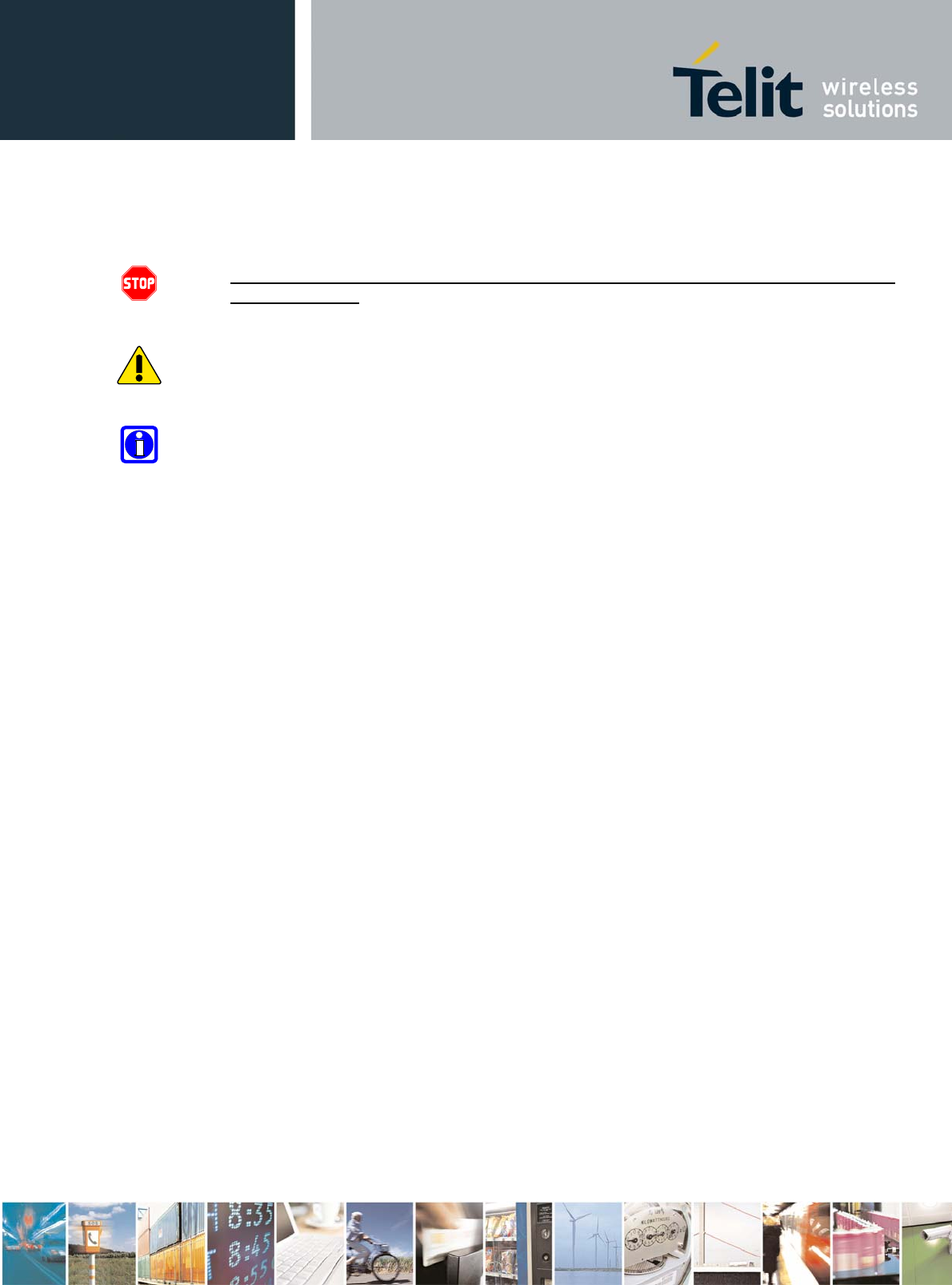
HC864-AUTO Hardware User Guide
1vv0300946 Rev.4 – 2012-12-27
Reproduction forbidden without written authorization from Telit Communications S.p.A. - All Rights
Reserved. Page 10 of 77
1.5. Text Conventions
Danger – This information MUST be followed or catastrophic equipment failure or bodily
injury may occur.
Caution or Warning – Alerts the user to important points about integrating the module, if
these points are not followed, the module and end user equipment may fail or malfunction.
Tip or Information – Provides advice and suggestions that may be useful when
integrating the module.
All dates are in ISO 8601 format, i.e. YYYY-MM-DD.
1.6. Related Documents
z HC864-AUTO Product Description, TBD
z HC864-AUTO Software User guide, 1vv0300947
z HC864-AUTO AT command reference guide, 30387NT11076A
z HC864-AUTO Digital Voice Interface Application Note, TBD
z Telit EVK2 User Guide, 1vv0300704
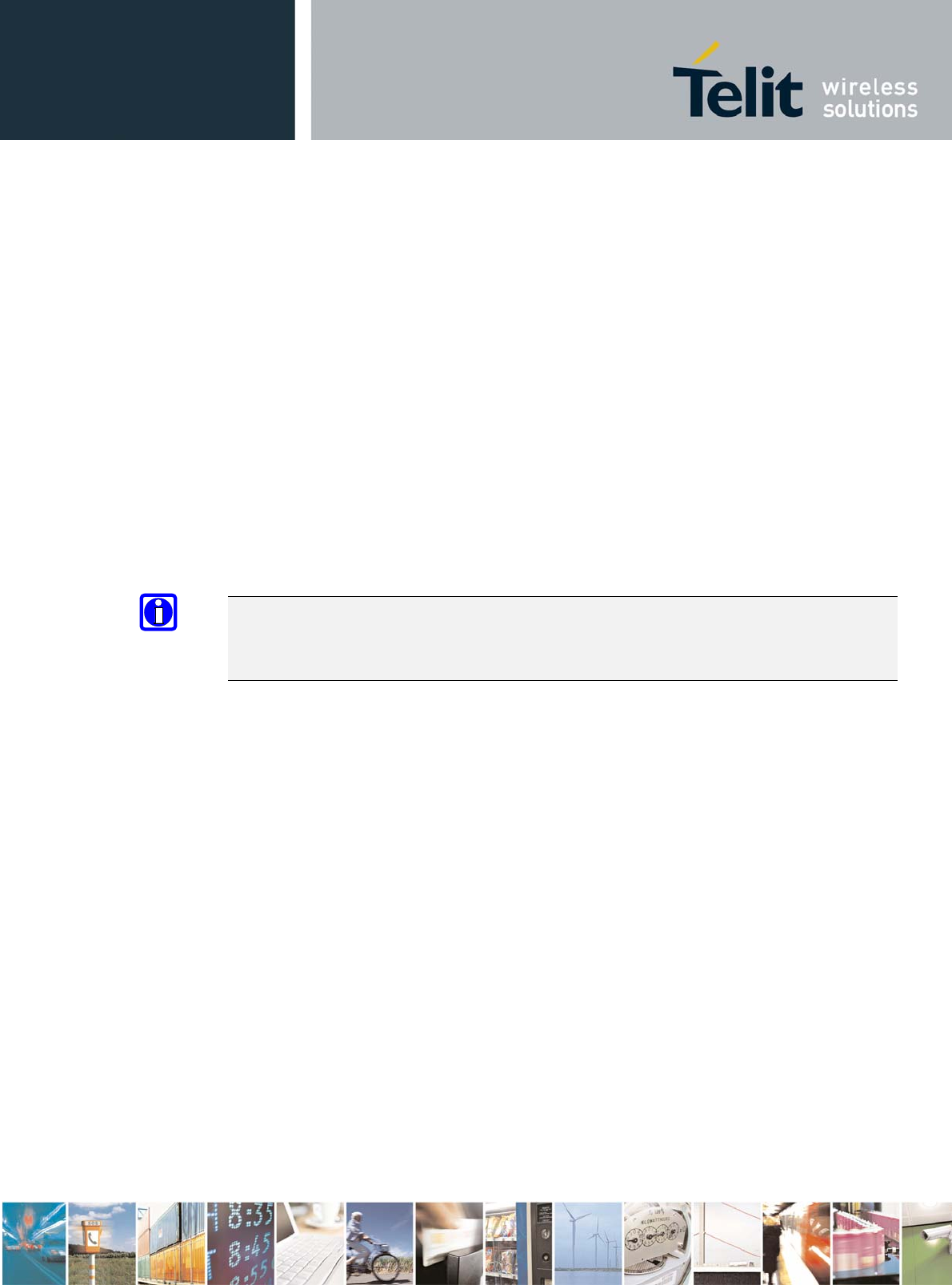
HC864-AUTO Hardware User Guide
1vv0300946 Rev.4 – 2012-12-27
Reproduction forbidden without written authorization from Telit Communications S.p.A. - All Rights
Reserved. Page 11 of 77
2. General Product Description
2.1. Overview
The aim of this document is the description of some hardware solutions useful for developing
a product with the Telit HC864-AUTO module.
In this document all the basic functions of a mobile phone will be taken into account; for each
one of them a proper hardware solution will be suggested and eventually the wrong solutions
and common errors to be avoided will be evidenced. Obviously this document cannot
embrace the whole hardware solutions and products that may be designed. The wrong
solutions to be avoided must be considered as mandatory, while the suggested hardware
configurations must not be considered mandatory, instead the information given must be used
as a guide and a starting point for properly developing your product with the Telit HC864-
AUTO module.
.
NOTICE:
The integration of the GSM/GPRS/EGPRS/WCDMA/HSPA+ HC864-AUTO cellular module
within user application must be done according to the design rules described in this manual.
The information presented in this document is believed to be accurate and reliable. However,
no responsibility is assumed by Telit Communication S.p.A. for its use, such as any
infringement of patents or other rights of third parties which may result from its use. No
license is granted by implication or otherwise under any patent rights of Telit Communication
S.p.A. other than for circuitry embodied in Telit products. This document is subject to change
without notice.
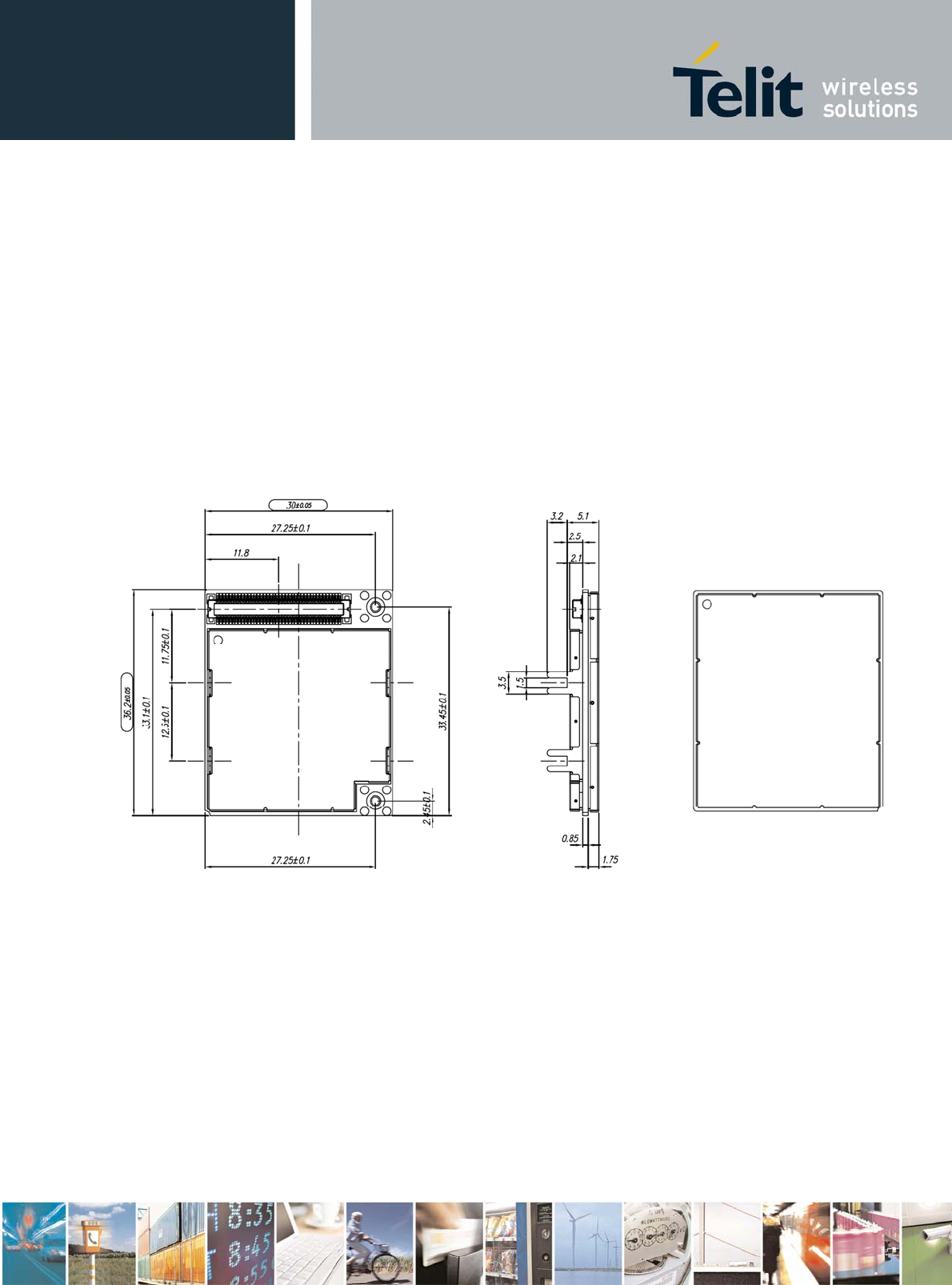
HC864-AUTO Hardware User Guide
1vv0300946 Rev.4 – 2012-12-27
Reproduction forbidden without written authorization from Telit Communications S.p.A. - All Rights
Reserved. Page 12 of 77
2.2. HC864-AUTO 2D Mechanical Dimensions
The Telit HC864-AUTO module overall dimensions are:
• Length: 36.2 mm
• Width: 30 mm
• Thickness: 5.1 mm
2.3. Weight
The module weight of HC864-AUTO is about 10.0 gram.
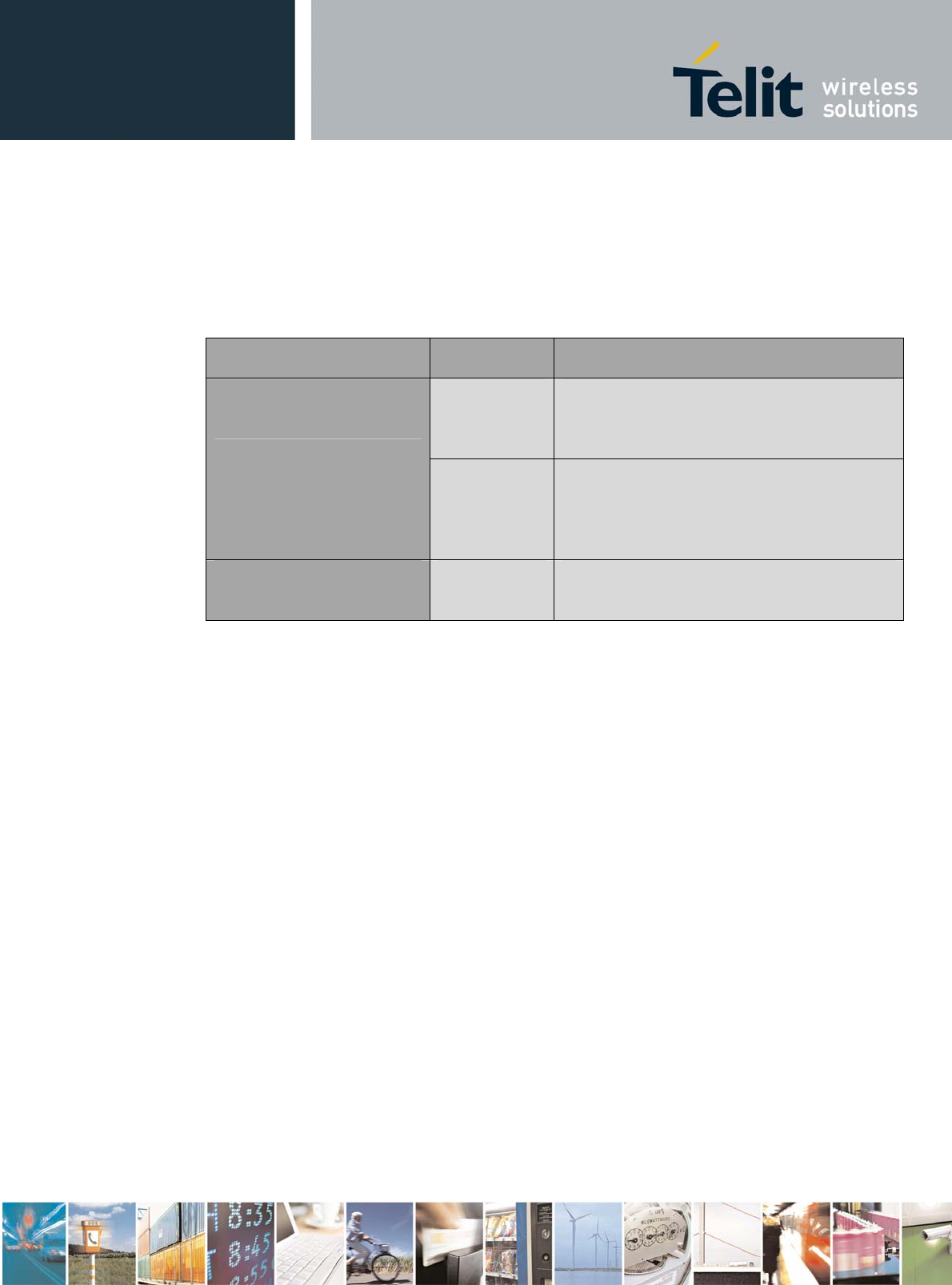
HC864-AUTO Hardware User Guide
1vv0300946 Rev.4 – 2012-12-27
Reproduction forbidden without written authorization from Telit Communications S.p.A. - All Rights
Reserved. Page 13 of 77
2.4. Environmental requirements
2.4.1. Temperature range
Note
–20°C ~ +55°C The module is fully functional(*) in all the
temperature range, and it fully meets the ETSI
specifications.
Operating Temperature
Range –30°C ~ +85°C The module is fully functional(*) in all the
temperature range. Temperatures outside of
the range –20°C ÷ +55°C might slightly
deviate from ETSI specifications.
Storage and non-operating
Temperature Range
–40°C ~ +85°C
(*)Functional: the module is able to make and receive voice calls, data calls and SMS.
2.4.2. RoHS compliance
As a part of Telit corporate policy of environmental protection, the HC864-AUTO complies
with the RoHS (Restriction of Hazardous Substances) directive of the European Union (EU
directive 2002/95/EG).
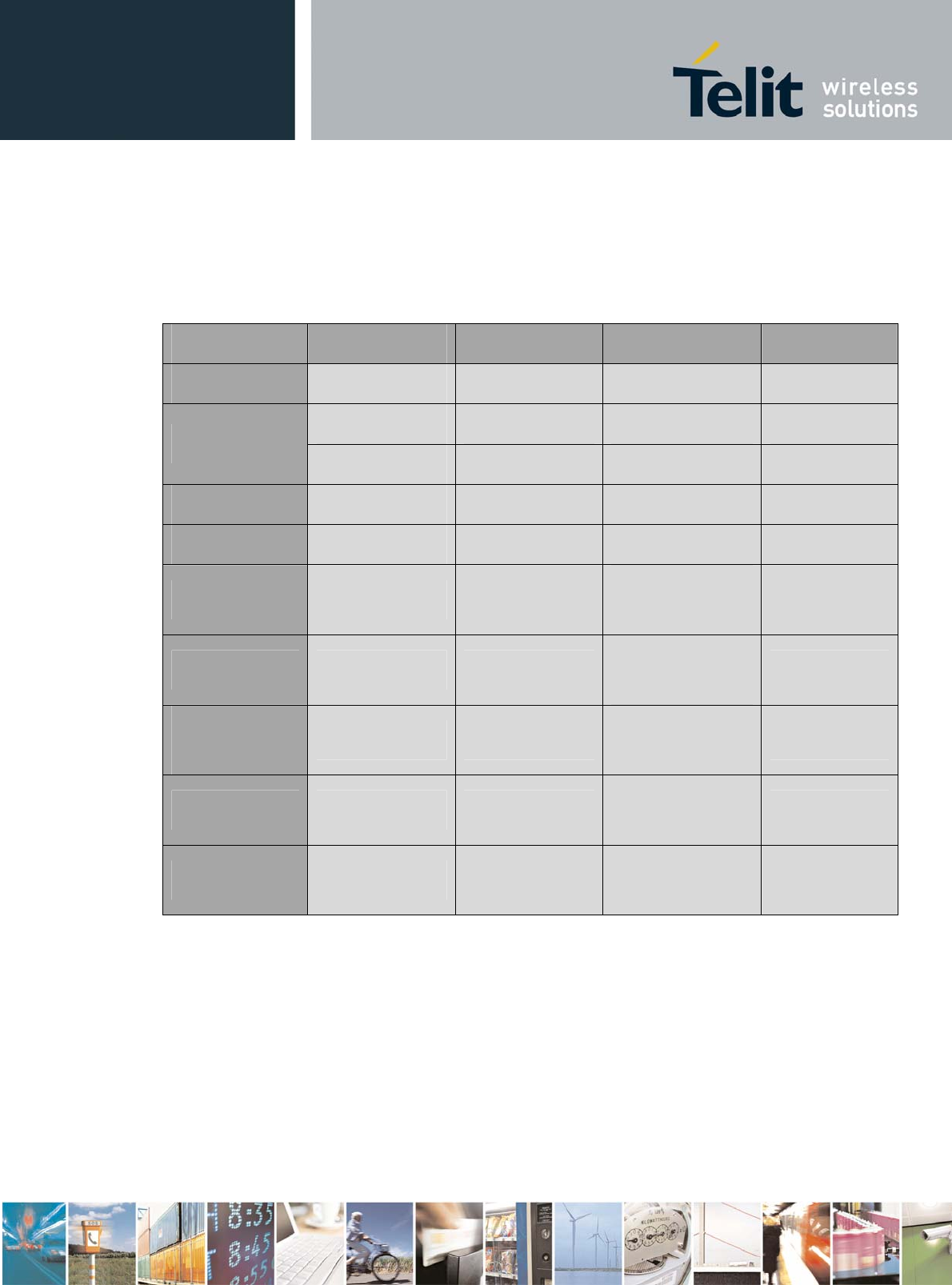
HC864-AUTO Hardware User Guide
1vv0300946 Rev.4 – 2012-12-27
Reproduction forbidden without written authorization from Telit Communications S.p.A. - All Rights
Reserved. Page 14 of 77
2.5. Operating Frequency
The operating frequencies in GSM850, EGSM900, DCS1800, PCS1900, WCDMA modes are
conformed to the 3GPP specifications.
Mode Freq. TX (MHz) Freq. RX (MHz) Channels TX - RX offset
GSM850 824.2 ~ 848.8 869.2 ~ 893.8 128 ~ 251 45 MHz
890.0 ~ 914.8 935.0 ~ 959.8 0 ~ 124 45 MHz
EGSM900
880.2 ~ 889.8 925.2 ~ 934.8 975 ~ 1023 45 MHz
DCS1800 1710.2 ~ 1784.8 1805.2 ~ 1879.8 512 ~ 885 95MHz
PCS1900 1850.2 ~ 1909.8 1930.2 ~ 1989.8 512 ~ 810 80MHz
WCDMA850 826.4 ~ 846.6 871.4 ~ 891.6 Tx: 4132 ~ 4233
Rx: 4357 ~ 4458 45MHz
WCDMA900 882.4 ~ 912.6 927.4 ~ 957.6 Tx: 2712 ~ 2863
Rx: 2937 ~ 3088 45MHz
WCDMA1700
(AWS) 1712.4 ~ 1752.6 2112.4 ~ 2152.6 Tx: 1312 ~ 1513
Rx: 1537 ~ 1738 400MHz
WCDMA1900 1852.4 ~ 1907.6 1932.4 ~ 1987.6 Tx: 9262 ~ 9538
Rx: 9662 ~ 9938 80MHz
WCDMA2100 1922.4 ~ 1977.6 2112.4 ~ 2167.6 Tx: 9612 ~ 9888
Rx: 10562 ~ 10838 190MHz
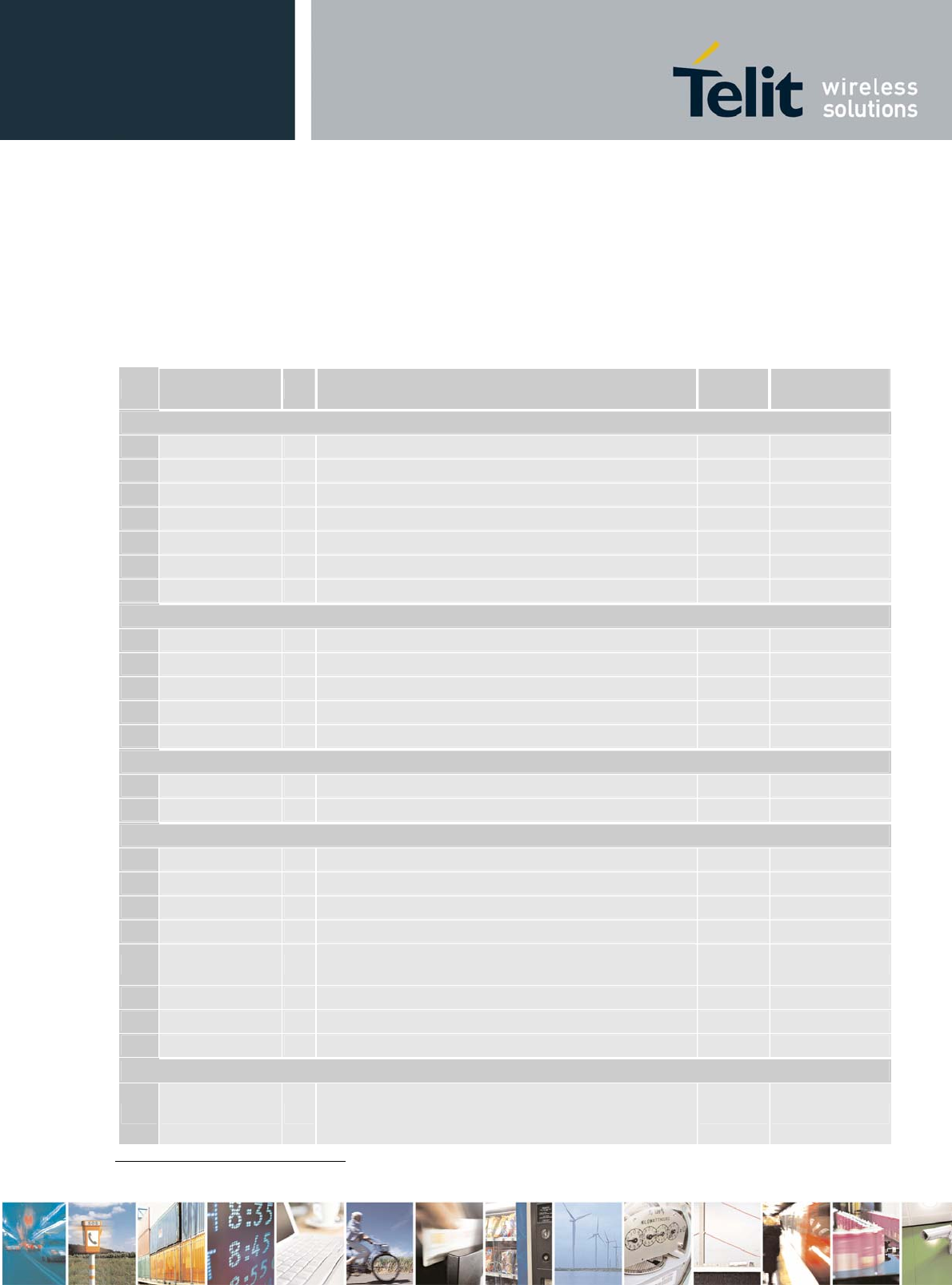
HC864-AUTO Hardware User Guide
1vv0300946 Rev.4 – 2012-12-27
Reproduction forbidden without written authorization from Telit Communications S.p.A. - All Rights
Reserved. Page 15 of 77
3. HC864-AUTO Module Connections
3.1. PIN-OUT
HC864-AUTO uses an 80 pin Molex p.n. 53949-0878 male connector for the connections
with the external applications. This connector matches the 54150-0878 models.
Pin Signal I/O Function Internal
Pull up Type
HC864-AUTO
Power Supply
1 VBATT - Main power supply Power
2 VBATT - Main power supply Power
3 VBATT - Main power supply Power
4 VBATT - Main power supply Power
5 GND - Ground Power
6 GND - Ground Power
7 GND - Ground Power
SIM Card Interface
181 SIMVCC - External SIM signal – Power supply for the SIM 1.8 / 3V
19 SIMRST O External SIM signal – Reset 1.8 / 3V
20 SIMIO I/O External SIM signal - Data I/O 1.8 / 3V
21 SIMIN I External SIM signal - Presence (active low) CMOS 1.8V
22 SIMCLK O External SIM signal – Clock 1.8 / 3V
Trace
23 RX_TRACE I RX Data for debug monitor CMOS 2.6V
24 TX_TRACE O TX Data for debug monitor CMOS 2.6V
Prog. / Data + Hw Flow Control
25 C103/TXD I Serial data input (TXD) from DTE CMOS 2.6V
26 C104/RXD O Serial data output to DTE CMOS 2.6V
27 C107/DSR O Output for Data set ready signal (DSR) to DTE CMOS 2.6V
28 C106/CTS O Output for Clear to send signal (CTS) to DTE CMOS 2.6V
29 C108/DTR I Input for Data terminal ready signal (DTR) from
DTE CMOS 2.6V
30 C125/RING O Output for Ring indicator signal (RI) to DTE CMOS 2.6V
31 C105/RTS I Input for Request to send signal (RTS) from DTE CMOS 2.6V
32 C109/DCD O Output for Data carrier detect signal (DCD) to DTE CMOS 2.6V
Miscellaneous Functions
35 USB_ID AI
Analog input used to sense whether a
peripheral device is connected, and
determine the peripheral type, a host
Analog
1 On this line a maximum of 10nF bypass capacitor is allowed
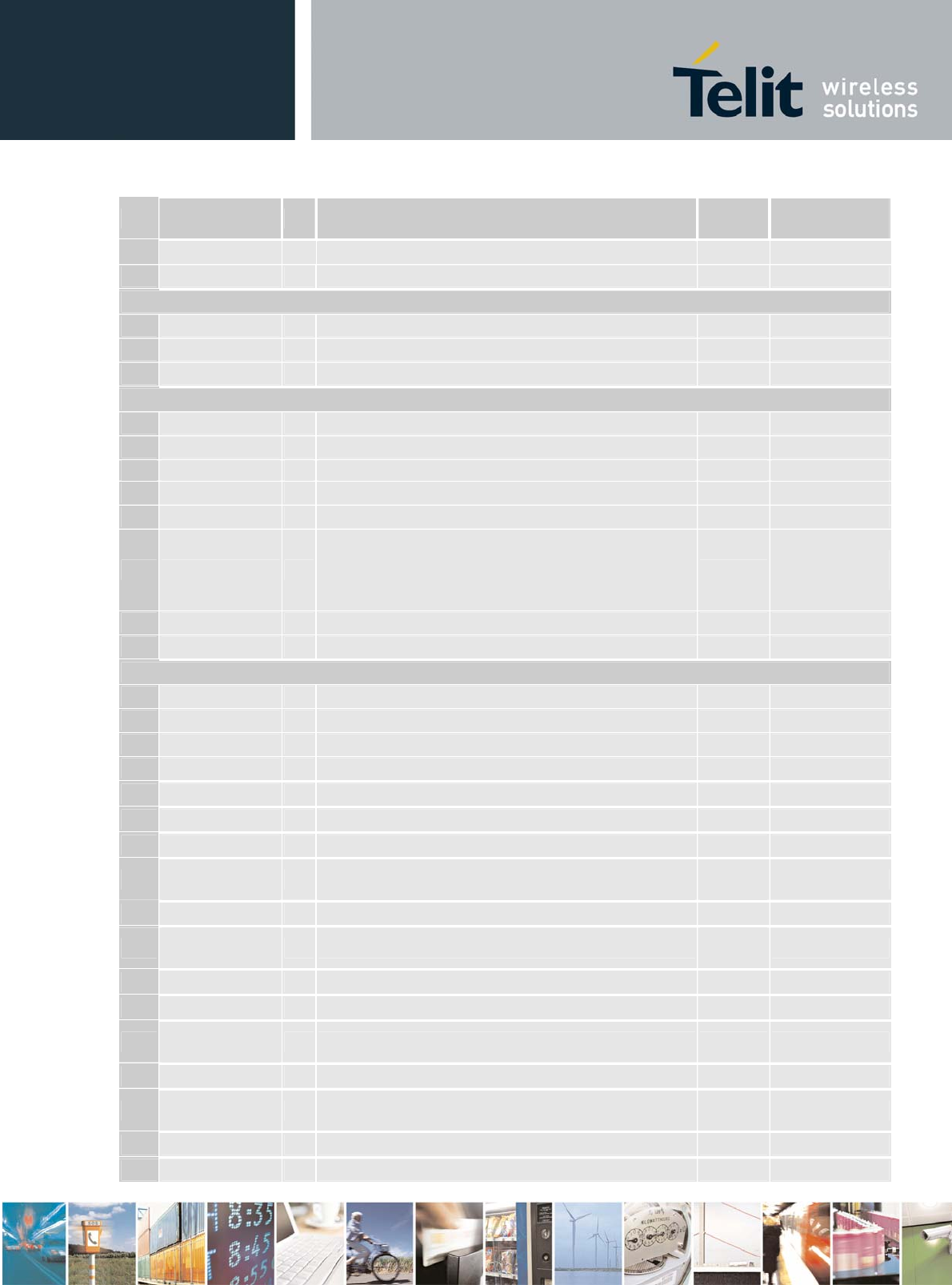
HC864-AUTO Hardware User Guide
1vv0300946 Rev.4 – 2012-12-27
Reproduction forbidden without written authorization from Telit Communications S.p.A. - All Rights
Reserved. Page 16 of 77
Pin Signal I/O Function Internal
Pull up Type
HC864-AUTO
or a peripheral
36 PCM_CLOCK I/O PCM clock out CMOS 2.6V
DAC and ADC
37 ADC_IN1 AI Analog/Digital converter input A/D
38 ADC_IN2 AI Analog/Digital converter input A/D
40 DAC_OUT AO Digital/Analog converter output D/A
Miscellaneous Functions
45 STAT_LED O Status indicator led CMOS 1.8V
46 GND - Ground Ground
48 USB_VBUS AI Power sense for the internal USB transceiver 4.4V ~5.25V
49 PWRMON O Power ON Monitor 1K
Ω
CMOS 2.6V
50 VAUX1 - Power output for external accessories
53 ON/OFF I
Input command for switching power ON or OFF
(toggle command).
The pulse to be sent to the HC864-AUTO must be
equal or greater than 1 second.
Pulled up on
chip
54 RESET I Reset input
55 VRTC AO Power supply for RTC block Power
Telit GPIOs
56 TGPIO_19 I/O Telit GPIO19 Configurable GPIO CMOS 1.8V
57 TGPIO_11 I/O Telit GPIO11 Configurable GPIO CMOS 1.8V
58 TGPIO_20 I/O Telit GPIO20 Configurable GPIO CMOS 1.8V
59 TGPIO_04 I/O Telit GPIO4 Configurable GPIO CMOS 1.8V
60 TGPIO_14 I/O Telit GPIO14 Configurable GPIO CMOS 1.8V
61 TGPIO_15 I/O Telit GPIO15 Configurable GPIO CMOS 1.8V
62 TGPIO_12 I/O Telit GPIO12 Configurable GPIO CMOS 1.8V
63 TGPIO_10/
PCM_TX I/O Telit GPIO10 Configurable GPIO / PCM Data
Output
Pull
Down CMOS 2.6V
64 TGPIO_22 I/O Telit GPIO22 Configurable GPIO CMOS 1.8V
65 TGPIO_18/
PCM_RX I/O Telit GPIO18 Configurable GPIO / PCM Data input Pull
Down CMOS 2.6V
66 TGPIO_03 I/O Telit GPIO3 Configurable GPIO CMOS 1.8V
67 TGPIO_08 I/O Telit GPIO8 Configurable GPIO CMOS 1.8V
68 TGPIO_06 /
ALARM I/O Telit GPIO6 Configurable GPIO / ALARM CMOS 1.8V
70 TGPIO_01 I/O Telit GPIO1 Configurable GPIO CMOS 1.8V
71 TGPIO_17/
PCM_SYNC I/O Telit GPIO17 Configurable GPIO / PCM Sync Pull
Down CMOS 2.6V
72 TGPIO_21 I/O Telit GPIO21 Configurable GPIO CMOS 1.8V
73 TGPIO_07 I/O Telit GPIO7 Configurable GPIO CMOS 1.8V
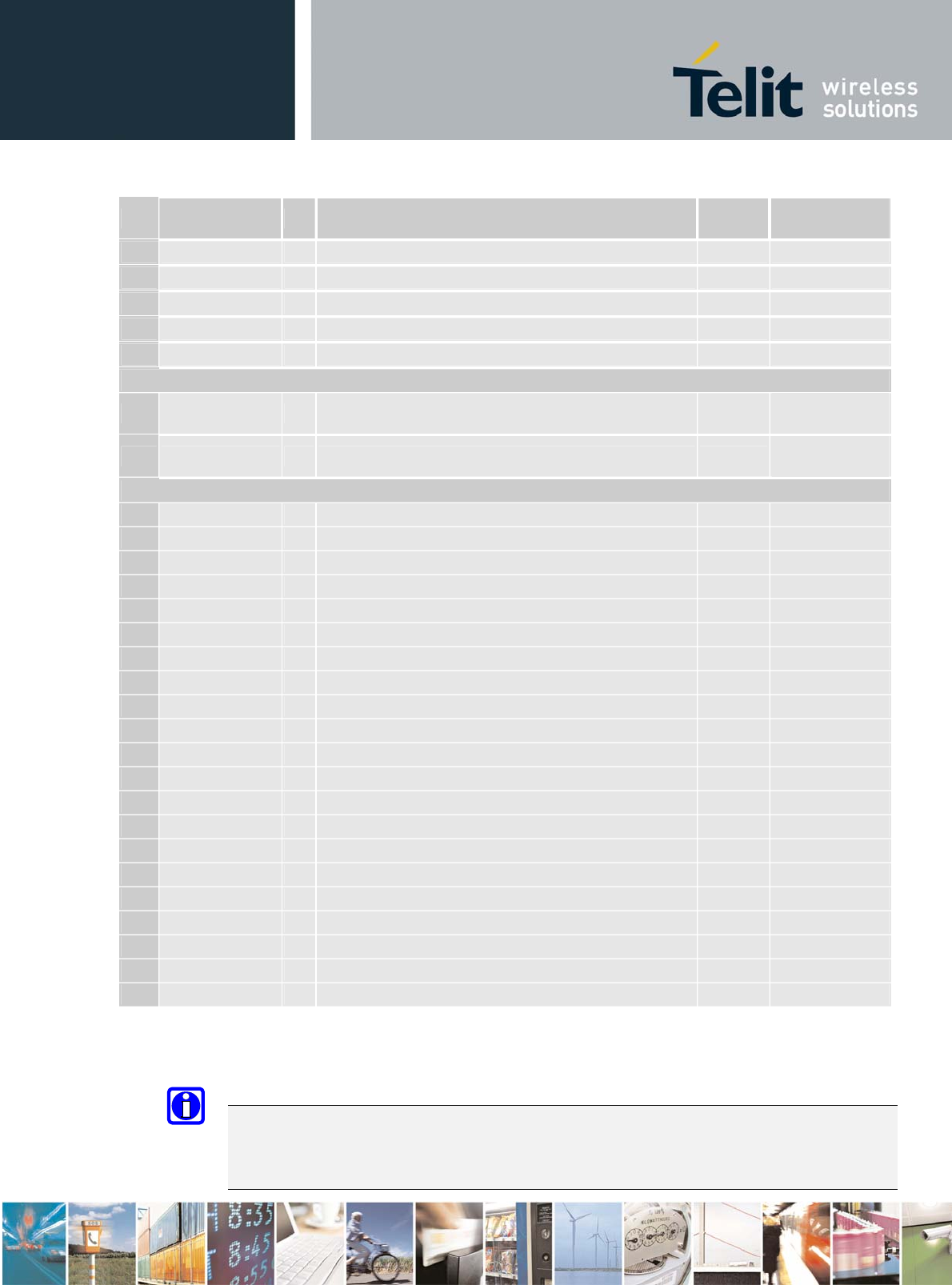
HC864-AUTO Hardware User Guide
1vv0300946 Rev.4 – 2012-12-27
Reproduction forbidden without written authorization from Telit Communications S.p.A. - All Rights
Reserved. Page 17 of 77
Pin Signal I/O Function Internal
Pull up Type
HC864-AUTO
74 TGPIO_02 I/O Telit GPIO02 I/O pin CMOS 1.8V
75 TGPIO_16 I/O Telit GPIO16 Configurable GPIO CMOS 1.8V
76 TGPIO_09 I/O Telit GPIO9 Configurable GPIO CMOS 1.8V
77 TGPIO_13 I/O Telit GPIO13 Configurable CMOS 1.8V
78 TGPIO_05 I/O Telit GPIO05 Configurable GPIO CMOS 2.6V
USB Interface
79 USB_D+ I/O USB differential Data (+) 3.0V
~3.6V
80 USB_D- I/O USB differential Data (-) 3.0V
~3.6V
RESERVED
8 -
9
10
11 -
12 -
13 -
14 -
15 -
16 -
17 -
33
34
39 -
41 -
42 -
43 -
44 -
47 -
51
52
69
NOTE:
DTR pin must be connected in order to enter HC864-AUTO’s power saving mode.
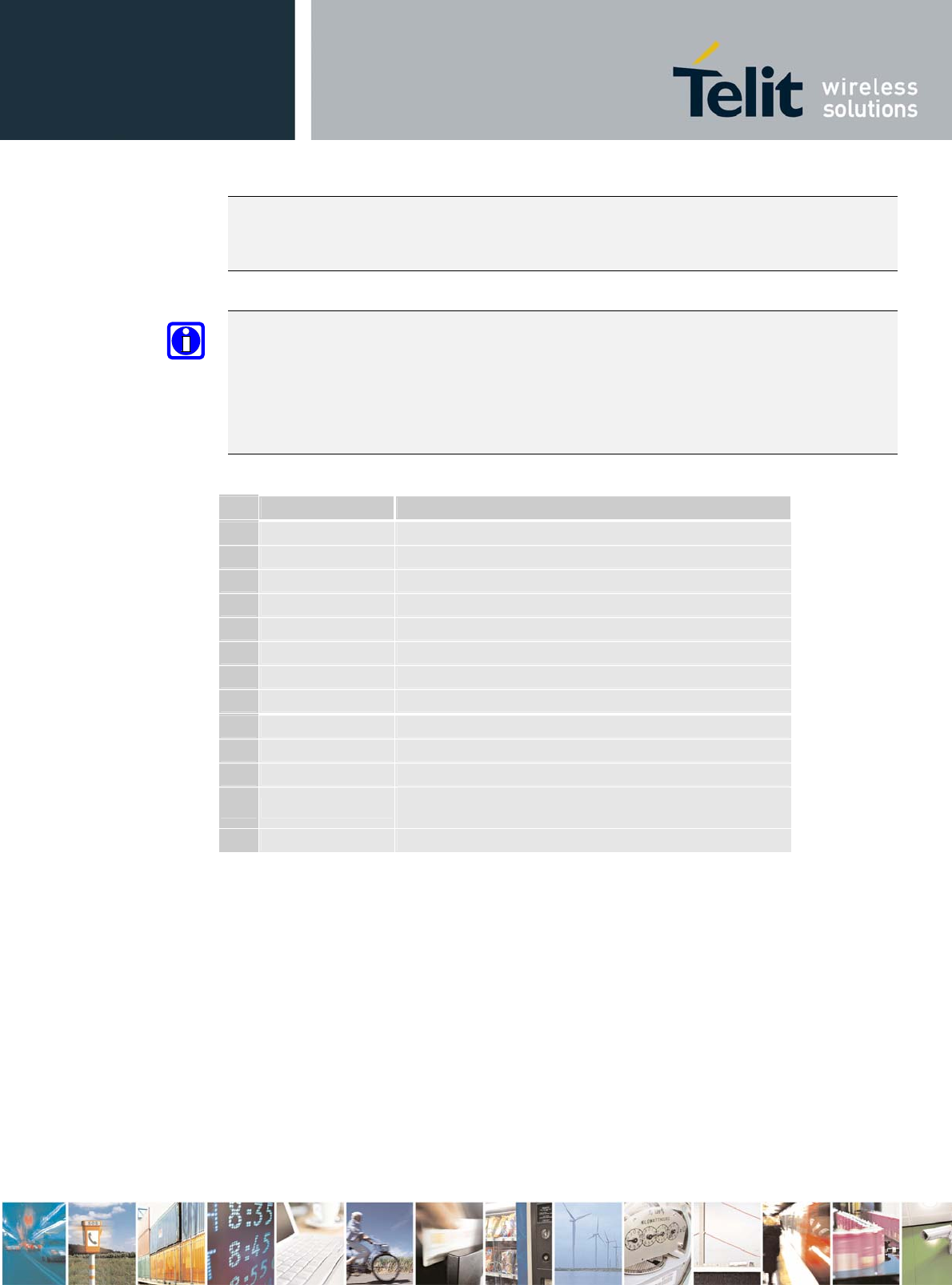
HC864-AUTO Hardware User Guide
1vv0300946 Rev.4 – 2012-12-27
Reproduction forbidden without written authorization from Telit Communications S.p.A. - All Rights
Reserved. Page 18 of 77
NOTE:
RI pin must be connected in order to wake up the host when a call is coming in sleep mode of
host.
NOTE:
RESERVED pins must not be connected
RTS must be connected to the GND (on the module side) if flow control is not used
NOTE:
If not used, almost all pins must be left disconnected. The only exceptions are the following:
Pin Signal Function
1 VBATT Main power supply
2 VBATT Main power supply
3 VBATT Main power supply
4 VBATT Main power supply
5 GND Ground
6 GND Ground
7 GND Ground
46 GND Ground
25 C103/TXD Serial data input (TXD) from DTE
26 C104/RXD Serial data output to DTE
31 C105/RTS Input for Request to send signal (RTS) from DTE
53 ON/OFF Input command for switching power ON or OFF
(toggle command).
54 RESET Reset input
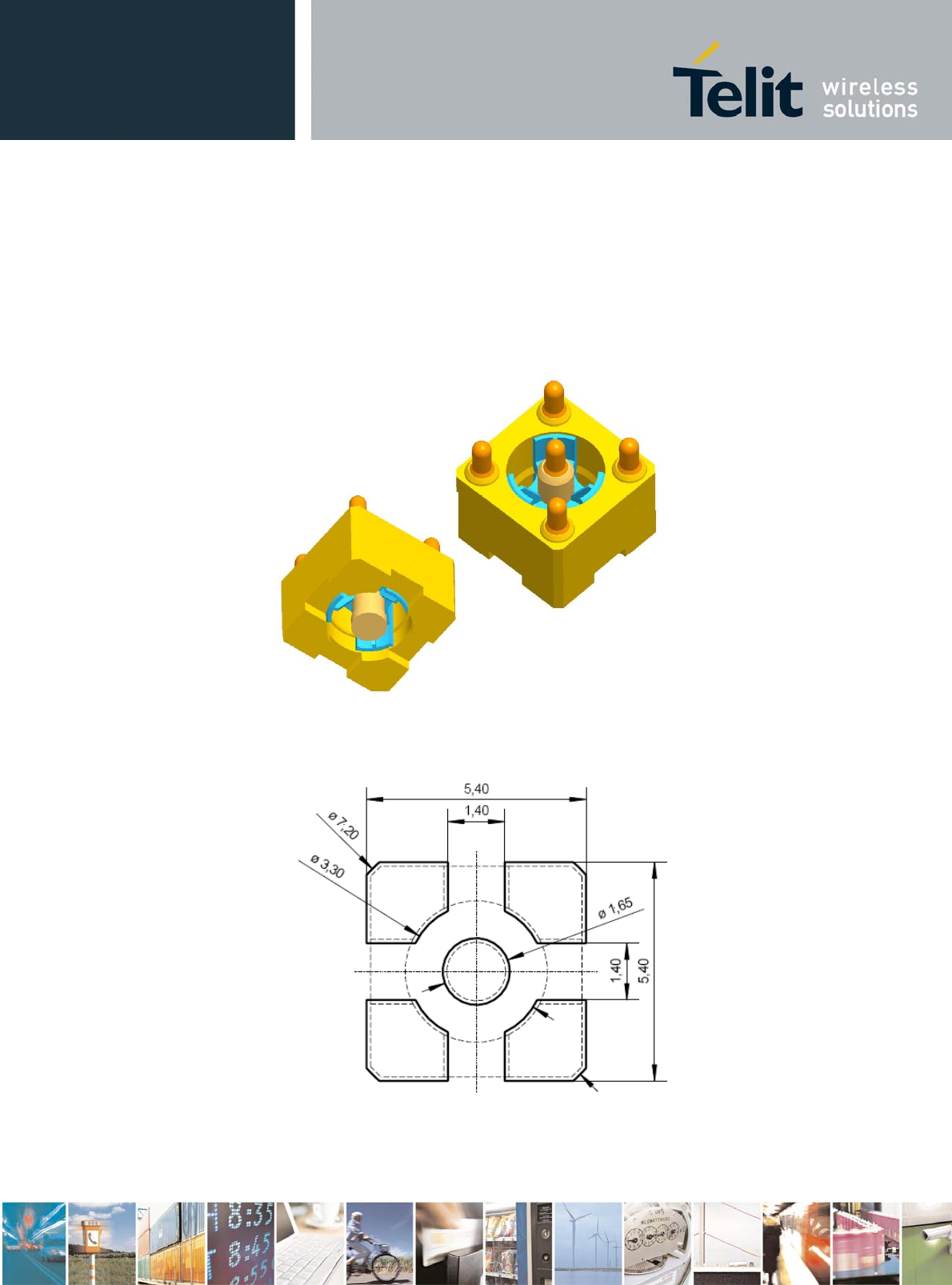
HC864-AUTO Hardware User Guide
1vv0300946 Rev.4 – 2012-12-27
Reproduction forbidden without written authorization from Telit Communications S.p.A. - All Rights
Reserved. Page 19 of 77
3.2. Antenna Connector(s)
The HC864-AUTO module is designed with a 50 Ohm RF PAD that permits to interface it
with an application equipped by a Rosenberger coaxial Board to board connector.
Furthermore the HC864-AUTO is designed with an additional RF PAD for GPS/Diversity
antenna connection. The counterpart suitable is a Rosenberger 99CI106-030L5.
Suggested footprint on the application side:
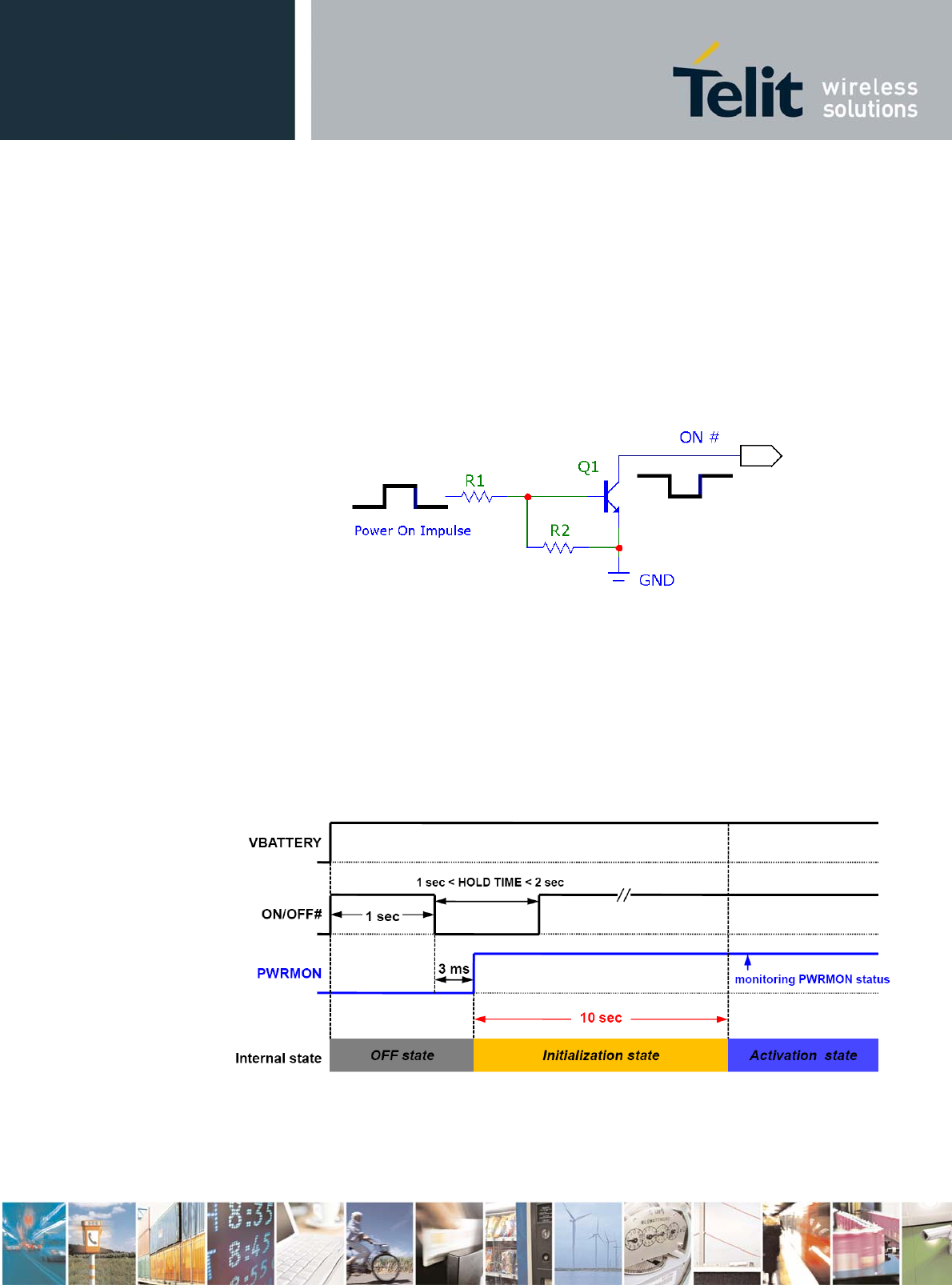
HC864-AUTO Hardware User Guide
1vv0300946 Rev.4 – 2012-12-27
Reproduction forbidden without written authorization from Telit Communications S.p.A. - All Rights
Reserved. Page 20 of 77
4. Hardware Commands
4.1. Turning ON the HC864-AUTO
To turn on HC864-AUTO, the pad ON# must be tied low for at least 1 second and then
released.
The maximum current that can be drained from the ON# pad is 0.1 mA.
A simple circuit to do it is:
4.2. Initialization and Activation state
Upon turning on HC864-AUTO, HC864-AUTO is not activated yet because the boot
sequence of HC864-AUTO is still going on internally. It takes about 10 seconds to complete
the initializing the module internally.
For this reason, it would be useless to try to access HC864-AUTO during a Initialization state
as below. To get the desirable stability, HC864-AUTO needs at least 10 seconds after the
PWRMON goes High.
During the Initialization state, any kind of AT-command is not available. DTE must be
waiting for the Activation state to communicate with HC864-AUTO.
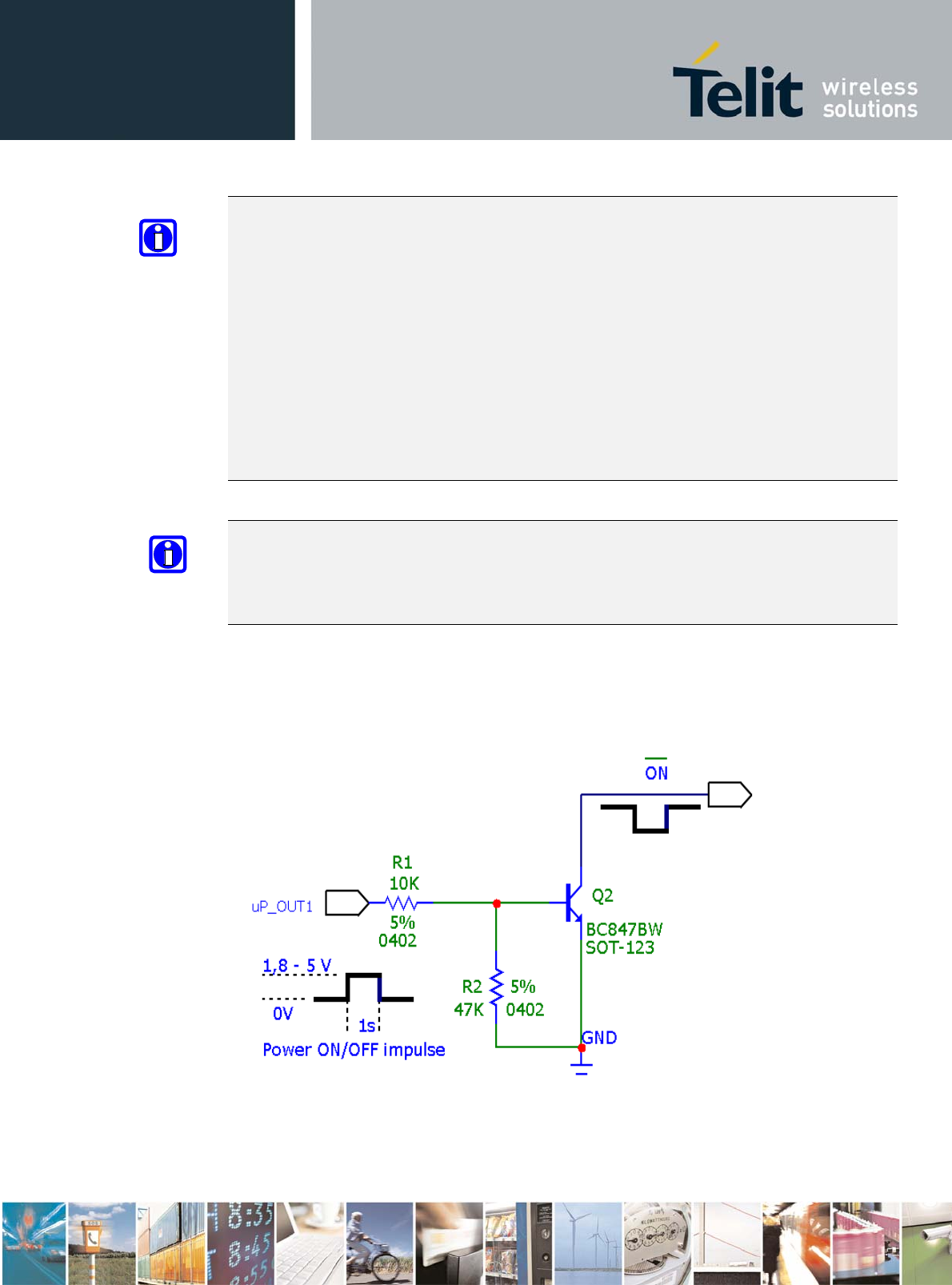
HC864-AUTO Hardware User Guide
1vv0300946 Rev.4 – 2012-12-27
Reproduction forbidden without written authorization from Telit Communications S.p.A. - All Rights
Reserved. Page 21 of 77
NOTE:
To check if the HC864-AUTO has powered on, the hardware line PWRMON must be
monitored. When PWRMON goes high, the module has powered on.
NOTE:
Do not use any pull up resistor on the ON# line, it is internally pulled up. Using pull up
resistor may bring to latch up problems on the HC864-AUTO power regulator and improper
power on/off of the module. The line ON# must be connected only in open collector
configuration.
NOTE:
In this document all the lines are inverted. Active low signals are labeled with a name that
ends with a "#" or with a bar over the name.
NOTE:
In order to avoid a back powering effect it is recommended to avoid having any HIGH logic
level signal applied to the digital pins of the module when is powered OFF or during an
ON/OFF transition.
For example:
1- Let us assume you need to drive the ON# pad with a totem pole output of a +1.8/5 V
microcontroller (uP_OUT1):
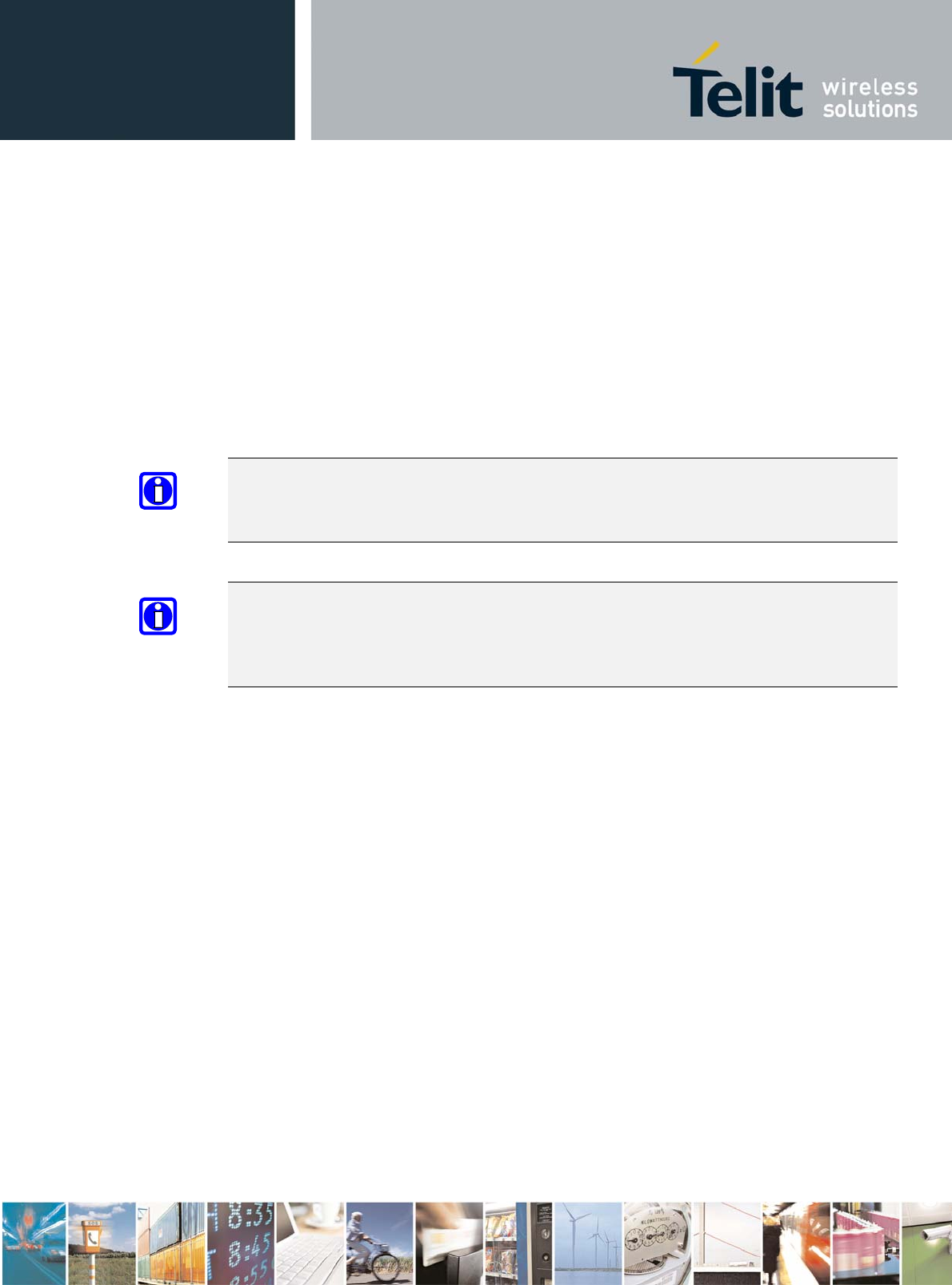
HC864-AUTO Hardware User Guide
1vv0300946 Rev.4 – 2012-12-27
Reproduction forbidden without written authorization from Telit Communications S.p.A. - All Rights
Reserved. Page 22 of 77
4.3. Turning OFF the HC864-AUTO
Turning off the device can be done in three ways:
• by software command (see HC864-AUTO Software User Guide)
• by Hardware shutdown
• by Hardware Unconditional Restart
When the device is shut down by software command or by hardware shutdown, it issues to
the network a detach request that informs the network that the device will not be reachable
any more.
TIP:
To check if the device has powered off, hardware line PWRMON must be monitored. When
PWRMON goes low it can be considered the device has powered off.
NOTE:
In order to avoid a back powering effect it is recommended to avoid having any HIGH logic
level signal applied to the digital pins of the module when is powered OFF or during an
ON/OFF transition.
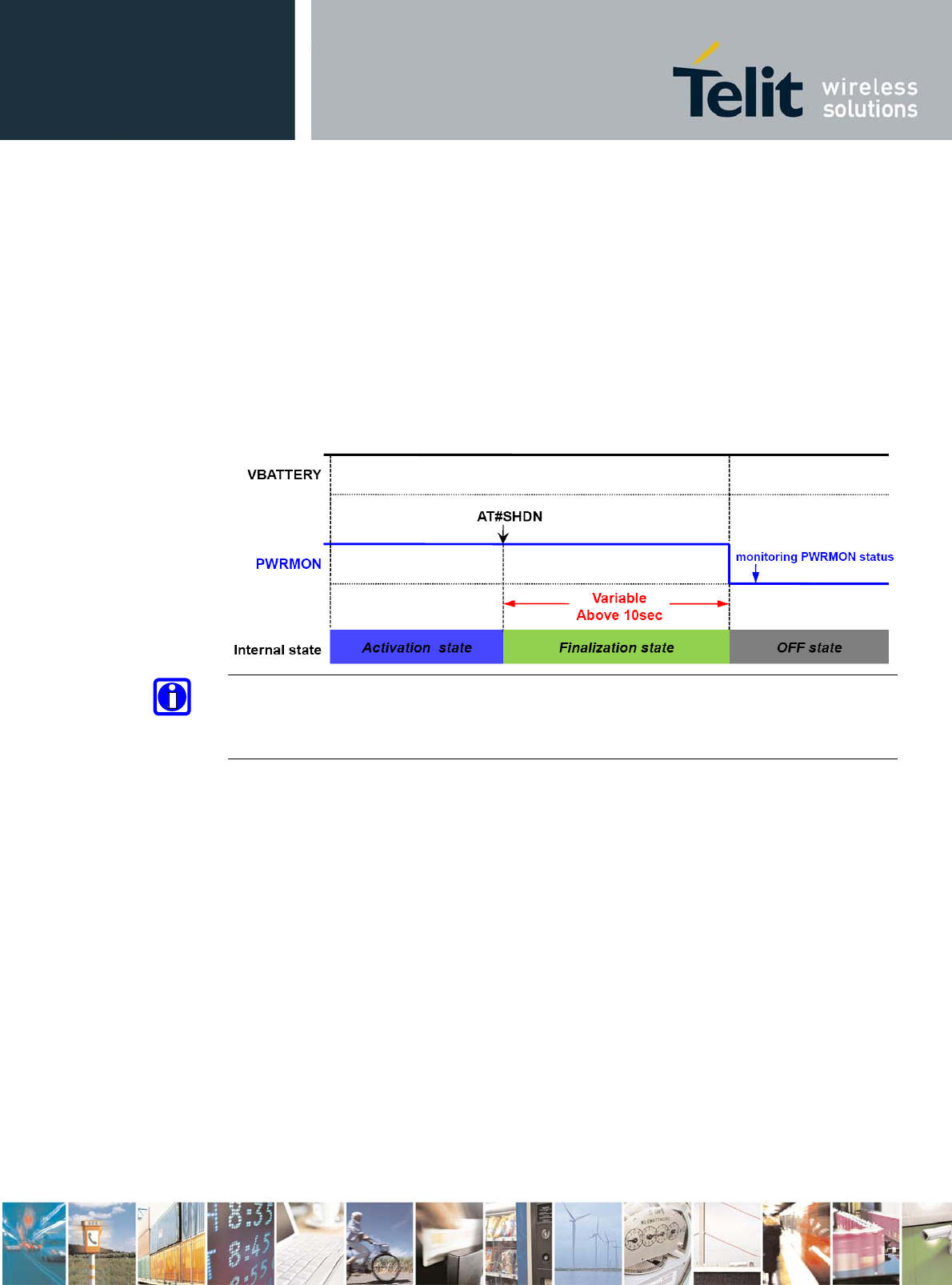
HC864-AUTO Hardware User Guide
1vv0300946 Rev.4 – 2012-12-27
Reproduction forbidden without written authorization from Telit Communications S.p.A. - All Rights
Reserved. Page 23 of 77
4.3.1. Shutdown by Software Command
HC864-AUTO can be shut down by a software command.
When a shut down command is sent, HC864-AUTO goes into the finalization state and finally
will shut down PWRMON at the end of this state.
The period of the finalization state can differ according to the situation in which the HC864-
AUTO is so it cannot be fixed definitely.
Normally it will be above 10 seconds later from sending a shut down command and DTE
should monitor the status of PWRMON to see the actual power off.
TIP:
To check if the device has powered off, hardware line PWRMON must be monitored. When
PWRMON goes low, the device has powered off.
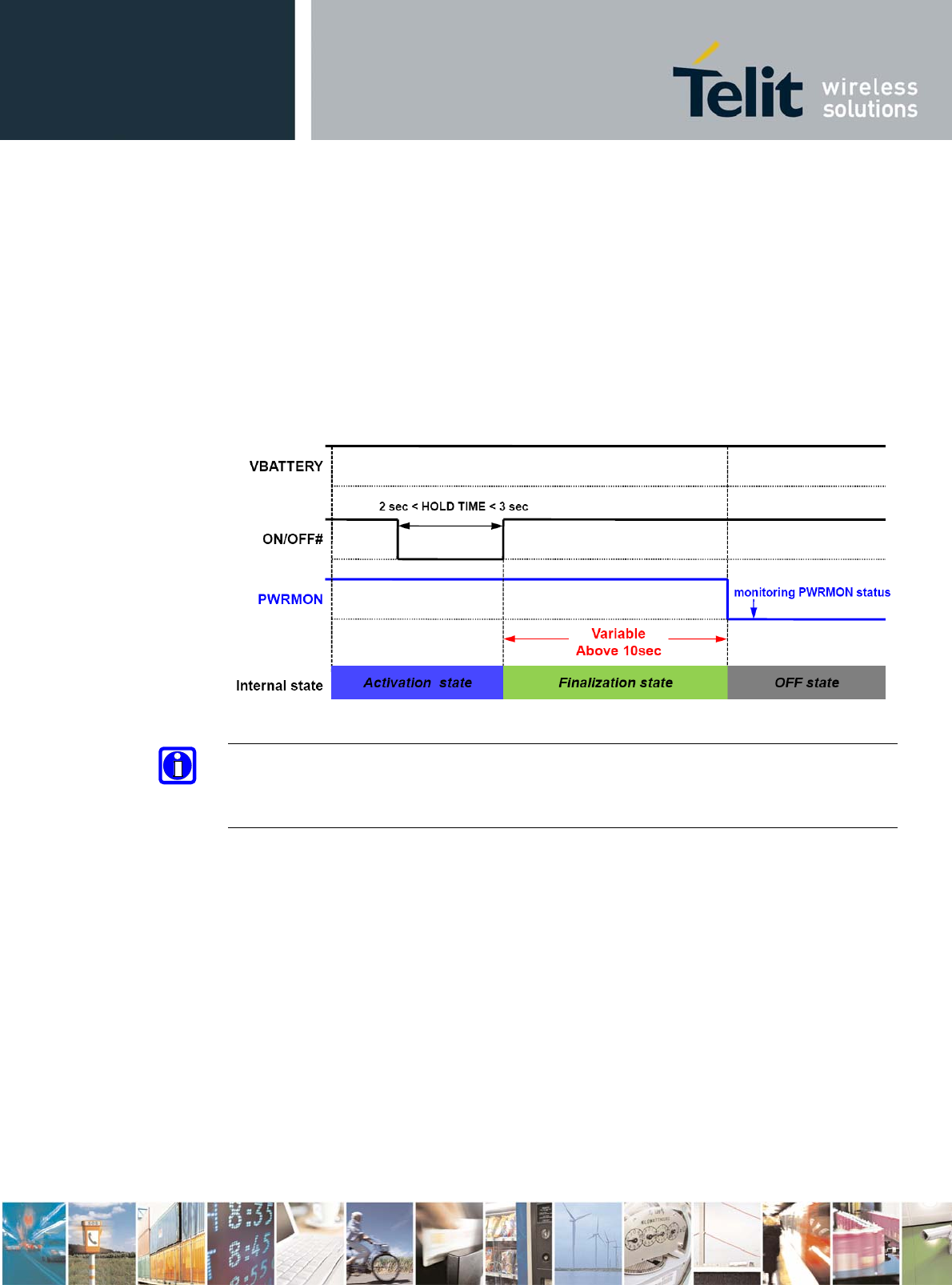
HC864-AUTO Hardware User Guide
1vv0300946 Rev.4 – 2012-12-27
Reproduction forbidden without written authorization from Telit Communications S.p.A. - All Rights
Reserved. Page 24 of 77
4.3.2. Hardware Shutdown
To turn OFF HC864-AUTO the pad ON/OFF# must be tied low for at least 2 seconds and
then released. Same circuitry and timing for the power on must be used.
When the hold time of ON/OFF# is above 2 seconds, HC864-AUTO goes into the finalization
state and finally will shut down PWRMON at the end of this state.
The period of the finalization state can differ according to the situation in which the HC864-
AUTO is so it cannot be fixed definitely.
Normally it will be above 10 seconds later from releasing ON/OFF# and DTE should monitor
the status of PWRMON to see the actual power off.
TIP:
To check if the device has powered off, hardware line PWRMON must be monitored. When
PWRMON goes low, the device has powered off.
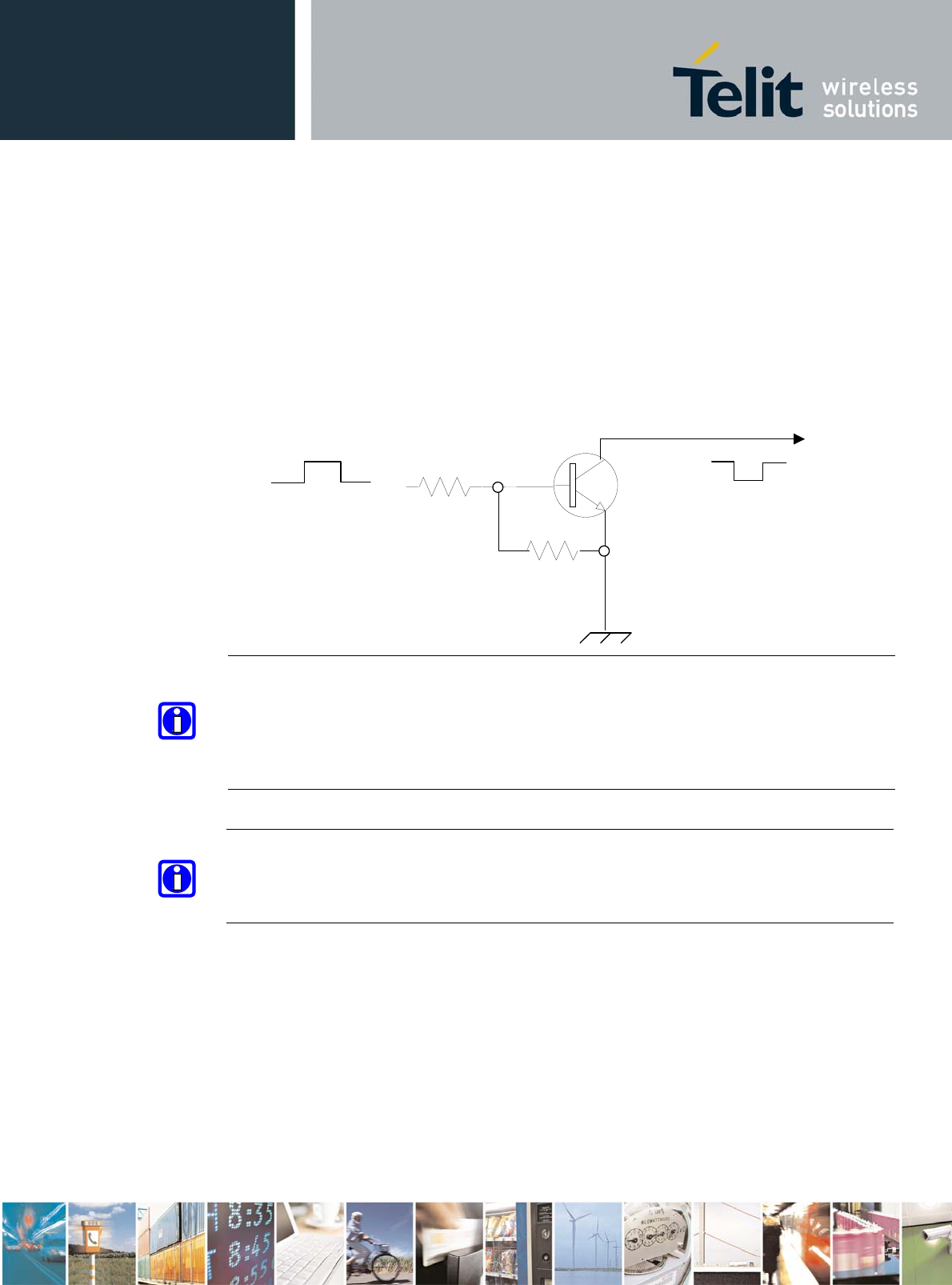
HC864-AUTO Hardware User Guide
1vv0300946 Rev.4 – 2012-12-27
Reproduction forbidden without written authorization from Telit Communications S.p.A. - All Rights
Reserved. Page 25 of 77
4.3.3. Hardware Unconditional Restart
To unconditionally restart HC864-AUTO, the pad RESET# must be tied low for at least 200
milliseconds and then released.
A simple circuit to do it is:
For example:
NOTE:
Do not use any pull up resistor on the RESET# line or any totem pole digital output. Using
pull up resistor may bring to latch up problems on the HC864-AUTO power regulator and
improper functioning of the module. The line RESET# must be connected only in open
collector configuration.
TIP:
The unconditional hardware Restart must always be implemented on the boards and the
software must use it as an emergency exit procedure.
RESET#
Unconditional Restart
impulse
GND
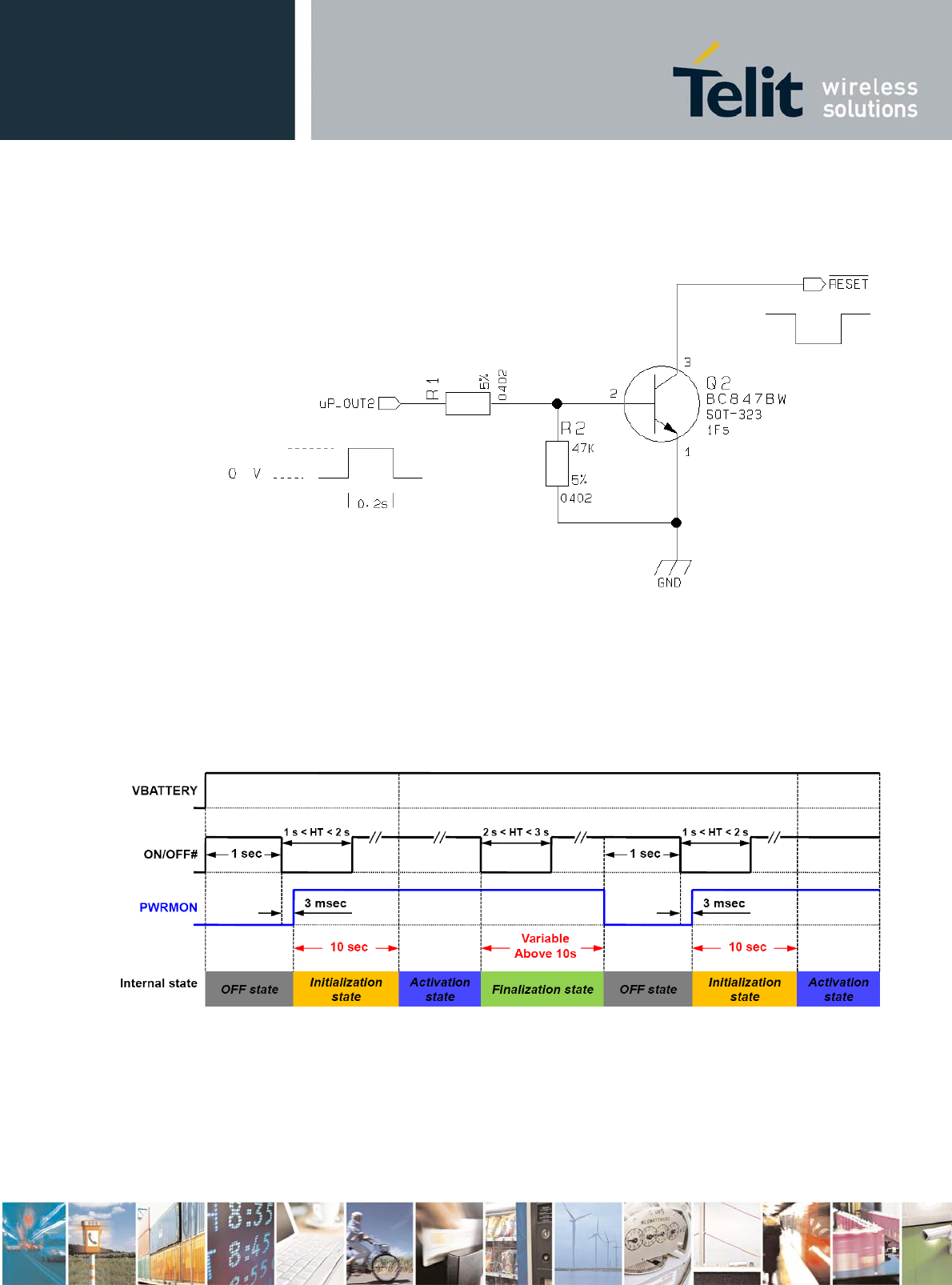
HC864-AUTO Hardware User Guide
1vv0300946 Rev.4 – 2012-12-27
Reproduction forbidden without written authorization from Telit Communications S.p.A. - All Rights
Reserved. Page 26 of 77
1- Let us assume you need to drive the RESET# pad with a totem pole output of a +1.8/5 V
microcontroller (uP_OUT2):
4.4. Summary of Turning ON and OFF the module
Below chart describes the overall sequences for Turning ON and OFF.
10k
+1.8 / 5V
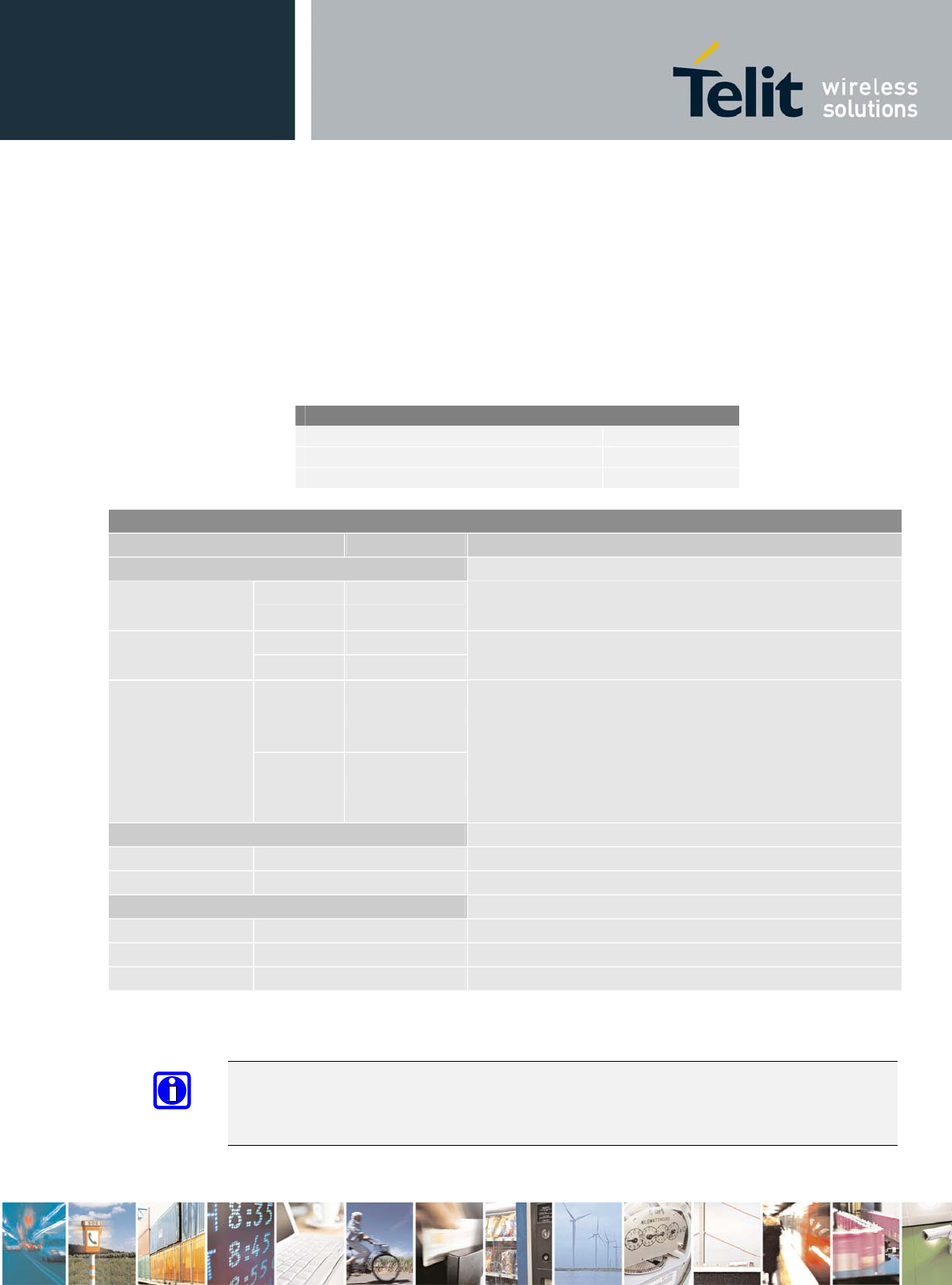
HC864-AUTO Hardware User Guide
1vv0300946 Rev.4 – 2012-12-27
Reproduction forbidden without written authorization from Telit Communications S.p.A. - All Rights
Reserved. Page 27 of 77
5. Power Supply
The power supply circuitry and board layout are a very important part in the full product
design and they strongly reflect on the product overall performances. Read carefully the
requirements and the guidelines that will follow for a proper design.
5.1. Power Supply Requirements
The HC864-AUTO power requirements are:
Power Supply
Nominal Supply Voltage 3.8V
Max Supply Voltage 4.2V
Supply Voltage Range 3.4V – 4.2V
HC864-AUTO
Mode Average(mA) Mode Description
IDLE mode Standby mode; no call in progress
WCDMA 15.0
AT+CFUN=1 GSM 15.0 Normal mode; full functionality of the module
WCDMA 13.0
AT+CFUN=4 GSM 13.0
Disabled TX and RX; modules is not registered on the
network
WCDMA 2.7/1.0*
AT+CFUN=0 or
AT+CFUN=5
GSM 3.2/1.3*
Power saving; CFUN=0 module registered on the
network and can receive voice call or an SMS; but it is
not possible to send AT commands; module wakes up with
an unsolicited code (call or SMS) or rising RTS line.
CFN=5 full functionality with power saving;
Module registered on the network can receive
incoming call sand SMS
WCDMA TX and RX mode
WCDMA Voice 630 WCDMA voice channel
HSPA 640 HSPA data channel
GSM TX and RX mode
GSM Voice 260 GSM voice channel
GPRS Class33 680 GPRS data channel
EDGE Class33 380 EDGE data channel
* Worst/best case depends on network configuration and is not under module control.
TIP:
The electrical design for the Power supply must be made ensuring that it will be capable of a
peak current output of at least 2A.
In GSM/GPRS mode, RF transmission is not continuous and it is packed into bursts at a base
frequency of about 216 Hz, and the relative current peaks can be as high as about 2A.

HC864-AUTO Hardware User Guide
1vv0300946 Rev.4 – 2012-12-27
Reproduction forbidden without written authorization from Telit Communications S.p.A. - All Rights
Reserved. Page 28 of 77
Therefore the power supply has to be designed in order to withstand these current peaks
without big voltage drops; this means that both the electrical design and the board layout must
be designed for this current flow. If the layout of the PCB is not well designed, a strong noise
floor is generated on the ground; this will reflect on all the audio paths producing an audible
annoying noise at 216 Hz; if the voltage drops during the peak, current absorption is too much.
The device may even shut down as a consequence of the supply voltage drop.

HC864-AUTO Hardware User Guide
1vv0300946 Rev.4 – 2012-12-27
Reproduction forbidden without written authorization from Telit Communications S.p.A. - All Rights
Reserved. Page 29 of 77
5.2. General Design Rules
The principal guidelines for the Power Supply Design embrace three different design steps:
• the electrical design
• the thermal design
• the PCB layout
5.2.1. Electrical Design Guidelines
The electrical design of the power supply depends strongly on the power source where this
power is drained. We will distinguish them into three categories:
• +5V input (typically PC internal regulator output)
• +12V input (typically automotive)
• battery
5.2.1.1. + 5V Input Source Power Supply Design Guidelines
• The desired output for the power supply is 3.8V, hence there is not a big
difference between the input source and the desired output and a linear regulator
can be used. A switching power supply will not be suited because of the low
drop-out requirements.
• When using a linear regulator, a proper heat sink must be provided in order to
dissipate the power generated.
• A Bypass low ESR capacitor of adequate capacity must be provided in order to
cut the current absorption peaks close to HC864-AUTO, a 100F tantalum
capacitor is usually suited.
• Make sure the low ESR capacitor on the power supply output (usually a tantalum
one) is rated at least 10V.
• A protection diode must be inserted close to the power input, in order to save
HC864-AUTO from power polarity inversion.
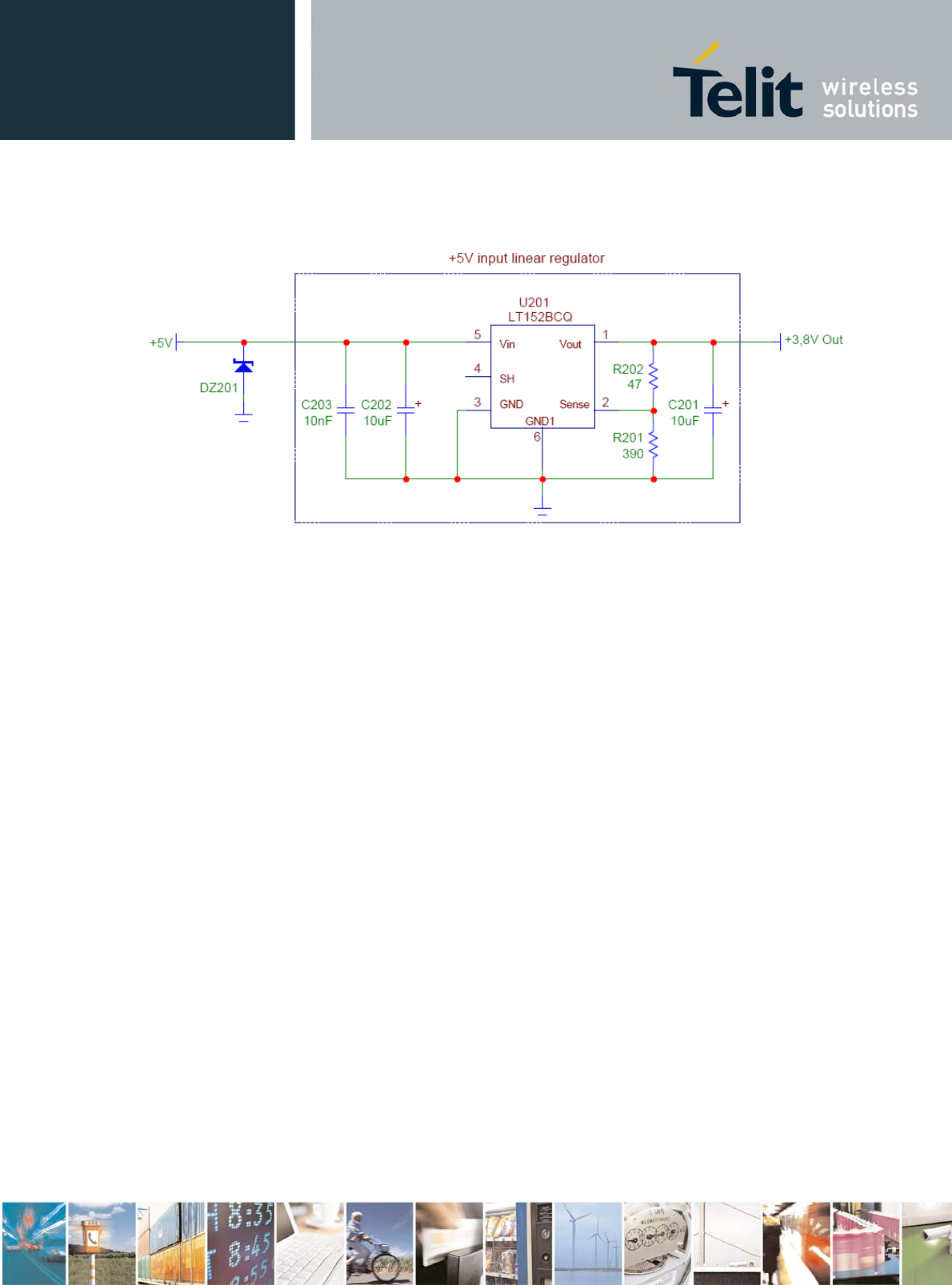
HC864-AUTO Hardware User Guide
1vv0300946 Rev.4 – 2012-12-27
Reproduction forbidden without written authorization from Telit Communications S.p.A. - All Rights
Reserved. Page 30 of 77
An example of linear regulator with 5V input is:
5.2.1.2. + 12V Input Source Power Supply Design Guidelines
• The desired output for the power supply is 3.8V, hence due to the big difference
between the input source and the desired output, a linear regulator is not suited
and must not be used. A switching power supply will be preferable because of its
better efficiency especially with the 2A peak current load represented by HC864-
AUTO.
• When using a switching regulator, a 500kHz or more switching frequency
regulator is preferable because of its smaller inductor size and its faster transient
response. This allows the regulator to respond quickly to the current peaks
absorption.
• In any case, the frequency and Switching design selection is related to the
application to be developed due to the fact the switching frequency could also
generate EMC interferences.
• For car PB battery the input voltage can rise up to 15.8V and this must be kept in
mind when choosing components: all components in the power supply must
withstand this voltage.
• A Bypass low ESR capacitor of adequate capacity must be provided in order to
cut the current absorption peaks. A 100F tantalum capacitor is usually suited for
this.
• Make sure the low ESR capacitor on the power supply output (usually a tantalum
one) is rated at least 10V.
• For Car applications a spike protection diode must be inserted close to the power
input, in order to clean the supply from spikes.
• A protection diode must be inserted close to the power input, in order to save
HC864-AUTO from power polarity inversion. This can be the same diode as for
spike protection.
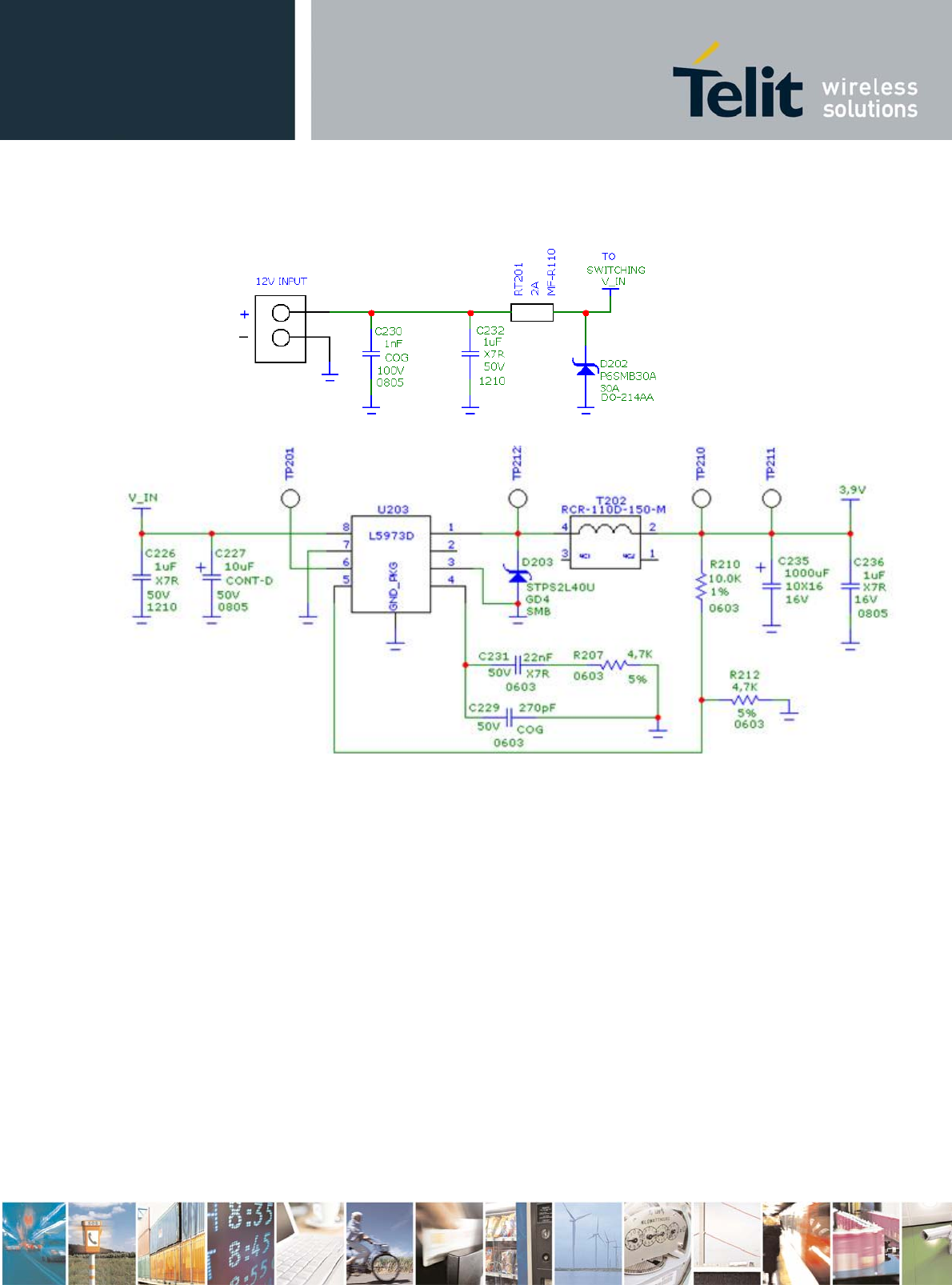
HC864-AUTO Hardware User Guide
1vv0300946 Rev.4 – 2012-12-27
Reproduction forbidden without written authorization from Telit Communications S.p.A. - All Rights
Reserved. Page 31 of 77
An example of switching regulator with 12V input is in the below schematic (it is split in 2
parts):
Switching regulator
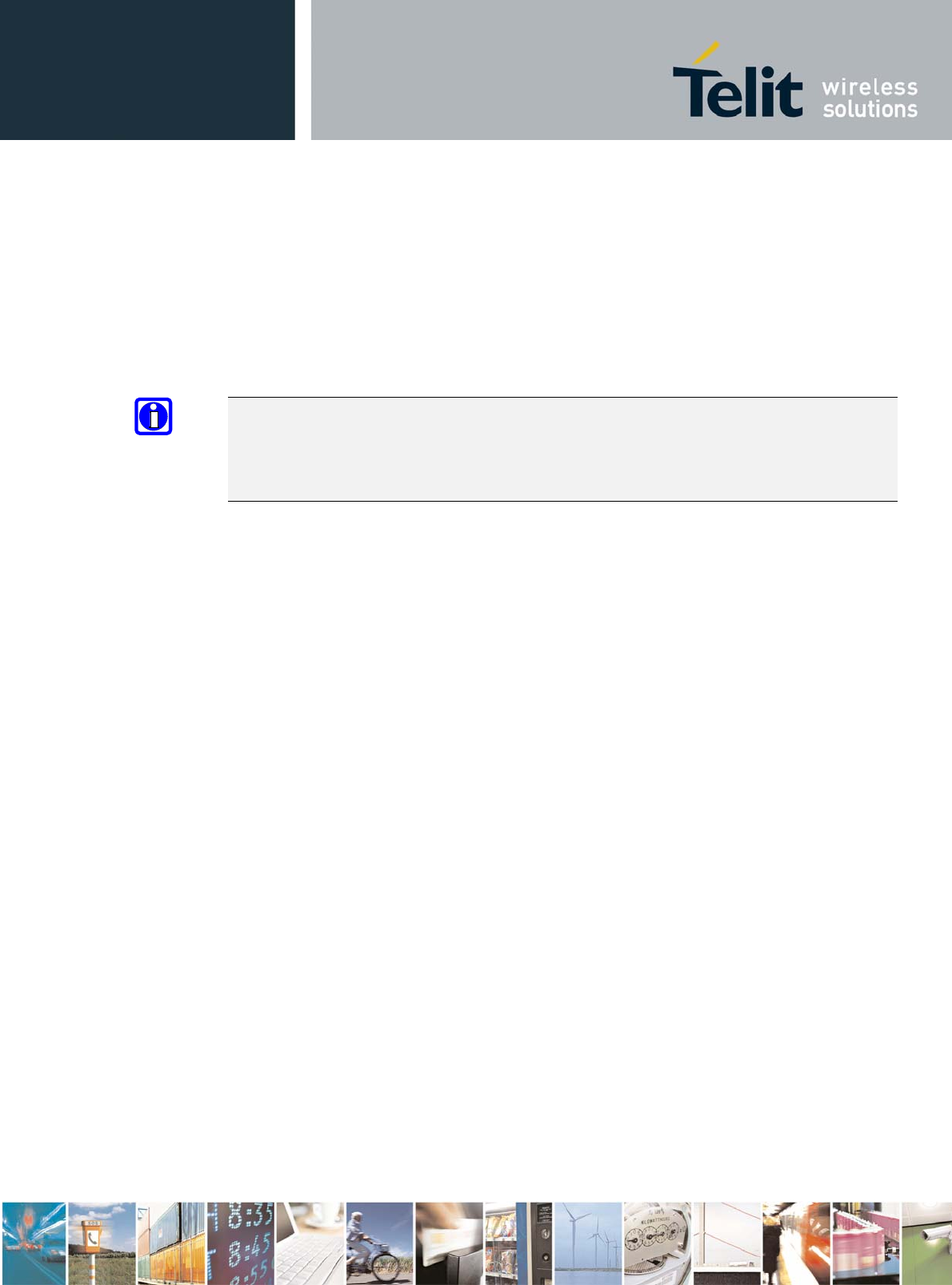
HC864-AUTO Hardware User Guide
1vv0300946 Rev.4 – 2012-12-27
Reproduction forbidden without written authorization from Telit Communications S.p.A. - All Rights
Reserved. Page 32 of 77
5.2.1.3. Battery Source Power Supply Design Guidelines
• The desired nominal output for the power supply is 3.8V and the maximum
allowed voltage is 4.2V, hence a single 3.7V Li-Ion cell battery type is suited for
supplying the power to the Telit HC864-AUTO module. The three cells Ni/Cd or
Ni/MH 3.6 V Nom. battery types or 4V PB types must not be used directly since
their maximum voltage can rise over the absolute maximum voltage for HC864-
AUTO and damage it.
NOTE:
Do not use any Ni-Cd, Ni-MH, and Pb battery types directly connected with HC864-AUTO.
Their use can lead to overvoltage on HC864-AUTO and damage it. Use only Li-Ion battery
types.
• A Bypass low ESR capacitor of adequate capacity must be provided in order to
cut the current absorption peaks, a 100F tantalum capacitor is usually suited.
• Make sure the low ESR capacitor (usually a tantalum one) is rated at least 10V.
• A protection diode must be inserted close to the power input, in order to save
HC864-AUTO from power polarity inversion. Otherwise the battery connector
must be done in a way to avoid polarity inversions when connecting the battery.
• The battery capacity must be at least 500mAh in order to withstand the current
peaks of 2A; the suggested capacity is from 500mAh to 1000mAh.
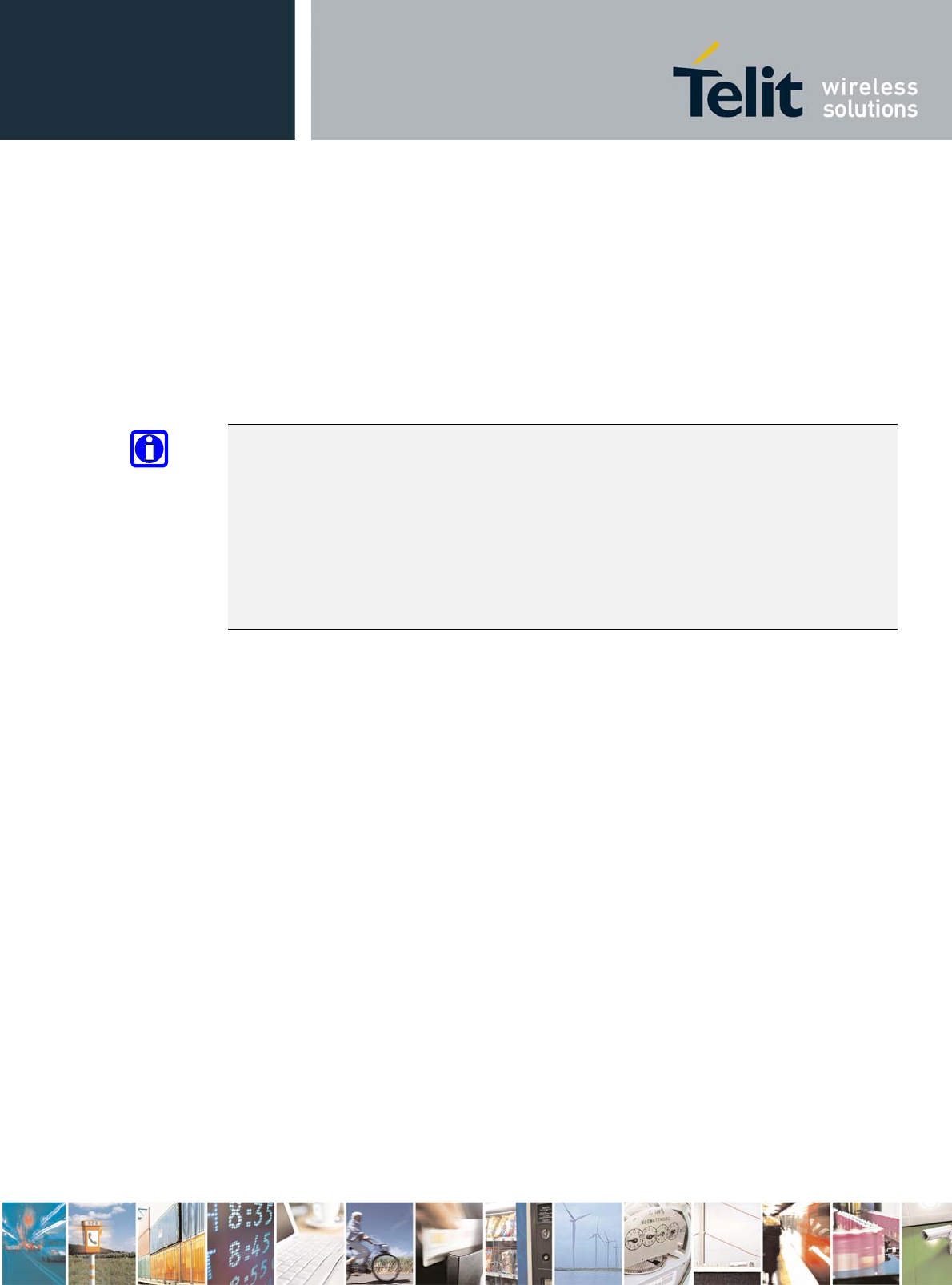
HC864-AUTO Hardware User Guide
1vv0300946 Rev.4 – 2012-12-27
Reproduction forbidden without written authorization from Telit Communications S.p.A. - All Rights
Reserved. Page 33 of 77
5.2.2. Thermal Design Guidelines
The thermal design for the power supply heat sink must be done with the following
specifications:
• Average current consumption during HSPA transmission @PWR level max in
HC864-AUTO : 640mA
• Average current consumption during class33 GPRS transmission @PWR level
max: 680mA
• Average GPS current during GPS ON (Power Saving disabled) : 65mA
NOTE:
The average consumption during transmissions depends on the power level at which the
device is requested to transmit via the network. The average current consumption hence varies
significantly.
NOTE:
The thermal design for the Power supply must be made keeping an average consumption at
the max transmitting level during calls of 640mA(HSPA)/680mA(GPRS) rms plus 65mA rms
for GPS in tracking mode.
Considering the very low current during idle, especially if Power Saving function is enabled,
it is possible to consider from the thermal point of view that the device absorbs current
significantly only during calls.
If we assume that the device stays in transmission for short periods of time (let us say few
minutes) and then remains for quite a long time in idle (let us say one hour), then the power
supply has always the time to cool down between the calls and the heat sink could be smaller
than the calculated for 640mA (HSPA)/680mA (GPRS) maximum RMS current. There could
even be a simple chip package (no heat sink).
Moreover in average network conditions the device is requested to transmit at a lower power
level than the maximum and hence the current consumption will be less than 640mA (HSPA)
/680mA (GPRS) (being usually around 250mA).
For these reasons the thermal design is rarely a concern and the simple ground plane where
the power supply chip is placed can be enough to ensure a good thermal condition and avoid
overheating.
For the heat generated by the HC864-AUTO, you can consider it to be during transmission
2W max during class33 GPRS upload. This generated heat will be mostly conducted to the
ground plane under the HC864-AUTO; you must ensure that your application can dissipate
heat.
In the WCDMA/HSPA mode, since HC864-AUTO emits RF signals continuously during
transmission, you must pay special attention how to dissipate the heat generated.
The current consumption will be up to about 640mA in HSPA (630mA in WCDMA)
continuously at the maximum TX output power (23dBm). Thus, you must arrange the PCB
area as large as possible under HC864-AUTO which you will mount. You must mount

HC864-AUTO Hardware User Guide
1vv0300946 Rev.4 – 2012-12-27
Reproduction forbidden without written authorization from Telit Communications S.p.A. - All Rights
Reserved. Page 34 of 77
HC864-AUTO on the large ground area of your application board and make many ground
vias to dissipate the heat.
The peak current consumption in the GSM mode is higher than that in WCDMA. However,
considering the heat sink is more important in case of WCDMA.
As mentioned before, a GSM signal is bursty, thus, the temperature drift is more insensible
than WCDMA. Consequently, if you prescribe the heat dissipation in the WCDMA mode,
you don’t need to think more about the GSM mode.
5.2.3. Power Supply PCB Layout Guidelines
As seen in the electrical design guidelines, the power supply must have a low ESR capacitor
on the output to cut the current peaks and a protection diode on the input to protect the supply
from spikes and polarity inversion. The placement of these components is crucial for the
correct working of the circuitry. A misplaced component can be useless or can even decrease
the power supply performances.
• The Bypass low ESR capacitor must be placed close to the Telit HC864-AUTO
power input pads, or in the case the power supply is a switching type, it can be
placed close to the inductor to cut the ripple if the PCB trace from the capacitor to
HC864-AUTO is wide enough to ensure a drop-less connection even during the
2A current peaks.
• The protection diode must be placed close to the input connector where the power
source is drained.
• The PCB traces from the input connector to the power regulator. IC must be wide
enough to ensure no voltage drops to occur when the 2A current peaks are
absorbed. Note that this is not made in order to save power loss but especially to
avoid the voltage drops on the power line at the current peaks frequency of 216
Hz that will reflect on all the components connected to that supply (also
introducing the noise floor at the burst base frequency.) For this reason while a
voltage drop of 300-400 mV may be acceptable from the power loss point of
view, the same voltage drop may not be acceptable from the noise point of view.
If your application does not have audio interface but only uses the data feature of
the Telit HC864-AUTO, then this noise is not so disturbing and power supply
layout design can be more forgiving.
• The PCB traces to HC864-AUTO and the Bypass capacitor must be wide enough
to ensure no significant voltage drops to occur when the 2A current peaks are
absorbed. This is a must for the same above-mentioned reasons. Try to keep this
trace as short as possible.
• The PCB traces connecting the Switching output to the inductor and the
switching diode must be kept as short as possible by placing the inductor and the
diode very close to the power switching IC (only for switching power supply).
This is done in order to reduce the radiated field (noise) at the switching
frequency (usually 100-500 kHz).
• The use of a good common ground plane is suggested.
• The placement of the power supply on the board must be done in a way to
guarantee that the high current return paths in the ground plane are not

HC864-AUTO Hardware User Guide
1vv0300946 Rev.4 – 2012-12-27
Reproduction forbidden without written authorization from Telit Communications S.p.A. - All Rights
Reserved. Page 35 of 77
overlapped to any noise sensitive circuitry as the microphone amplifier/buffer or
earphone amplifier.
• The power supply input cables must be kept separately from noise sensitive lines
such as microphone/earphone cables.
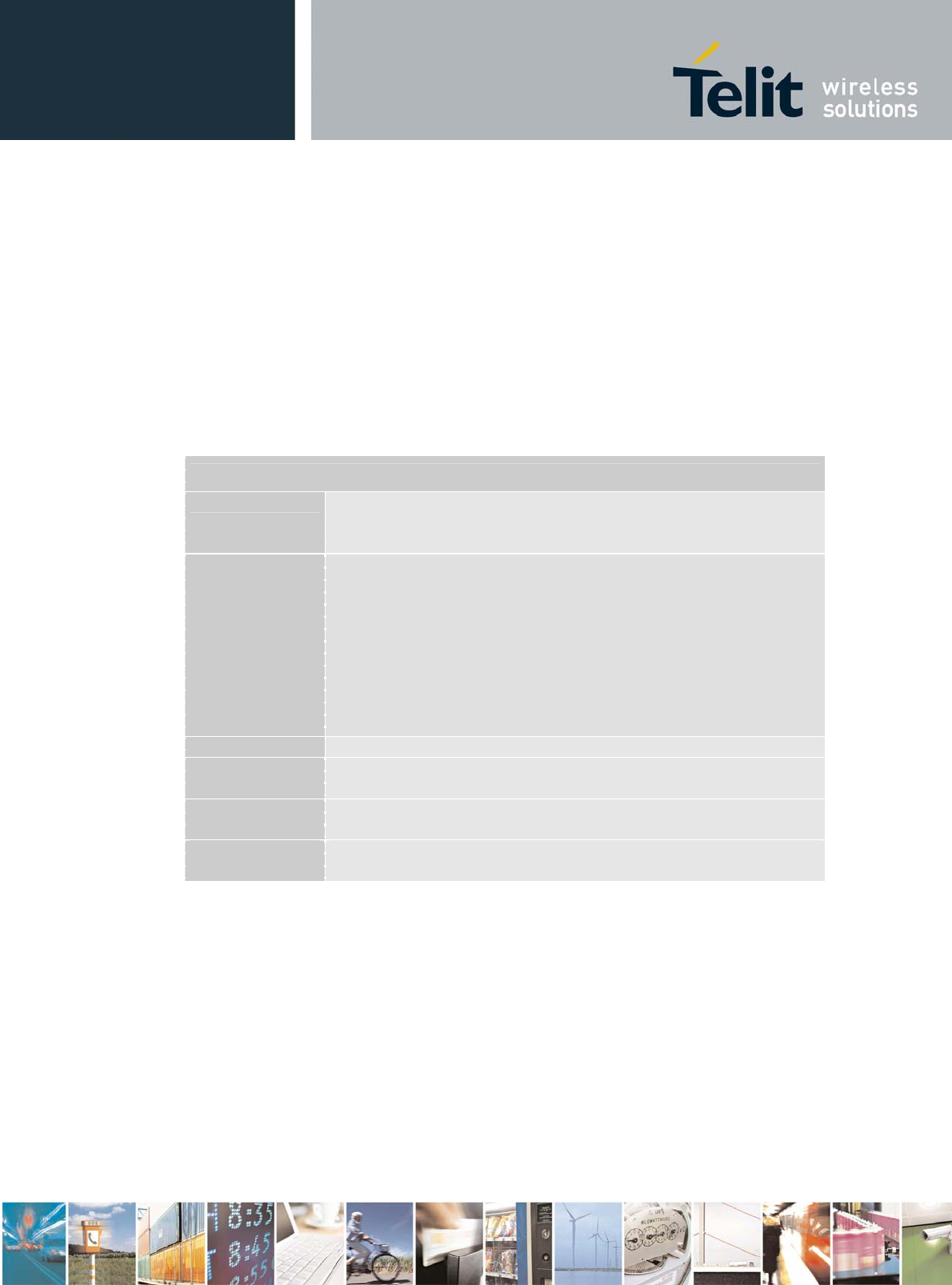
HC864-AUTO Hardware User Guide
1vv0300946 Rev.4 – 2012-12-27
Reproduction forbidden without written authorization from Telit Communications S.p.A. - All Rights
Reserved. Page 36 of 77
6. Antenna(s)
The antenna connection and board layout design are the most important parts in the full
product design and they strongly reflect on the product’s overall performances. Read carefully
and follow the requirements and the guidelines for a proper design.
6.1. GSM/WCDMA Antenna Requirements
As suggested on the Product Description, the antenna for a Telit HC864-AUTO device must
fulfill the following requirements:
Furthermore if the device is developed for the US and/or Canada market, it must comply with
the FCC and/or IC approval requirements:
This device is to be used only for mobile and fixed application. In order to re-use the Telit
FCC/IC approvals the antenna(s) used for this transmitter must be installed to provide a
separation distance of at least 20 cm from all persons and must not be co-located or operating
in conjunction with any other antenna or transmitter. If antenna is installed with a separation
distance of less than 20 cm from all persons or is co-located or operating in conjunction with
any other antenna or transmitter then additional FCC/IC testing may be required. End-Users
must be provided with transmitter operation conditions for satisfying RF exposure compliance.
OEM integrators must ensure that the end user has no manual instructions to remove or install
the HC864-AUTO module. Antennas used for this OEM module must not exceed 2dBi gain
for mobile and fixed operating configurations.
GSM / WCDMA Antenna Requirements
Frequency range Depending by frequency band(s) provided by the network operator,
the customer must use the most suitable antenna for that/those
band(s)
Bandwidth
GSM850 : 70 MHz
GSM900 : 80 MHz
GSM1800(DCS) : 170 MHz
GSM1900(PCS) : 140 MHz
WCDMA band I(2100) : 250 MHz
WCDMA band II(1900) : 140 MHz
WCDMA band IV(AWS) : 445 MHz
WCDMA band V(850) : 70 MHz
WCDMA band VIII(900) : 80 MHz
Impedance 50 Ohm
Input power > 33dBm(2 W) peak power in GSM
> 24dBm Average power in WCDMA
VSWR absolute
max <= 5:1(limit to avoid permanent damage)
VSWR
recommended <= 2:1(limit to fulfill all regulatory requirements)

HC864-AUTO Hardware User Guide
1vv0300946 Rev.4 – 2012-12-27
Reproduction forbidden without written authorization from Telit Communications S.p.A. - All Rights
Reserved. Page 37 of 77
6.2. GSM/WCDMA Antenna - Installation Guidelines
• Install the antenna in a place covered by the GSM/WCDMA signal.
• The Antenna shall be installed to provide a separation distance of at least 20 cm
from all persons and must not be co-located or operating in conjunction with any
other antenna or transmitter;
• If the device antenna is located greater then 20cm from the human body and there
are no co-located transmitter then the Telit FCC/IC approvals can be re-used by
the end product.
• If the device antenna is located less then 20cm from the human body or there are
no co-located transmitter then the additional FCC/IC testing may be required for
the end product (Telit FCC/IC approvals cannot be reused)
• Antenna shall not be installed inside metal cases;
• Antenna shall be installed also according Antenna manufacturer instructions.
6.3. GPS/GNSS and RX diversity Antenna
Requirements
The HC864-AUTO supports the GPS/GNSS and WCDMA RX diversity receiver.
The HC864-AUTO module provides one RF PAD for GPS/GNSS and RX diversity.
So the HC864-AUTO requires a combined GPS/RX diversity antenna for the simultaneous
use of GPS/GNSS and WCDMA RX diversity.
6.3.1. GPS/GNSS Antenna Requirements
The customer shall use an external active antenna for the use of GNSS receiver.
The external active antenna for the Telit HC864-AUTO device must fulfill the following
requirements:
ACTIVE GPS/GNSS Antenna Requirements
Frequency range 1565 MHz ~ 1606 MHz
Gain 1.5 dBi < Gain < 4.5 dBi
Impedance 50
VSWR <= 2:1
Noise figure <= 1.0 dB
Amplification 14 dB ~ 17 dB
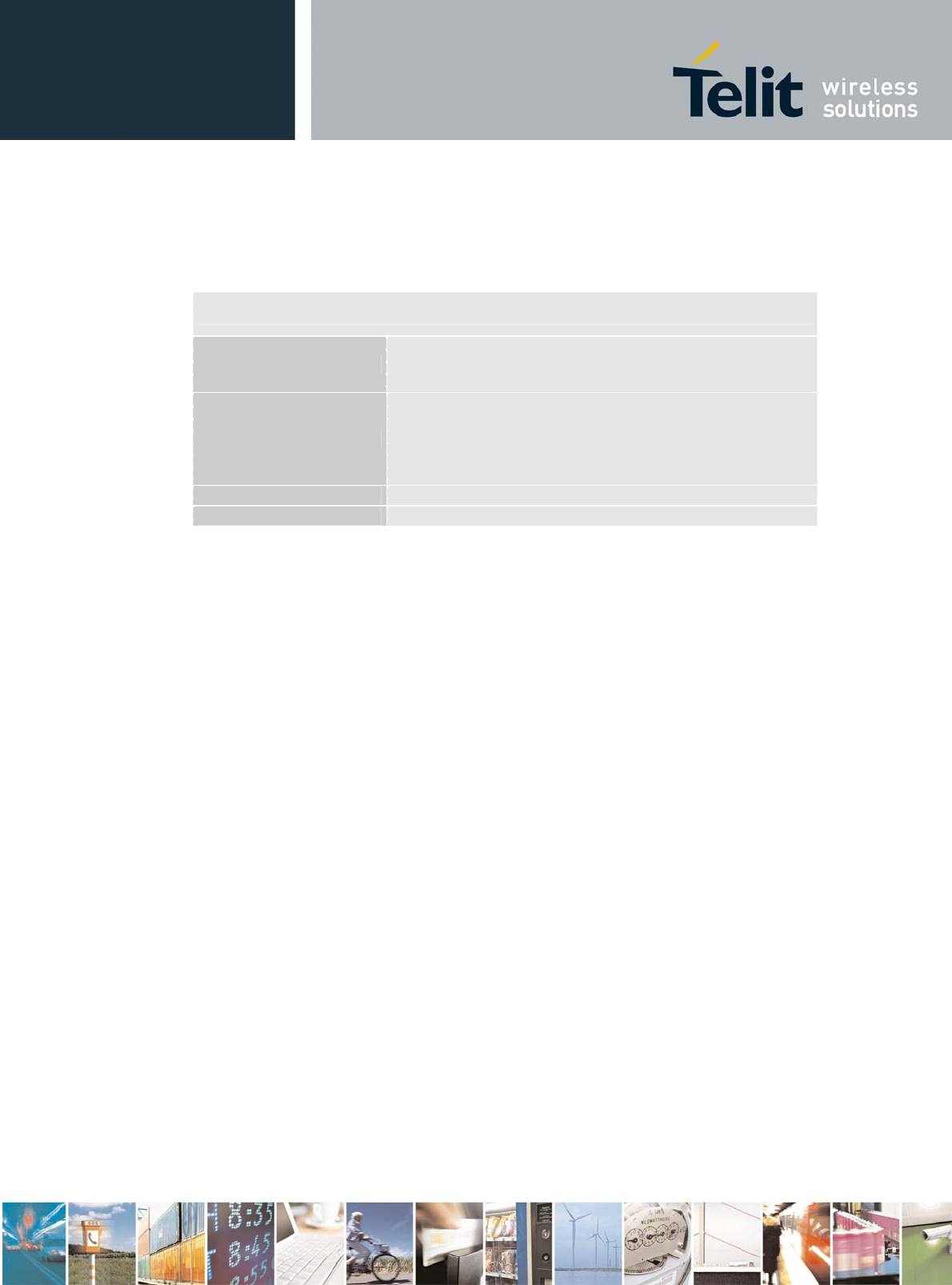
HC864-AUTO Hardware User Guide
1vv0300946 Rev.4 – 2012-12-27
Reproduction forbidden without written authorization from Telit Communications S.p.A. - All Rights
Reserved. Page 38 of 77
6.3.2. RX Diversity Antenna Requirements
The WCDMA RX diversity antenna for the Telit HC864-AUTO shall fulfill the following
requirements:
ANTENNA REQUIREMENTS
Frequency range Depending by frequency band(s) provided by the network
operator, the customer shall use the most suitable antenna for
that/those band(s)
Bandwidth
WCDMA band I(2100) : 60 MHz ~
WCDMA band II(1900) : 60 MHz
WCDMA band IV(AWS) : 45 MHz
WCDMA band V(850) : 25 MHz
WCDMA band VIII(900) : 35 MHz
Impedance 50Ω
VSWR recommended ≤ 2:1
The second Rx antenna should not be located in the close vicinity of main antenna. In order to
improve Diversity Gain, Isolation and reduce mutual interaction, the two antennas should be
located at the maximum reciprocal distance possible, taking into consideration the available
space into the application.
6.4. GPS/GNSS Antenna Installation Guidelines
• The HC864-AUTO due to its characteristics of sensitivity is capable to perform a
Fix inside the buildings. (In any case the sensitivity could be affected by the
building characteristics i.e. shielding).
• The Antenna shall not be co-located or operating in conjunction with any other
antenna or transmitter.
• Antenna shall not be installed inside metal cases.
• Antenna shall be installed also according Antenna manufacturer instructions.
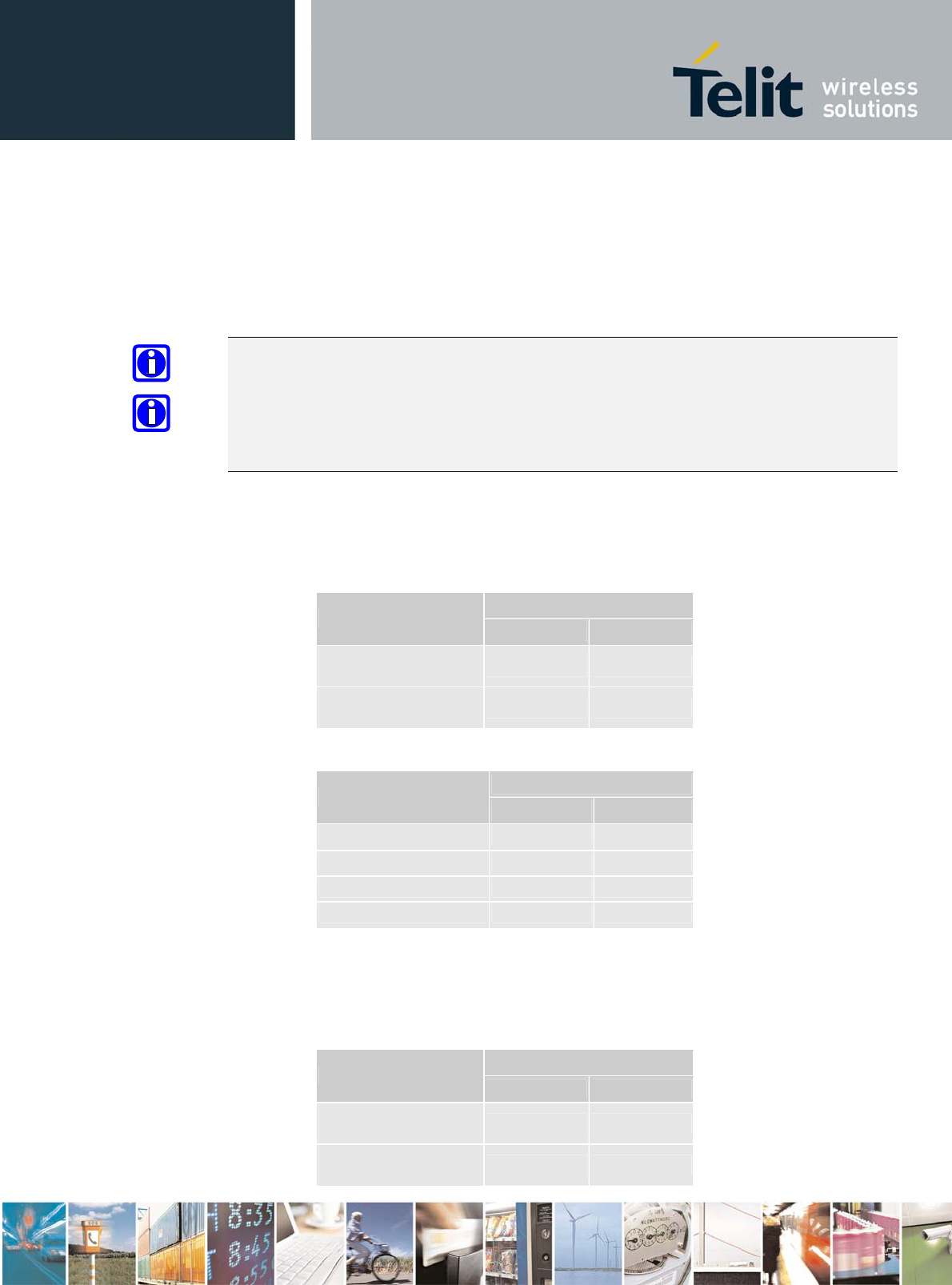
HC864-AUTO Hardware User Guide
1vv0300946 Rev.4 – 2012-12-27
Reproduction forbidden without written authorization from Telit Communications S.p.A. - All Rights
Reserved. Page 39 of 77
7. Logic Level Specifications
The following table shows the logic level specifications used in the Telit HC864-AUTO
interface circuits:
NOTE:
Do not connect HC864-AUTO’s digital logic signal directly to OEM’s digital logic signal of
with level higher than 3.0V for 2.6V CMOS signals.
Do not connect HC864-AUTO’s digital logic signal directly to OEM’s digital logic signal of
with level higher than 2.7V for 1.8V CMOS signals.
For 2.6V CMOS signals:
Absolute Maximum Ratings -Not Functional
HC864-AUTO
Parameter Min Max
Input level on any
digital pin when on -0.3V +3.0V
Input voltage on
analog pins when on -0.3V +2.7 V
Operating Range - Interface levels
HC864-AUTO
Level Min Max
Input high level 2.0V 2.6 V
Input low level -0.3V 0.6V
Output high level 2.2V 2.6V
Output low level 0V 0.4V
For 1,8V CMOS signals:
Absolute Maximum Ratings -Not Functional
HC864-AUTO
Parameter Min Max
Input level on any
digital pin when on -0.3V +2.7V
Input voltage on
analog pins when on -0.3V +2.7 V
Operating Range - Interface levels (1.8V CMOS)
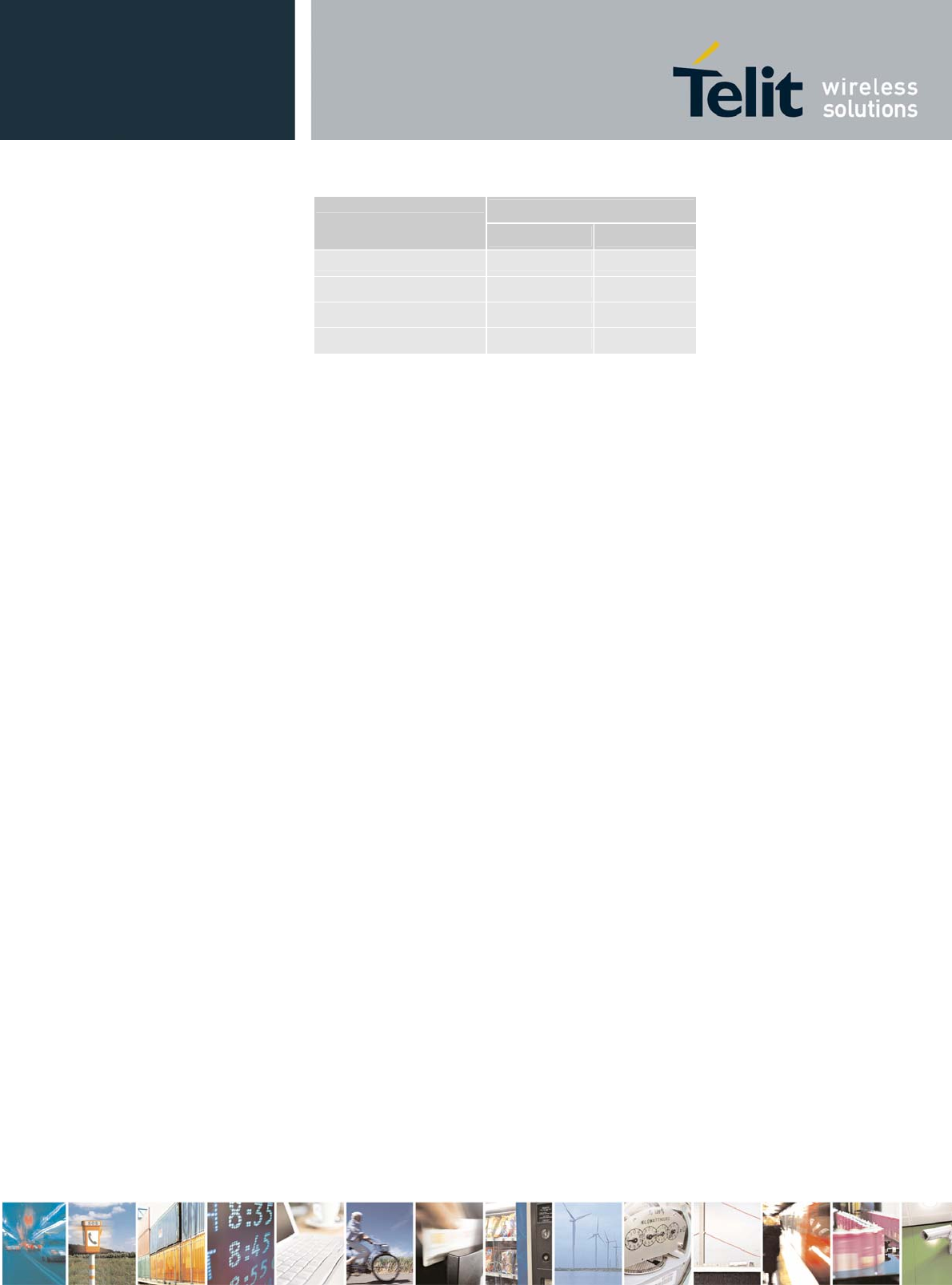
HC864-AUTO Hardware User Guide
1vv0300946 Rev.4 – 2012-12-27
Reproduction forbidden without written authorization from Telit Communications S.p.A. - All Rights
Reserved. Page 40 of 77
HC864-AUTO
Level Min Max
Input high level 1.5V 2.1V
Input low level -0.3V 0.5V
Output high level 1.35V 1.8V
Output low level 0V 0.45V
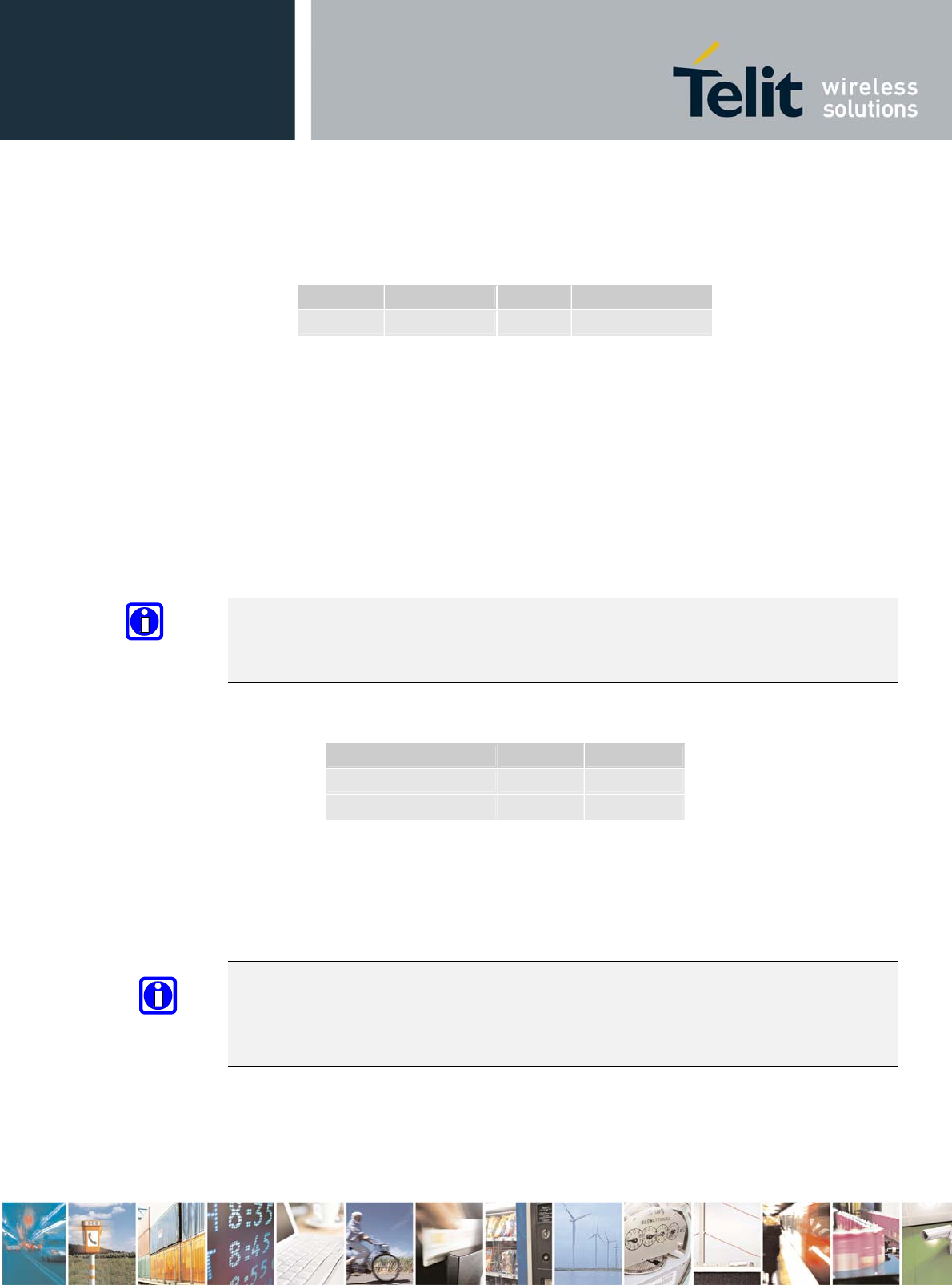
HC864-AUTO Hardware User Guide
1vv0300946 Rev.4 – 2012-12-27
Reproduction forbidden without written authorization from Telit Communications S.p.A. - All Rights
Reserved. Page 41 of 77
7.1. Reset Signal
Signal Function I/O PIN Number
RESET Phone reset I 54
RESET is used to reset the HC864-AUTO module. Whenever this signal is pulled low
HC864-AUTO is reset. When the device is reset it stops all operations. After the release of the
reset HC864-AUTO is unconditionally shut down, without doing any detach operations from
the network where it is registered. This behavior is not a proper shutdown because the device
is requested to issue a detach request on turn off. For this reason, the Reset signal must not be
used for normally shutting down the device, but only as an emergency exit in the rare case the
device remains stuck waiting for some network response.
The RESET is internally controlled on start-up to achieve always a proper power-on reset
sequence. There is no need to control this pin on start-up. It may only be used to reset a
device already on that is, not responding to any command.
NOTE:
Do not use this signal to power off HC864-AUTO. Use the ON/OFF signal to perform this
function or the AT#SHDN command.
Reset Signal Operating levels:
Signal Min Max
RESET Input high 1.5V* 2.1V
RESET Input low 0V 0.2V
* This signal is internally pulled up so the pin can be left floating if not used.
If unused, this signal may be left unconnected. If used, it must always be connected with an
open collector transistor to permit the internal circuitry the power on reset and under voltage
lockout functions.
NOTE:
In order to avoid a back powering effect it is recommended to avoid having any HIGH logic
level signal applied to the digital pins of the module when is powered OFF or during an
ON/OFF transition.
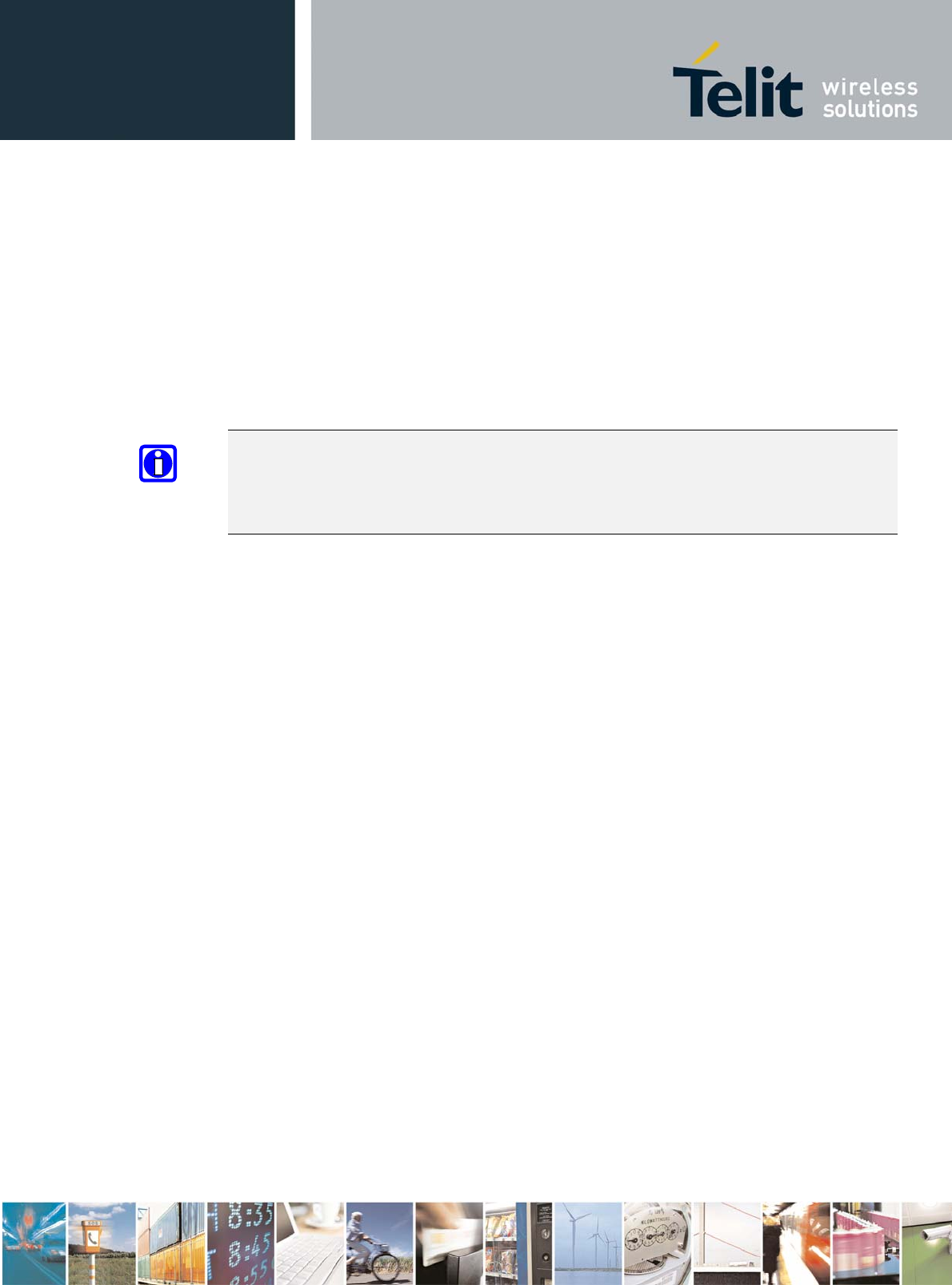
HC864-AUTO Hardware User Guide
1vv0300946 Rev.4 – 2012-12-27
Reproduction forbidden without written authorization from Telit Communications S.p.A. - All Rights
Reserved. Page 42 of 77
8. Serial Ports
The serial port on the Telit HC864-AUTO is the interface between the module and OEM
hardware.
2 serial ports are available on the module:
• MODEM SERIAL PORT;
• MODEM SERIAL PORT 2 (DEBUG).
NOTE:
In order to avoid a back powering effect it is recommended to avoid having any HIGH logic
level signal applied to the digital pins of the module when is powered OFF or during an
ON/OFF transition.
8.1. Modem Serial Port
Several configurations can be designed for the serial port on the OEM hardware.
The most common are:
• RS232 PC com port;
• microcontroller UART @ 2.6V (Universal Asynchronous Receive Transmit) ;
• microcontroller UART @ 5V or other voltages different from 2.6V.
Depending on the type of serial port on the OEM hardware, a level translator circuit may be
needed to make the system work. The only configuration that does not need a level translation
is the 2.6V UART.
The serial port on HC864-AUTO is a +2.6V UART with all the 7 RS232 signals. It differs
from the PC-RS232 in signal polarity (RS232 is reversed) and levels.
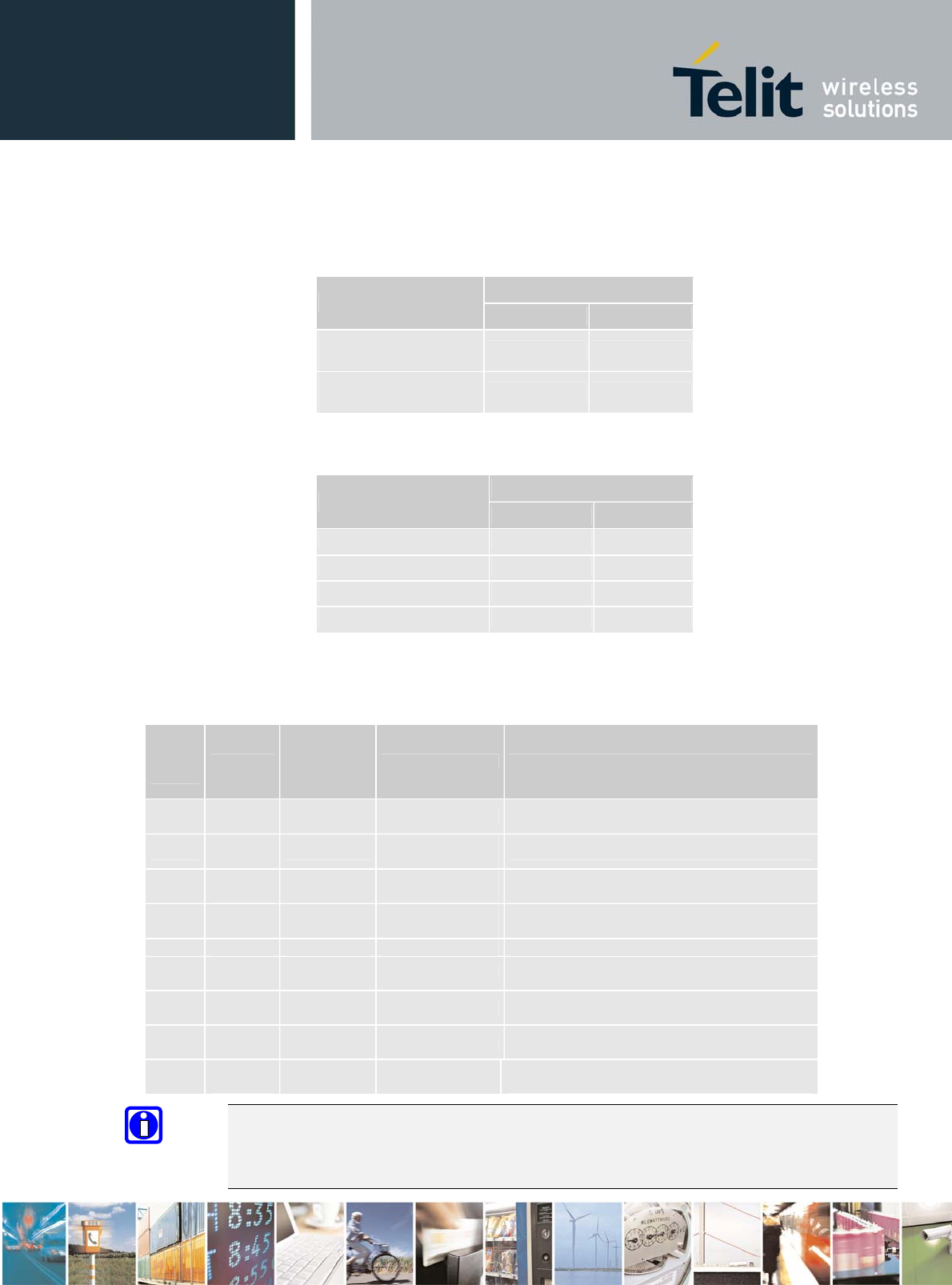
HC864-AUTO Hardware User Guide
1vv0300946 Rev.4 – 2012-12-27
Reproduction forbidden without written authorization from Telit Communications S.p.A. - All Rights
Reserved. Page 43 of 77
The levels for HC864-AUTO UART are the CMOS levels:
Absolute Maximum Ratings -Not Functional
HC864-AUTO
Parameter Min Max
Input level on any
digital pin when on -0.3V +3.0V
Input voltage on
analog pins when on -0.3V +2.7 V
Operating Range - Interface levels
HC864-AUTO
Level Min Max
Input high level 2.0V 2.6 V
Input low level -0.3V 0.6V
Output high level 2.2V 2.6V
Output low level 0V 0.4V
The signals of the HC864-AUTO serial port are:
RS232
Pin
Number Signal HC864-AUTO
Pad Number Name Usage
1 DCD -
dcd_uart 32 Data Carrier Detect Output from the HC864-AUTO that indicates the
carrier presence
2 RXD -
Tx_uart 26 Transmit line *see
Note Output transmit line of the HC864-AUTO UART
3 TXD -
Rx_uart 25 Receive line *see
Note Input receive of the HC864-AUTO UART
4 DTR -
dtr_uart 29 Data Terminal
Ready
Input to the HC864-AUTO that controls the DTE
READY condition
5 GND 5,6,7 Ground ground
6 DSR -
dsr_uart 27 Data Set Ready Output from the HC864-AUTO that indicates the
module is ready
7 RTS -
rts_uart 31 Request to Send Input to the HC864-AUTO that controls the
Hardware flow control
8 CTS -
cts_uart 28 Clear to Send Output from the HC864-AUTO that controls the
Hardware flow control
9 RI -
ri_uart 30 Ring Indicator Output from the HC864-AUTO that indicates the
Incoming call condition
TIP:
For minimum implementation, only the TXD and RXD lines can be connected, the other lines
can be left open provided a software flow control is implemented.
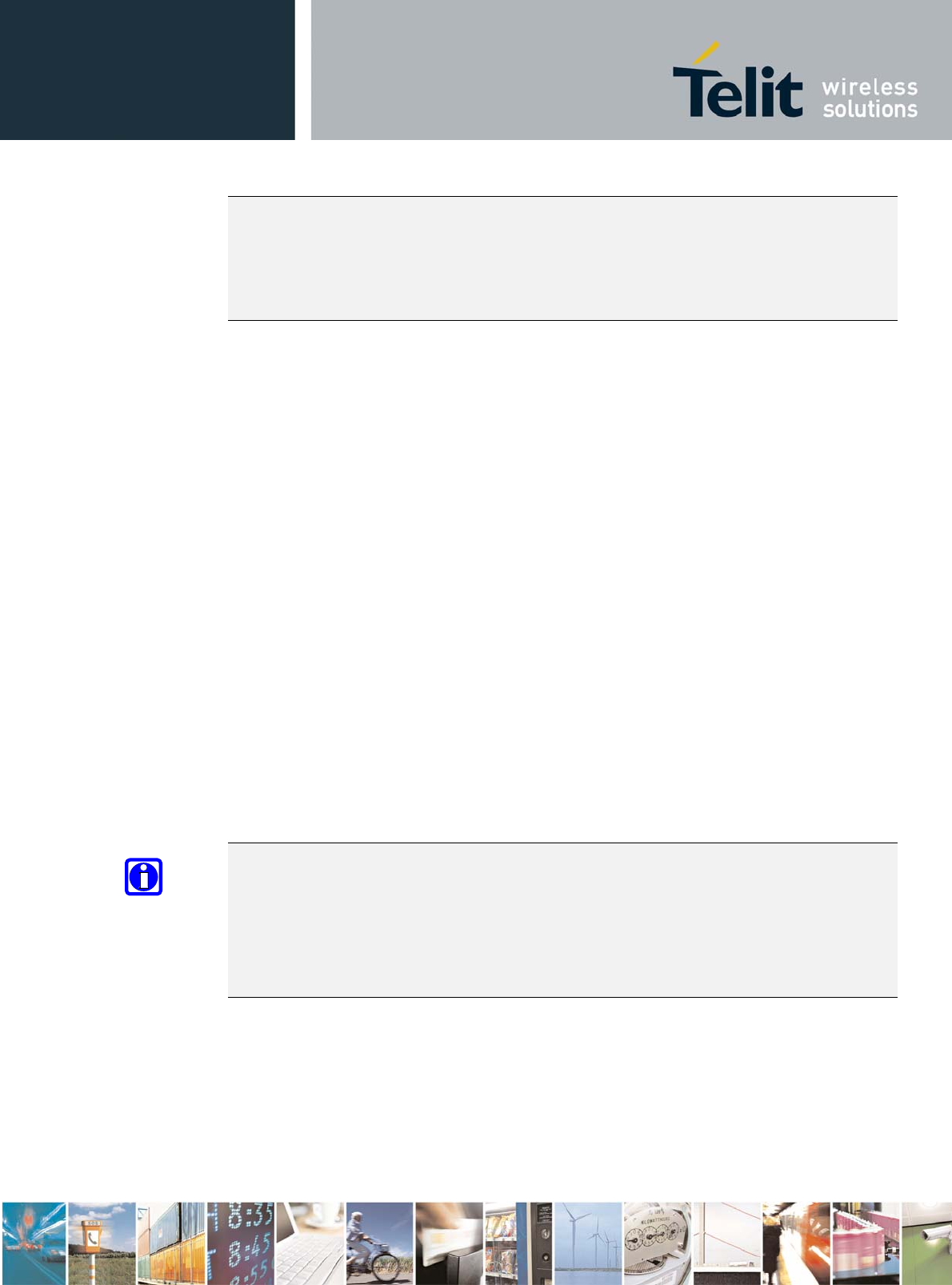
HC864-AUTO Hardware User Guide
1vv0300946 Rev.4 – 2012-12-27
Reproduction forbidden without written authorization from Telit Communications S.p.A. - All Rights
Reserved. Page 44 of 77
NOTE:
According to V.24, RX/TX signal names are referred to the application side, therefore on the
HC864-AUTO side these signal are on the opposite direction: TXD on the application side
will be connected to the receive line (here named TXD/ rx_uart ) of the HC864-AUTO serial
port and vice versa for RX.
8.2. RS232 Level Translation
In order to interface the Telit HC864-AUTO with a PC com port or a RS232 (EIA/TIA-232)
application a level translator is required. This level translator must:
• invert the electrical signal in both directions;
• Change the level from 0/2.6V to +15/-15V.
Actually, the RS232 UART 16450, 16550, 16650 & 16750 chipsets accept signals with lower
levels on the RS232 side (EIA/TIA-562), allowing a lower voltage-multiplying ratio on the
level translator. Note that the negative signal voltage must be less than 0V and hence some
sort of level translation is always required.
The simplest way to translate the levels and invert the signal is by using a single chip level
translator. There are a multitude of them, differing in the number of drivers and receivers and
in the levels (be sure to get a true RS232 level translator not a RS485 or other standards).
By convention the driver is the level translator from the 0-2.6V UART to the RS232 level.
The receiver is the translator from the RS232 level to 0-2.6V UART.
In order to translate the whole set of control lines of the UART you will need:
• 5 drivers
• 3 receivers
NOTE:
The digital input lines working at 2.6V CMOS have an absolute maximum input voltage of
3.0V; therefore the level translator IC shall not be powered by the +3.8V supply of the
module. Instead, it must be powered from a +2.6V (dedicated) power supply.
This is because in this way the level translator IC outputs on the module side (i.e. HC864-
AUTO inputs) will work at +3.8V interface levels, damaging the module inputs.
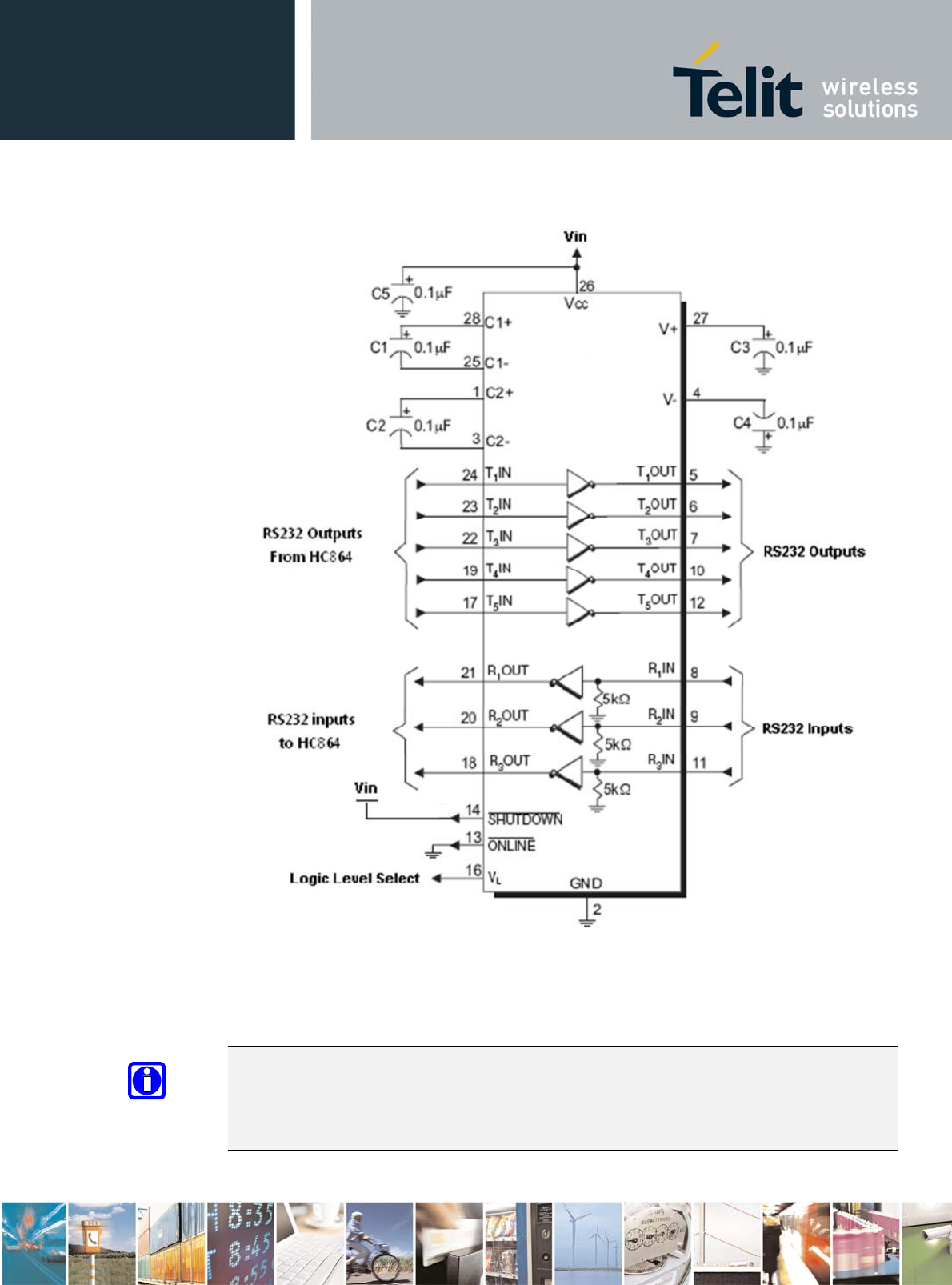
HC864-AUTO Hardware User Guide
1vv0300946 Rev.4 – 2012-12-27
Reproduction forbidden without written authorization from Telit Communications S.p.A. - All Rights
Reserved. Page 45 of 77
An example of level translation circuitry of this kind is:
The example is done with a SIPEX SP3282EB RS232 Transceiver that could accept supply
voltages lower than 3V DC.
NOTE:
In this case Vin has to be set with a value compatible with the logic levels of the module
(Max 2.6V DC). In this configuration the SP3282EB will adhere to EIA/TIA-562 voltage
levels instead of RS232 (-5 ~ +5V)
Second solution could be done using a MAXIM transceiver (MAX218) In this case the
compliance with RS232 (+-5V) is possible.
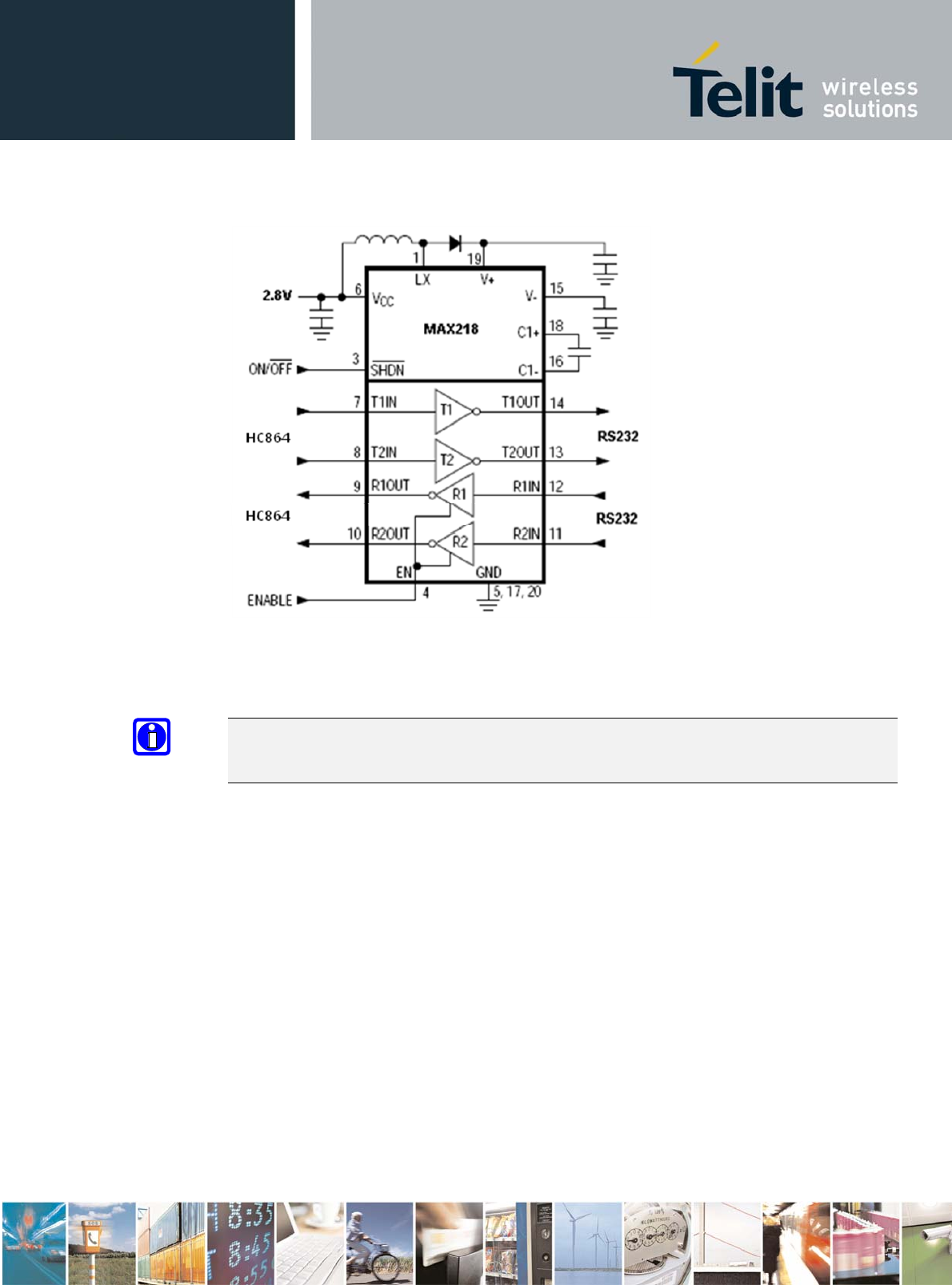
HC864-AUTO Hardware User Guide
1vv0300946 Rev.4 – 2012-12-27
Reproduction forbidden without written authorization from Telit Communications S.p.A. - All Rights
Reserved. Page 46 of 77
Another level adapting method could be done using a standard RS232 Transceiver
(MAX3237EAI) adding some resistors to adapt the levels on the HC864-AUTO Input lines.
NOTE:
In this case has to be taken in account the length of the lines on the application to avoid
problems in case of High-speed rates on RS232.
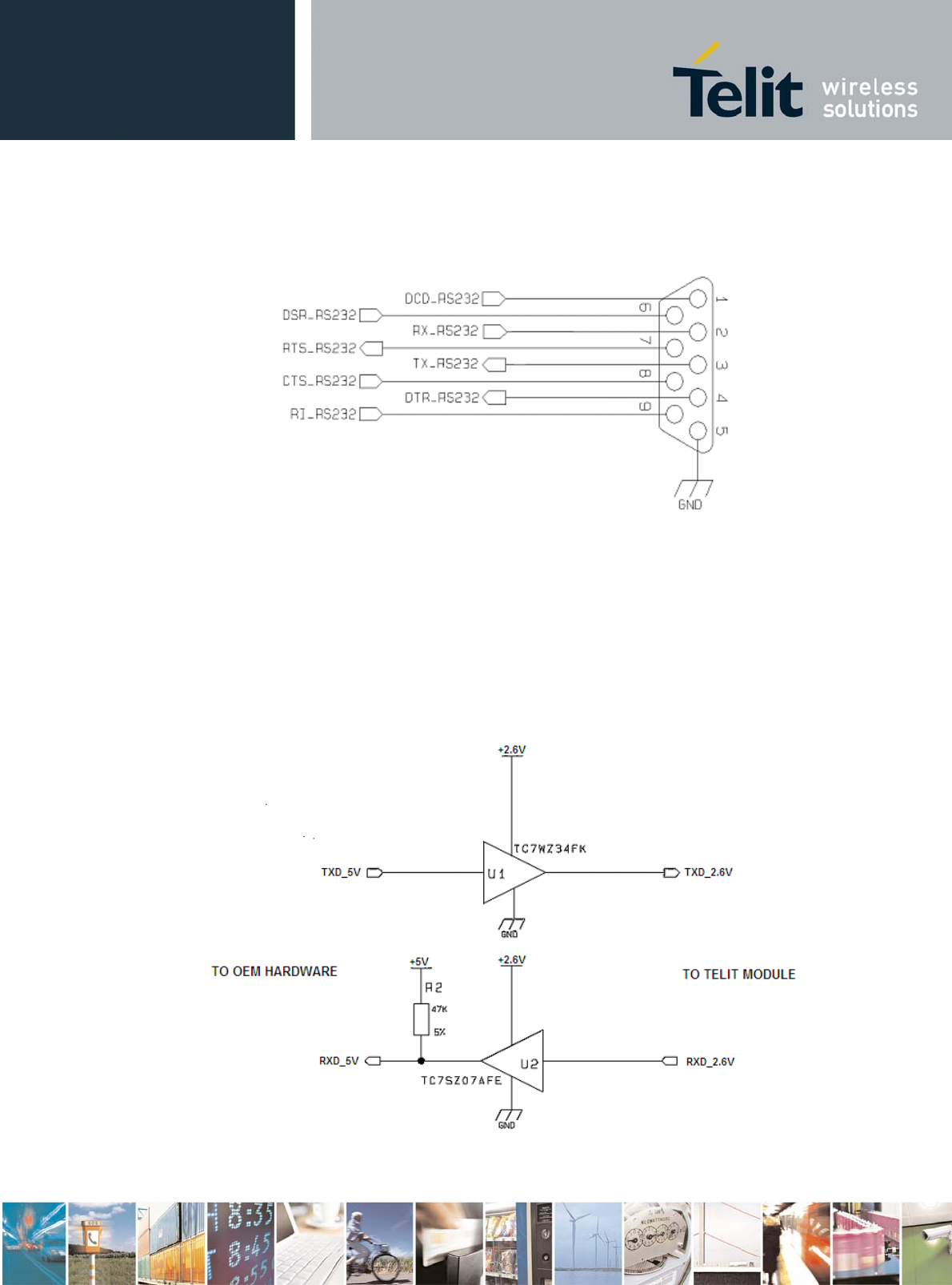
HC864-AUTO Hardware User Guide
1vv0300946 Rev.4 – 2012-12-27
Reproduction forbidden without written authorization from Telit Communications S.p.A. - All Rights
Reserved. Page 47 of 77
The RS232 serial port lines are usually connected to a DB9 connector with the following
layout: signal names and directions are named and defined from the DTE point of view
8.3. 5V UART Level Translation
If the OEM application uses a microcontroller with a serial port (UART) that works at a
voltage different from 2.6, then a circuitry has to adapt the different levels of the two signal
sets. As for the RS232 translation, there are a multitude of single chip translators. For
example a possible translator circuit for a 5V TRANSMITTER/RECEIVER can be:
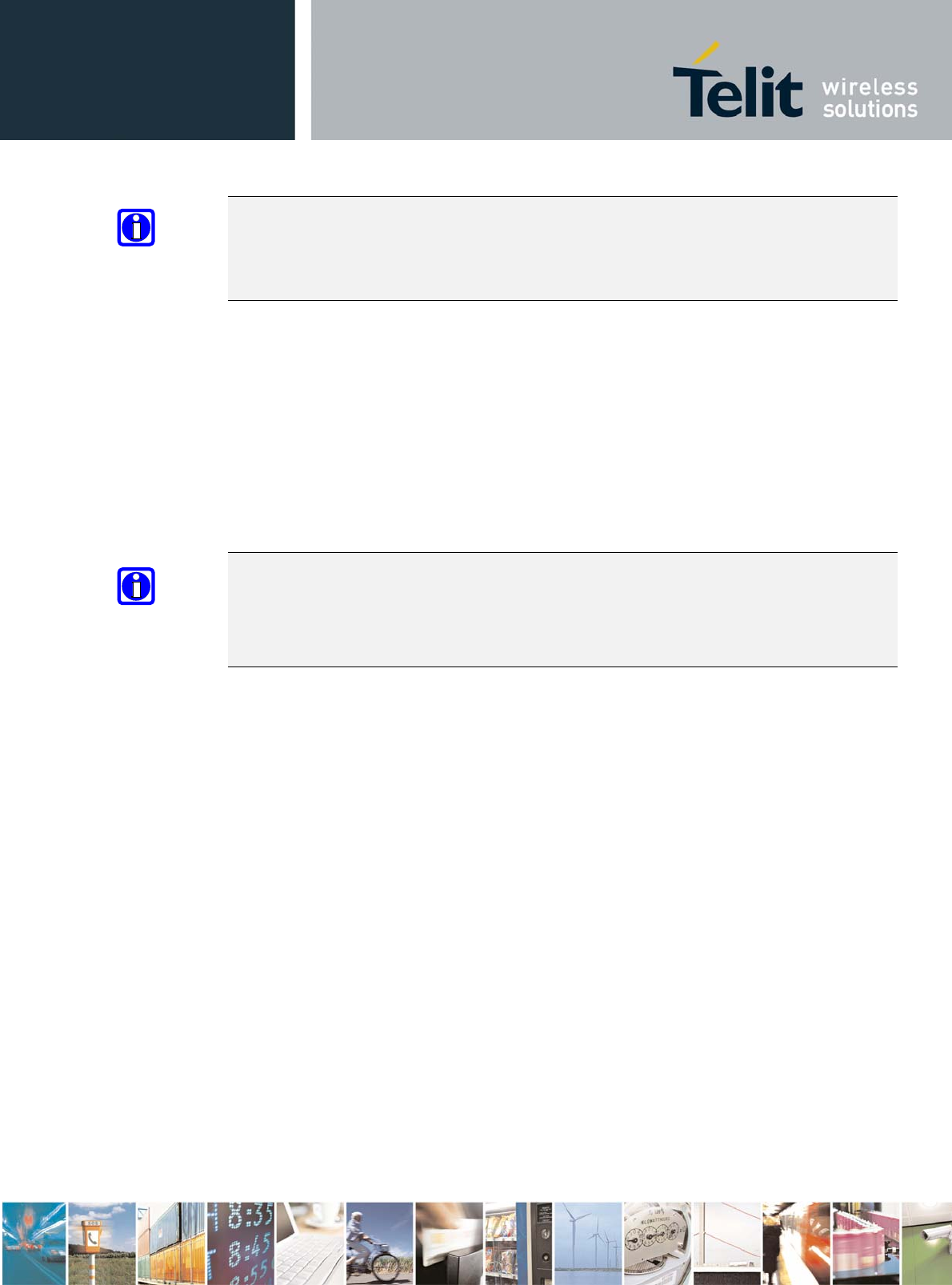
HC864-AUTO Hardware User Guide
1vv0300946 Rev.4 – 2012-12-27
Reproduction forbidden without written authorization from Telit Communications S.p.A. - All Rights
Reserved. Page 48 of 77
TIP:
This logic IC for the level translator and 2.6V pull-ups (not the 5V one) can be powered
directly from VAUX1 line of HC864-AUTO. Note that the TC7SZ07AE has open drain
output; therefore the resistor R2 is mandatory.
A power source of the internal interface voltage corresponding to the 2.6V CMOS high level
is available at the VAUX1 pin on the connector.
A maximum of 9 resistors of 47 K pull-up can be connected to the VAUX1 pin, provided no
other devices are connected to it and the pulled-up lines are HC864-AUTO input lines
connected to open collector outputs in order to avoid latch-up problems on HC864-AUTO.
Careful approach is needed to avoid latch-up on HC864-AUTO and the use of this output line
to power electronic devices must be avoided, especially for devices that generate spikes and
noise such as switching level translators, micro controllers, failure in any of these condition
can severely compromise the HC864-AUTO functionality.
TIP:
The input lines working at 2.6VCMOS can be pulled-up with 47K resistors that can be
connected directly to the VAUX1 line. It is a must that they are connected as in this example.
The preferable configuration is having external supply for the buffer.

HC864-AUTO Hardware User Guide
1vv0300946 Rev.4 – 2012-12-27
Reproduction forbidden without written authorization from Telit Communications S.p.A. - All Rights
Reserved. Page 49 of 77
9. Audio Section
HC864-AUTO module doesn’t support an analog audio interface and supports only PCM interface. HC864-
AUTO module can be connected to external codec through PCM interface.
For further information, please refer to the “HC864-AUTO_Digital_Voice_Interface_Application_Note”.
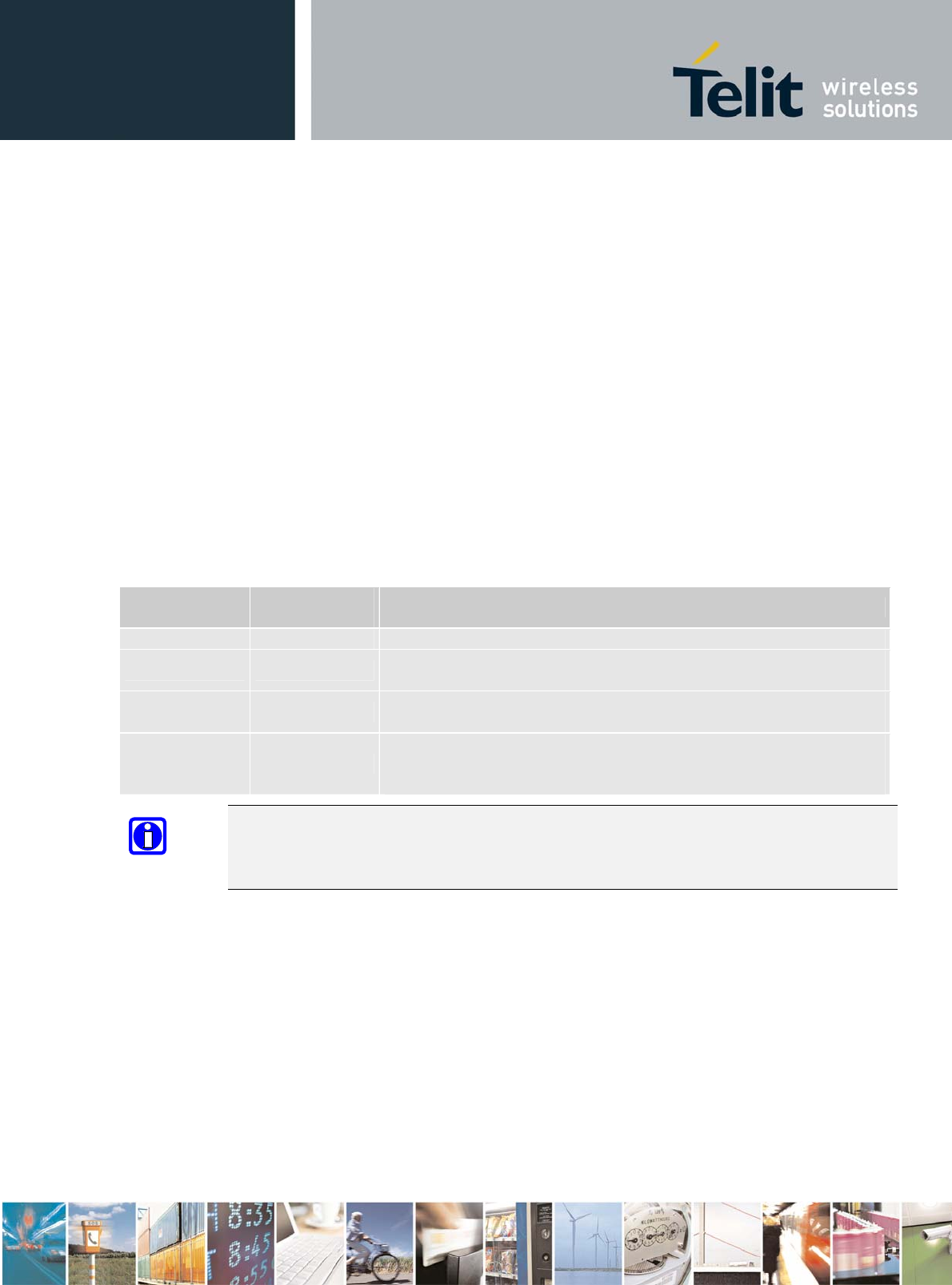
HC864-AUTO Hardware User Guide
1vv0300946 Rev.4 – 2012-12-27
Reproduction forbidden without written authorization from Telit Communications S.p.A. - All Rights
Reserved. Page 50 of 77
10. USB Port
The HC864-AUTO module includes a Universal Serial Bus (USB) transceiver, which
operates at USB low-speed (1.5Mbits/sec), USB full-speed (12Mbits/sec) and USB high-
speed (480Mbits/sec).
It is compliant with the USB 2.0 specification and can be used for diagnostic monitoring,
control and data transfers.
The USB_DPLUS and USB_DMINUS signals have a clock rate of 480MHz. The signal
traces should be routed carefully. Trace lengths, number of vias and capacitive loading should
be minimized. The impedance value should be as close as possible to 90 Ohms differential.
The table below describes the USB interface signals:
TIP:
HC864-AUTO does NOT support host device operation at the moment, that is, it works as a
slave device. Consequently USB_ID must be opened (not connected).
Signal HC864-ATUO
Pad No. Usage
USB_VBUS 48 Power sense for the internal USB transceiver
USB_D- 80 Minus (-) line of the differential, bi-directional USB signal to/from the
peripheral device
USB D+ 79 Plus (+) line of the differential, bi-directional USB signal to/from the
peripheral device
USB_ID
(for future use) 35
Analog input used to sense whether a peripheral device is
connected and if connected, to determine the peripheral type, host or
slave
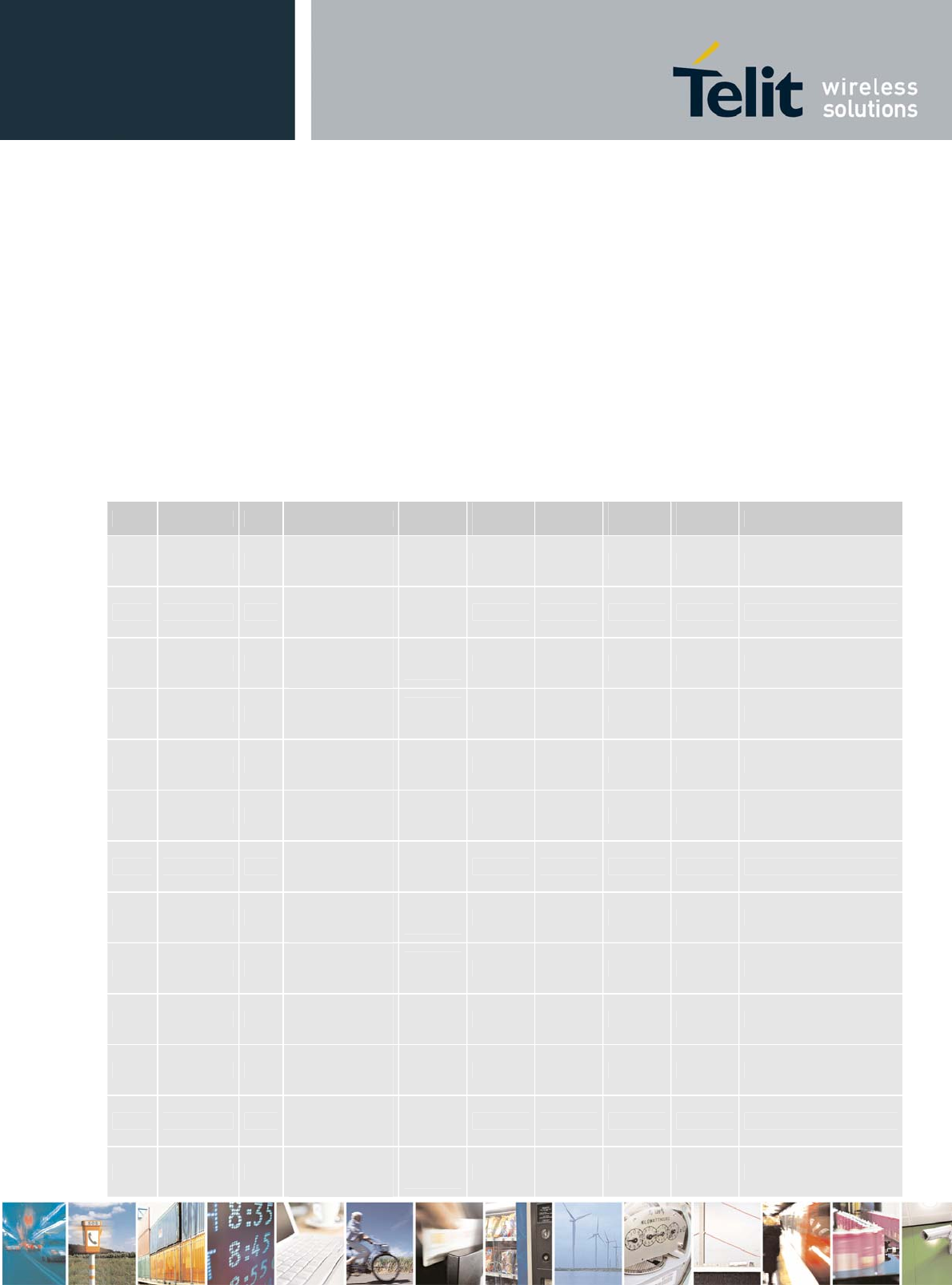
HC864-AUTO Hardware User Guide
1vv0300946 Rev.4 – 2012-12-27
Reproduction forbidden without written authorization from Telit Communications S.p.A. - All Rights
Reserved. Page 51 of 77
11. General Purpose I/O
The general-purpose I/O pads can be configured to act in three different ways:
• input
• output
• alternate function (internally controlled)
Input pads can only be read and report the digital value (high or low) present on the pad at the
read time; output pads can only be written or queried and set the value of the pad output; an
alternate function pad is internally controlled by the HC864-AUTO firmware and acts
depending on the function implemented.
The following GPIOs are available on the HC864-AUTO.
PIN Signal I/O Function Type Drive
strength Default
State ON_OF
F State Reset
State Note
70 TGPIO_01 I/O
GPIO01
Configurable
GPIO
CMOS
1.8V 2mA INPUT LOW LOW
74 TGPIO_02 I/O
GPIO02
Configurable
GPIO
CMOS
1.8V 2mA INPUT LOW LOW
66 TGPIO_03 I/O
GPIO03
Configurable
GPIO
CMOS
1.8V 2mA INPUT LOW LOW
59 TGPIO_04 I/O
GPIO04
Configurable
GPIO
CMOS
1.8V 2mA INPUT LOW LOW
78 TGPIO_05 I/O
GPIO05
Configurable
GPIO
CMOS
2.6V 2mA INPUT LOW LOW
68 TGPIO_06 I/O
GPIO06
Configurable
GPIO
CMOS
1.8V 2mA INPUT LOW LOW Alternate function
(ALARM)
73 TGPIO_07 I/O
GPIO07
Configurable
GPIO
CMOS
1.8V 2mA INPUT LOW LOW
67 TGPIO_08 I/O
GPIO08
Configurable
GPIO
CMOS
1.8V 2mA INPUT LOW LOW
76 TGPIO_09 I/O
GPIO09
Configurable
GPIO
CMOS
1.8V 2mA INPUT LOW LOW
63 TGPIO_10 I/O
GPIO10
Configurable
GPIO
CMOS
2.6V 2mA INPUT LOW LOW
57 TGPIO_11 I/O
GPIO11
Configurable
GPIO
CMOS
1.8V 2mA INPUT LOW LOW
62 TGPIO_12 I/O
GPIO12
Configurable
GPIO
CMOS
1.8V 2mA INPUT LOW LOW
77 TGPIO_13 I/O
GPIO13
Configurable
GPIO
CMOS
1.8V 2mA INPUT LOW LOW
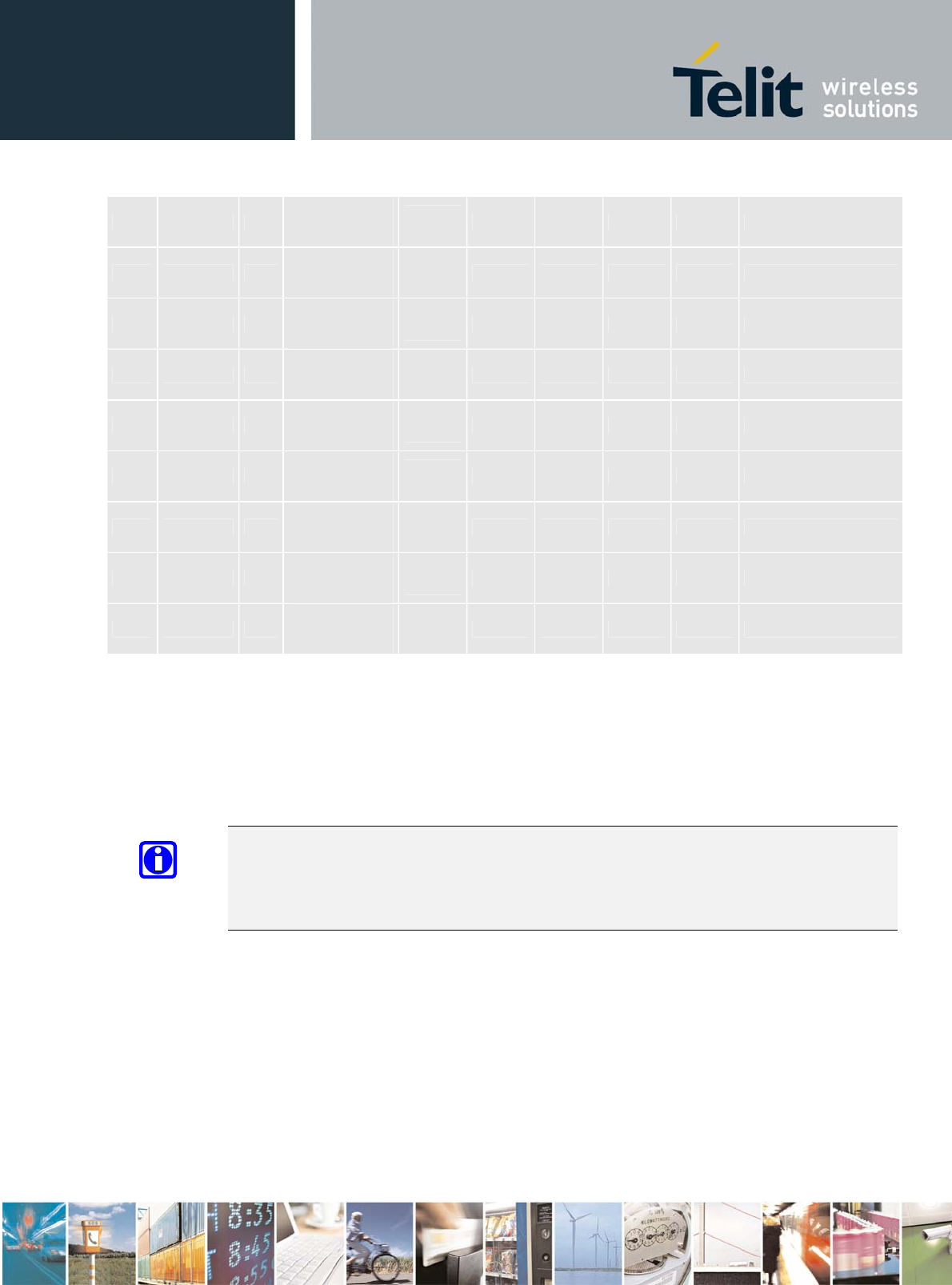
HC864-AUTO Hardware User Guide
1vv0300946 Rev.4 – 2012-12-27
Reproduction forbidden without written authorization from Telit Communications S.p.A. - All Rights
Reserved. Page 52 of 77
60 TGPIO_14 I/O
GPIO14
Configurable
GPIO
CMOS
1.8V 2mA INPUT LOW LOW
61 TGPIO_15 I/O
GPIO15
Configurable
GPIO
CMOS
1.8V 2mA INPUT LOW LOW
75 TGPIO_16 I/O
GPIO16
Configurable
GPIO
CMOS
1.8V 2mA INPUT LOW LOW
71 TGPIO_17 I/O
GPIO17
Configurable
GPIO
CMOS
2.6V 2mA INPUT LOW LOW
65 TGPIO_18 I/O
GPIO18
Configurable
GPIO
CMOS
2.6V 2mA INPUT LOW LOW
56 TGPIO_19 I/O
GPIO19
Configurable
GPIO
CMOS
1.8V 2mA INPUT LOW LOW
58 TGPIO_20 I/O
GPIO20
Configurable
GPIO
CMOS
1.8V 2mA INPUT LOW LOW
72 TGPIO_21 I/O
GPIO21
Configurable
GPIO
CMOS
1.8V 2mA INPUT HIGH HIGH
64 TGPIO_22 I/O
GPIO22
Configurable
GPIO
CMOS
1.8V 2mA INPUT LOW LOW
Not all GPIO pads support all these three modes:
• GPIO6 supports all three modes and can be input, output, alarm output (Alternate
function)
Some alternate functions for HC864-AUTO may be added if needed.
NOTE:
In order to avoid a back powering effect it is recommended to avoid having any HIGH logic
level signal applied to the digital pins of the module when is powered OFF or during an
ON/OFF transition.
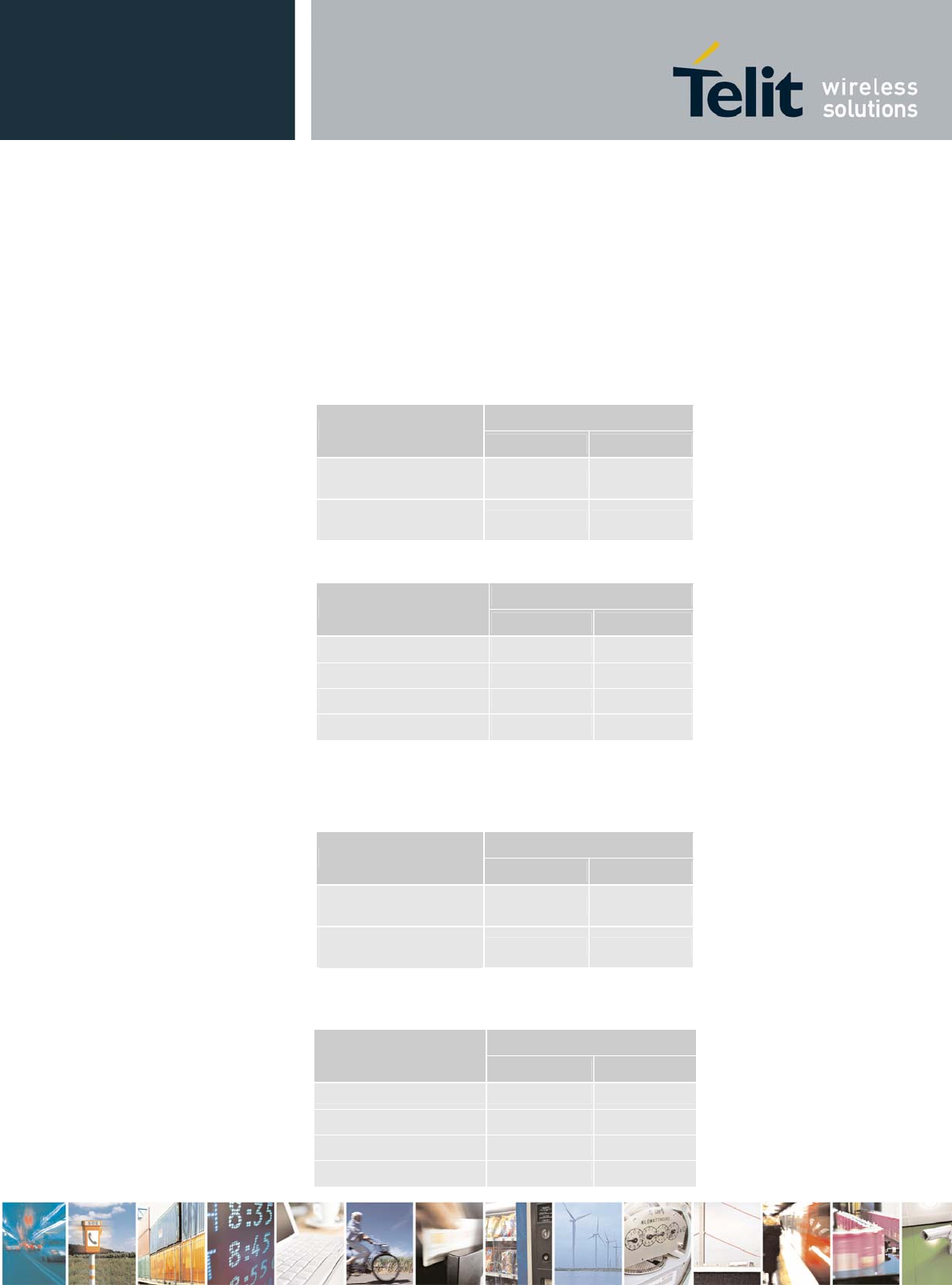
HC864-AUTO Hardware User Guide
1vv0300946 Rev.4 – 2012-12-27
Reproduction forbidden without written authorization from Telit Communications S.p.A. - All Rights
Reserved. Page 53 of 77
11.1. Logic Level Specifications
The following table shows the logic level specifications used in the HC864-AUTO interface
circuits:
For 2.6V CMOS signals:
Absolute Maximum Ratings -Not Functional
HC864-AUTO
Parameter Min Max
Input level on any
digital pin when on -0.3V +3.0V
Input voltage on
analog pins when on -0.3V +2.7 V
Operating Range - Interface levels
HC864-AUTO
Level Min Max
Input high level 2.0V 2.6 V
Input low level -0.3V 0.6V
Output high level 2.2V 2.6V
Output low level 0V 0.4V
For 1,8V signals:
Absolute Maximum Ratings -Not Functional
HC864-AUTO
Parameter Min Max
Input level on any
digital pin when on -0.3V +2.7V
Input voltage on
analog pins when on -0.3V +2.7 V
Operating Range - Interface levels (1.8V CMOS)
HC864-AUTO
Level Min Max
Input high level 1.5V 2.1V
Input low level -0.3V 0.5V
Output high level 1.35V 1.8V
Output low level 0V 0.45V
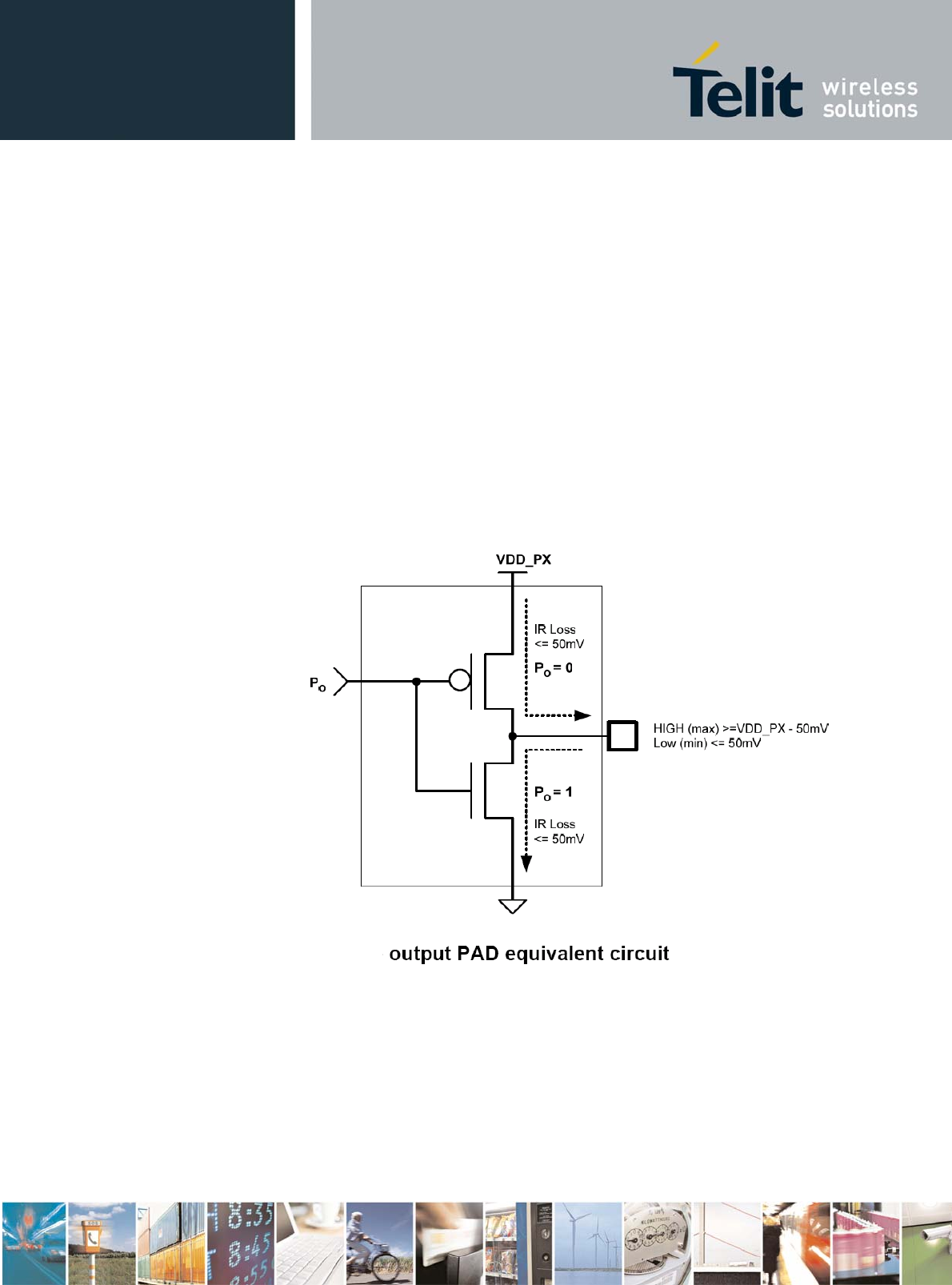
HC864-AUTO Hardware User Guide
1vv0300946 Rev.4 – 2012-12-27
Reproduction forbidden without written authorization from Telit Communications S.p.A. - All Rights
Reserved. Page 54 of 77
11.2. Using a GPIO Pad as Input
The GPIO pads, when used as inputs, can be connected to a digital output of another device
and report its status, provided this device has interface levels compatible with the 1.8V/2.6V
CMOS levels of the GPIO.
If the digital output of the device is connected with the GPIO input, the pad has interface
levels different from the 1.8V/2.6V CMOS. It can be buffered with an open collector
transistor with a 47K pull-up resistor to 1.8V/2.6V.
11.3. Using a GPIO Pad as Output
The GPIO pads, when used as outputs, can drive 1.8V/2.6V CMOS digital devices or
compatible hardware. When set as outputs, the pads have a push-pull output and therefore the
pull-up resistor may be omitted.
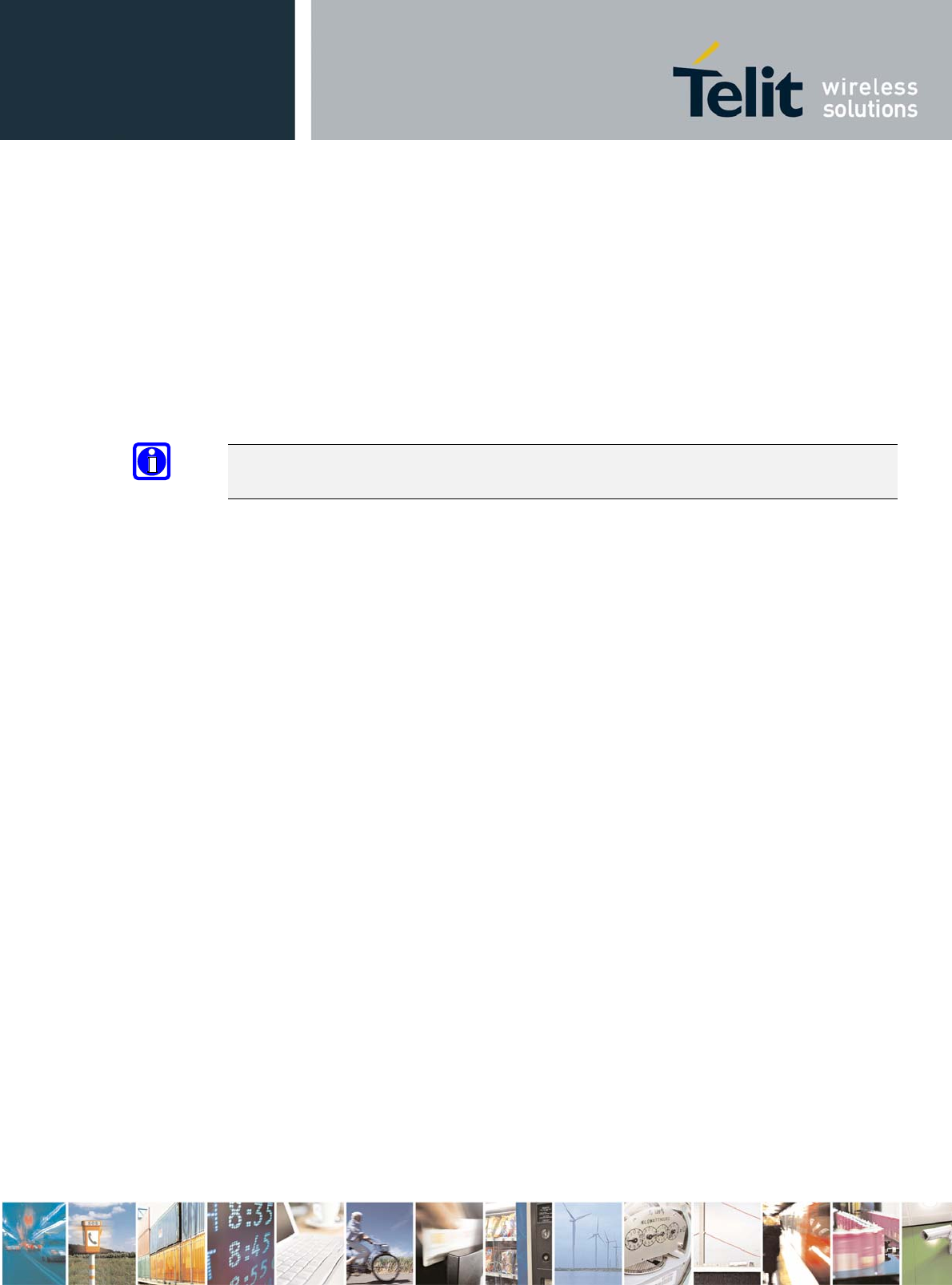
HC864-AUTO Hardware User Guide
1vv0300946 Rev.4 – 2012-12-27
Reproduction forbidden without written authorization from Telit Communications S.p.A. - All Rights
Reserved. Page 55 of 77
11.4. Using the Alarm Output GPIO6
The GPIO6 pad, when configured as Alarm Output, is controlled by the HC864-AUTO
module and will rise when the alarm starts and fall after the issue of a dedicated AT command.
This output can be used to power up the HC864-AUTO controlling microcontroller or
application at the alarm time, giving you the possibility to program a timely system wake-up
to achieve some periodic actions and completely turn off either the application or the HC864-
AUTO during sleep periods. This will dramatically reduce the sleep consumption to few A.
In battery-powered devices this feature will greatly improve the autonomy of the device.
NOTE:
During RESET the line is set to HIGH logic level.

HC864-AUTO Hardware User Guide
1vv0300946 Rev.4 – 2012-12-27
Reproduction forbidden without written authorization from Telit Communications S.p.A. - All Rights
Reserved. Page 56 of 77
11.5. Using the Temperature Monitor Function
11.5.1. Short Description
The Temperature Monitor is a function of the module that permits to control its internal
temperature and if properly set (see the #TEMPMON command on AT Interface guide) it
raises to High Logic level a GPIO when the maximum temperature is reached.
11.5.2. Allowed GPIO
The AT#TEMPMON set command could be used with one of the following GPIO:
Signal Function Type Drive
strength Note
GPIO_01 GPIO01 Configurable GPIO CMOS 1.8V 2mA
GPIO_03 GPIO03 Configurable GPIO CMOS 1.8V 2mA
GPIO_08 GPIO08 Configurable GPIO CMOS 1.8V 2mA
GPIO_09 GPIO09 Configurable GPIO CMOS 1.8V 2mA
GPIO_10 GPIO10 Configurable GPIO CMOS 2.6V 2mA
GPIO_11 GPIO11 Configurable GPIO CMOS 1.8V 2mA
GPIO_12 GPIO12 Configurable GPIO CMOS 1.8V 2mA
GPIO_13 GPIO13 Configurable GPIO CMOS 1.8V 2mA
GPIO_14 GPIO14 Configurable GPIO CMOS 1.8V 2mA
GPIO_15 GPIO15 Configurable GPIO CMOS 1.8V 2mA
GPIO_16 GPIO16 Configurable GPIO CMOS 1.8V 2mA
GPIO_17 GPIO17 Configurable GPIO CMOS 2.6V 2mA
GPIO_18 GPIO18 Configurable GPIO CMOS 2.6V 2mA
GPIO_19 GPIO19 Configurable GPIO CMOS 1.8V 2mA
GPIO_20 GPIO20 Configurable GPIO CMOS 1.8V 2mA
GPIO_22 GPIO22 Configurable GPIO CMOS 1.8V 2mA
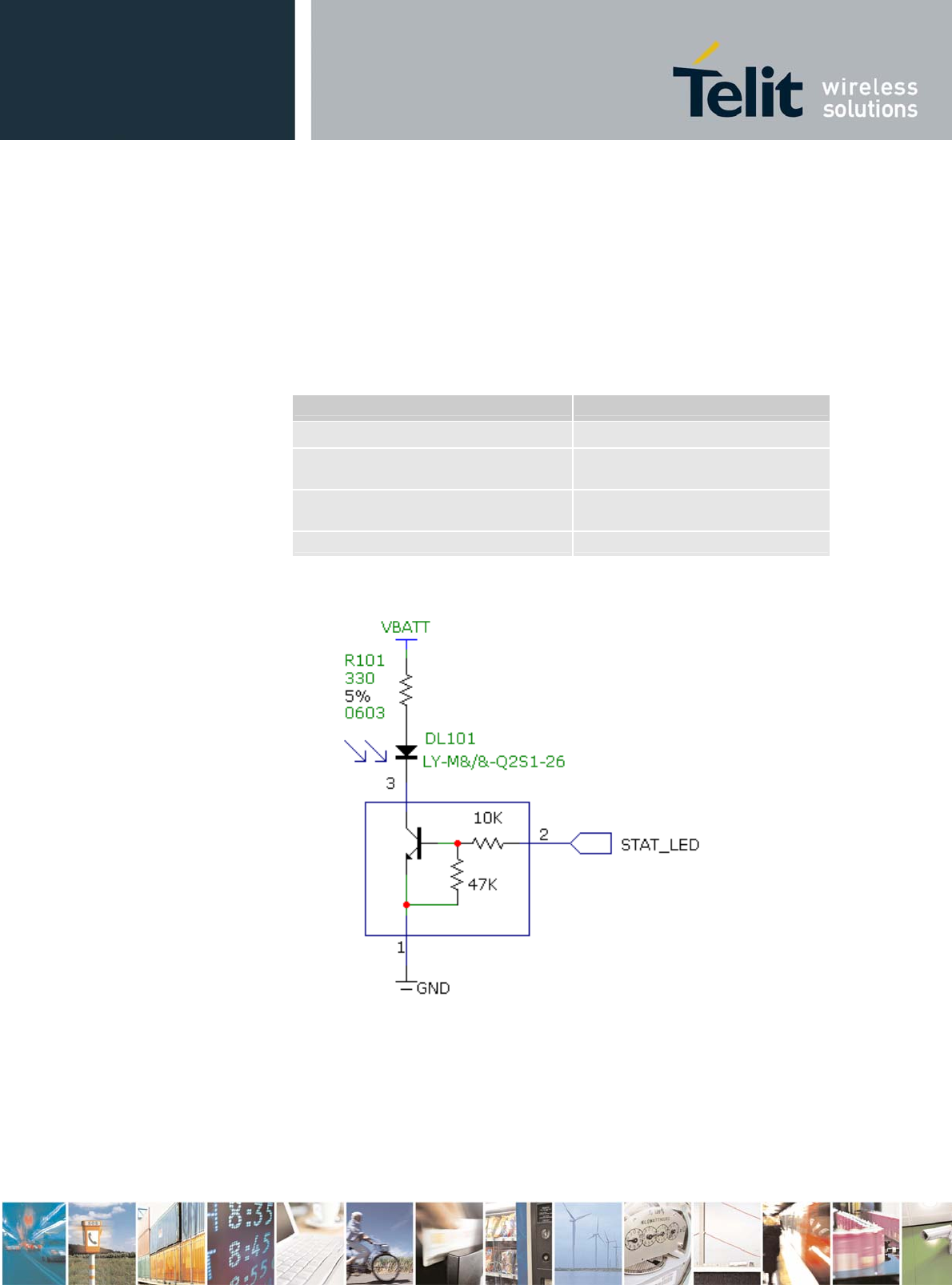
HC864-AUTO Hardware User Guide
1vv0300946 Rev.4 – 2012-12-27
Reproduction forbidden without written authorization from Telit Communications S.p.A. - All Rights
Reserved. Page 57 of 77
11.6. Indication of Network Service Availability
The STAT_LED pin status shows information on the network service availability and Call
status. In the HC864-AUTO modules, the STAT_LED usually needs an external transistor to
drive an external LED. Because of the above, the status indicated in the following table is
reversed with respect to the pin status:
LED status Device Status
Permanently off Device off
Fast blinking
(Period 1s, Ton 0,5s)
Net search / Not registered /
turning off
Slow blinking
(Period 3s, Ton 0,3s)
Registered full service
Permanently on a call is active
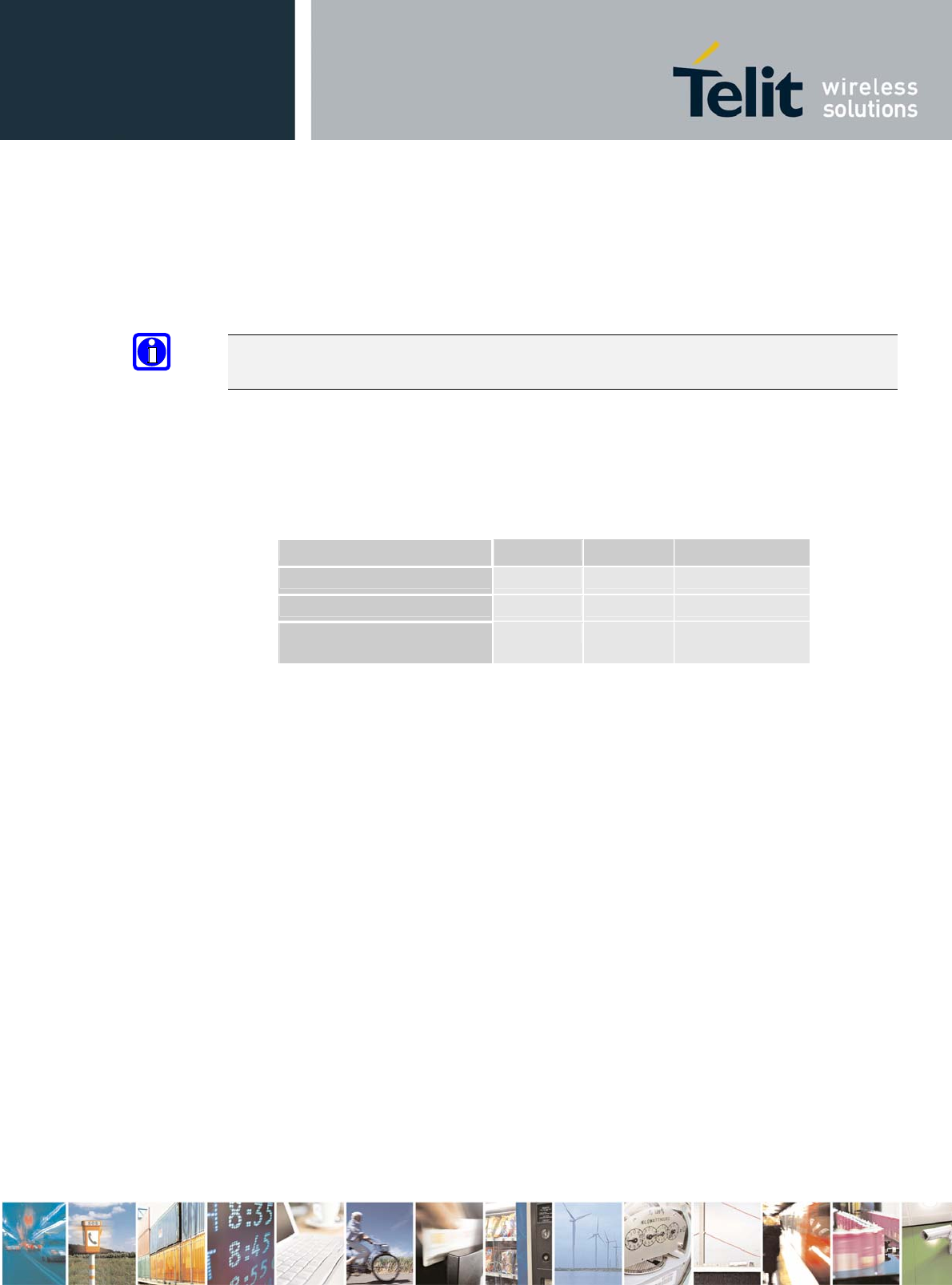
HC864-AUTO Hardware User Guide
1vv0300946 Rev.4 – 2012-12-27
Reproduction forbidden without written authorization from Telit Communications S.p.A. - All Rights
Reserved. Page 58 of 77
11.7. RTC Bypass Out
The VRTC pin brings out the Real Time Clock supply, which is separate from the rest of the
digital part, allowing having only RTC going on when all the other parts of the device are off.
To this power output a backup capacitor can be added in order to increase the RTC autonomy
during power off of the battery.
NOTE:
NO devices must be powered from this pin.
11.8. VAUX1 Power Output
A regulated power supply output is provided in order to supply small devices from the
module. This output is active when the module is ON and goes OFF when the module is shut
down. The operating range characteristics of the supply are:
Operating Range – VAUX1 power supply
Min Typical Max
Output voltage 2.6V 2.65V 2.7V
Output current 100mA
Output bypass capacitor
(Inside the module) 2.2F
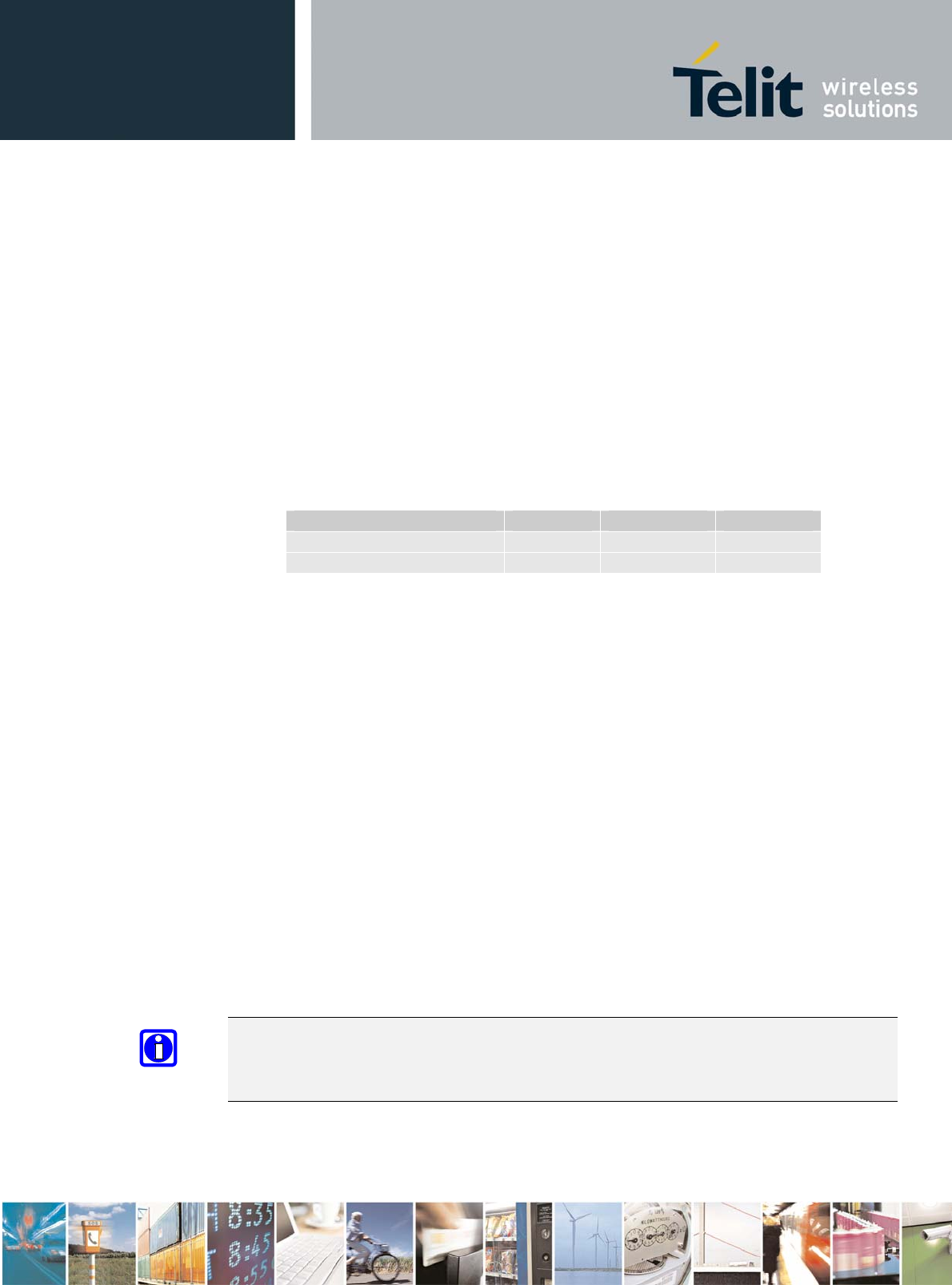
HC864-AUTO Hardware User Guide
1vv0300946 Rev.4 – 2012-12-27
Reproduction forbidden without written authorization from Telit Communications S.p.A. - All Rights
Reserved. Page 59 of 77
12. DAC and ADC section
12.1. DAC Converter
12.1.1. Description
The HC864-AUTO module provides a Digital to Analog Converter. The signal (named
DAC_OUT) is available on pin 40 of the HC864-AUTO module and on pin 17 of PL102 on
EVK2 Board (CS1203).
The on board DAC is in the range from 0 to 1023.
However, an external low-pass filter is necessary.
Min Max Units
Voltage range (filtered) 0 1.8 Volt
Range 0 1023 Steps
The precision is 1023 steps, so if we consider that the maximum voltage is 2V, the integrated
voltage could be calculated with the following formula:
Integrated output voltage = 2 * value / 1023
DAC_OUT line must be integrated (for example with a low band pass filter) in order to obtain
an analog voltage.
12.1.2. Enabling DAC
An AT command is available to use the DAC function.
The command is:AT#DAC[=<enable>[,<value>]]
<value> - scale factor of the integrated output voltage (0..1023 - 10 bit precision)
it must be present if <enable>=1
Refer to SW User Guide or AT Commands Reference Guide for the full description of this
function.
NOTE:
The DAC frequency is selected internally. D/A converter must not be used during
POWERSAVING.
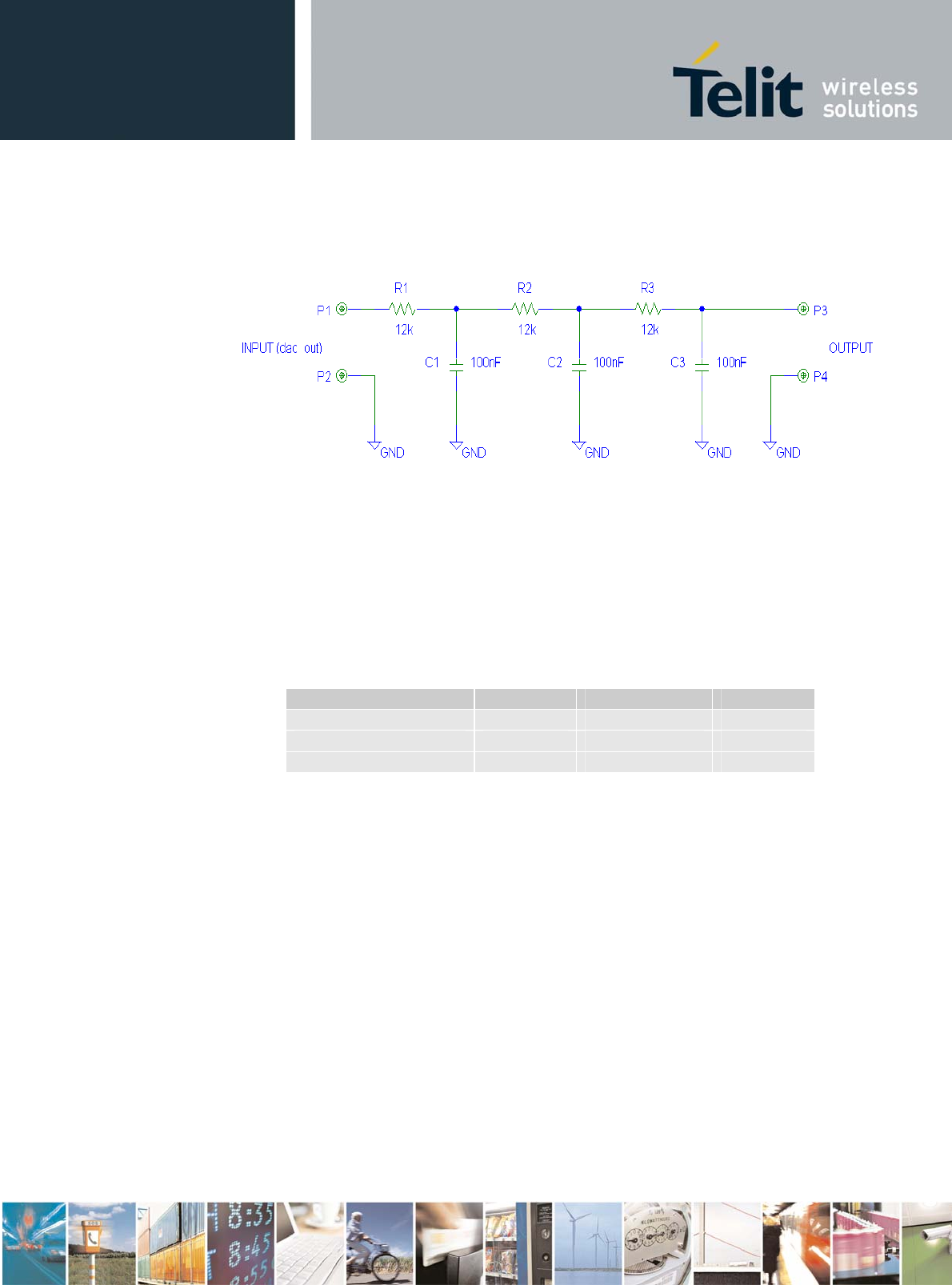
HC864-AUTO Hardware User Guide
1vv0300946 Rev.4 – 2012-12-27
Reproduction forbidden without written authorization from Telit Communications S.p.A. - All Rights
Reserved. Page 60 of 77
12.1.3. Low Pass Filter Example
.
12.2. ADC Converter
12.2.1. Description
The on board ADCs are 8-bit converters. They are able to read a voltage level in the range of
0-2 volts applied on the ADC pin input and store and convert it into 8 bit word.
Min Max Units
Input Voltage range 0 2.0 Volt
AD conversion - 8 bits
Resolution - < 8.6 mV
The HC864-AUTO module provides 2 Analog to Digital Converters.
The input lines are:
ADC_IN1 available on Pin 37 and Pin 19 of PL102 on EVK2 Board (CS1203)
ADC_IN2 available on Pin 38 and Pin 20 of PL102 on EVK2 Board (CS1203)
12.2.2. Using ADC Converter
An AT command is available to use the ADC function.
The command is AT#ADC=1,2 The read value is expressed in mV
Refer to SW User Guide or AT Commands Reference Guide for the full description of this
function.

HC864-AUTO Hardware User Guide
1vv0300946 Rev.4 – 2012-12-27
Reproduction forbidden without written authorization from Telit Communications S.p.A. - All Rights
Reserved. Page 61 of 77
13. Accelerometer
13.1. Description
HC864-AUTO has a tri-axial, low-g acceleration sensor IC which is one of the BOSCH
products.
It can sense the factors such as tilt, motion and shock vibration so on.
Please refer to the “HC864-AUTO AT Command Reference Guide” for the detailed use.
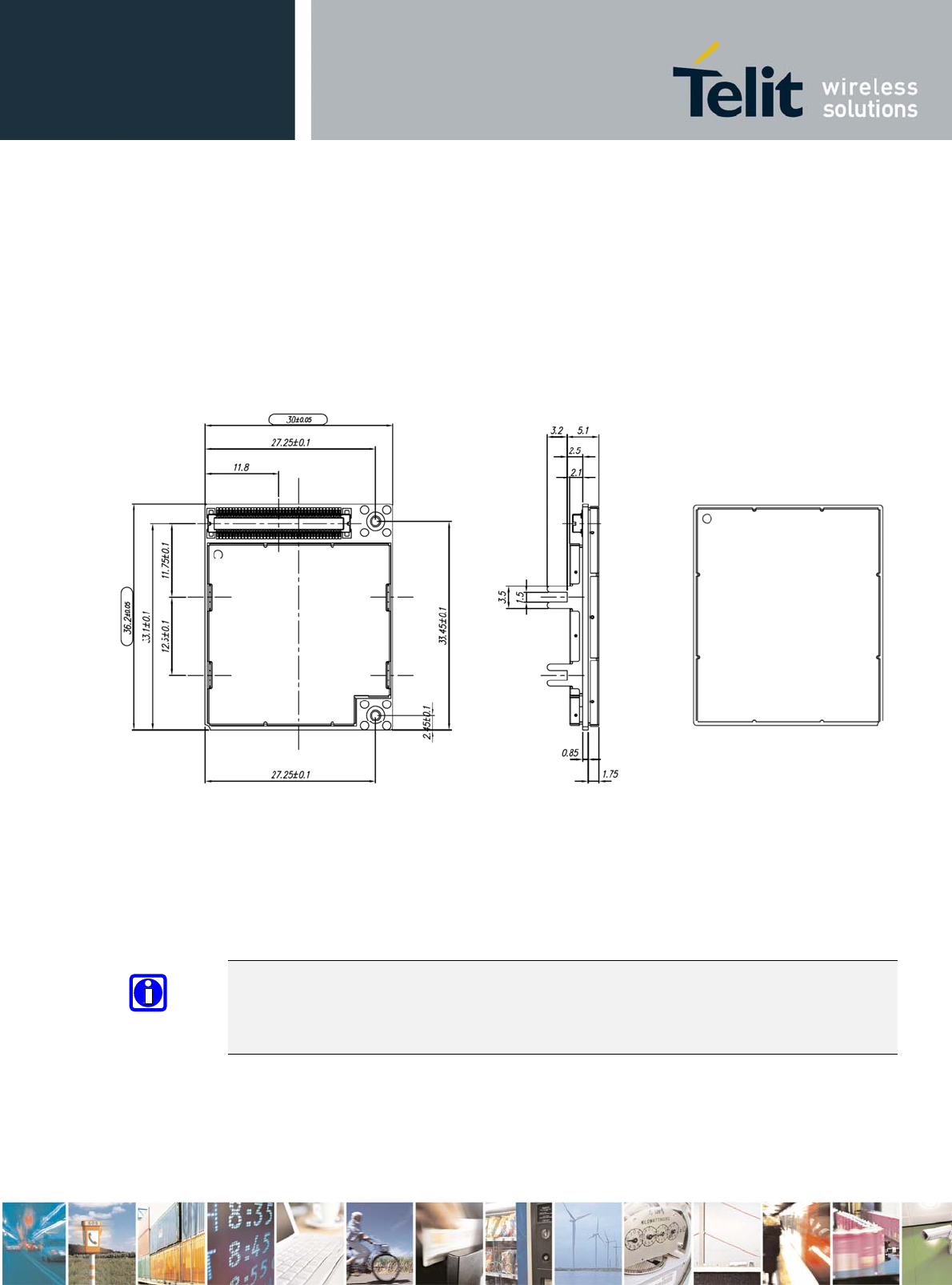
HC864-AUTO Hardware User Guide
1vv0300946 Rev.4 – 2012-12-27
Reproduction forbidden without written authorization from Telit Communications S.p.A. - All Rights
Reserved. Page 62 of 77
14. Mounting the module on your board
The position of the Molex board-to-board connector and pin 1 are shown in the following
picture.
NOTE:
The Metal taps present on HC864-AUTO must be connected to GND.
This module could not be processed with a reflow.
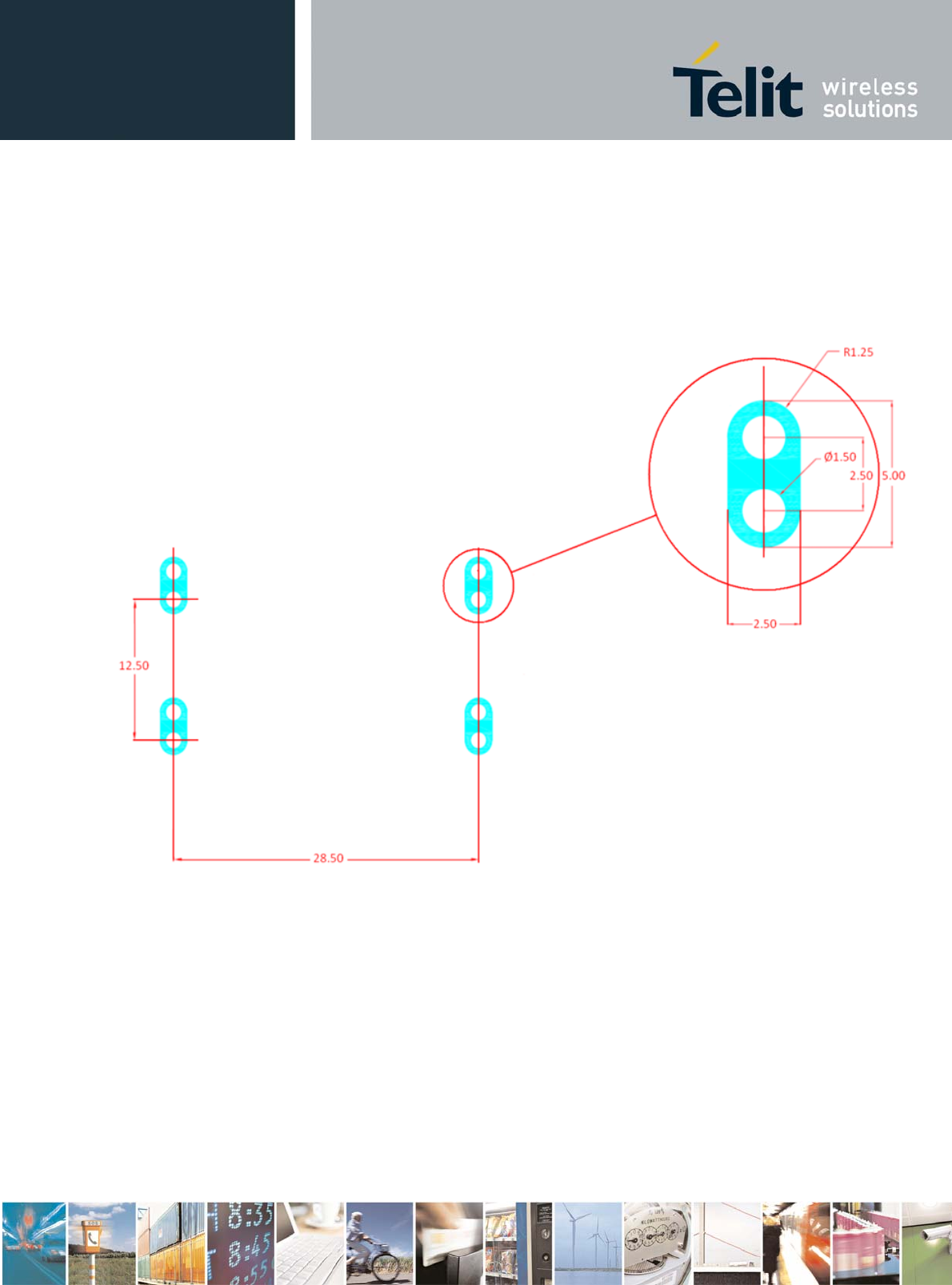
HC864-AUTO Hardware User Guide
1vv0300946 Rev.4 – 2012-12-27
Reproduction forbidden without written authorization from Telit Communications S.p.A. - All Rights
Reserved. Page 63 of 77
14.1. Application PCB layout
To obtain the best thermal dissipation it is suggested to design the host PCB as in the below
image where a Ground area has been created below the module.
Bottom side
Top View
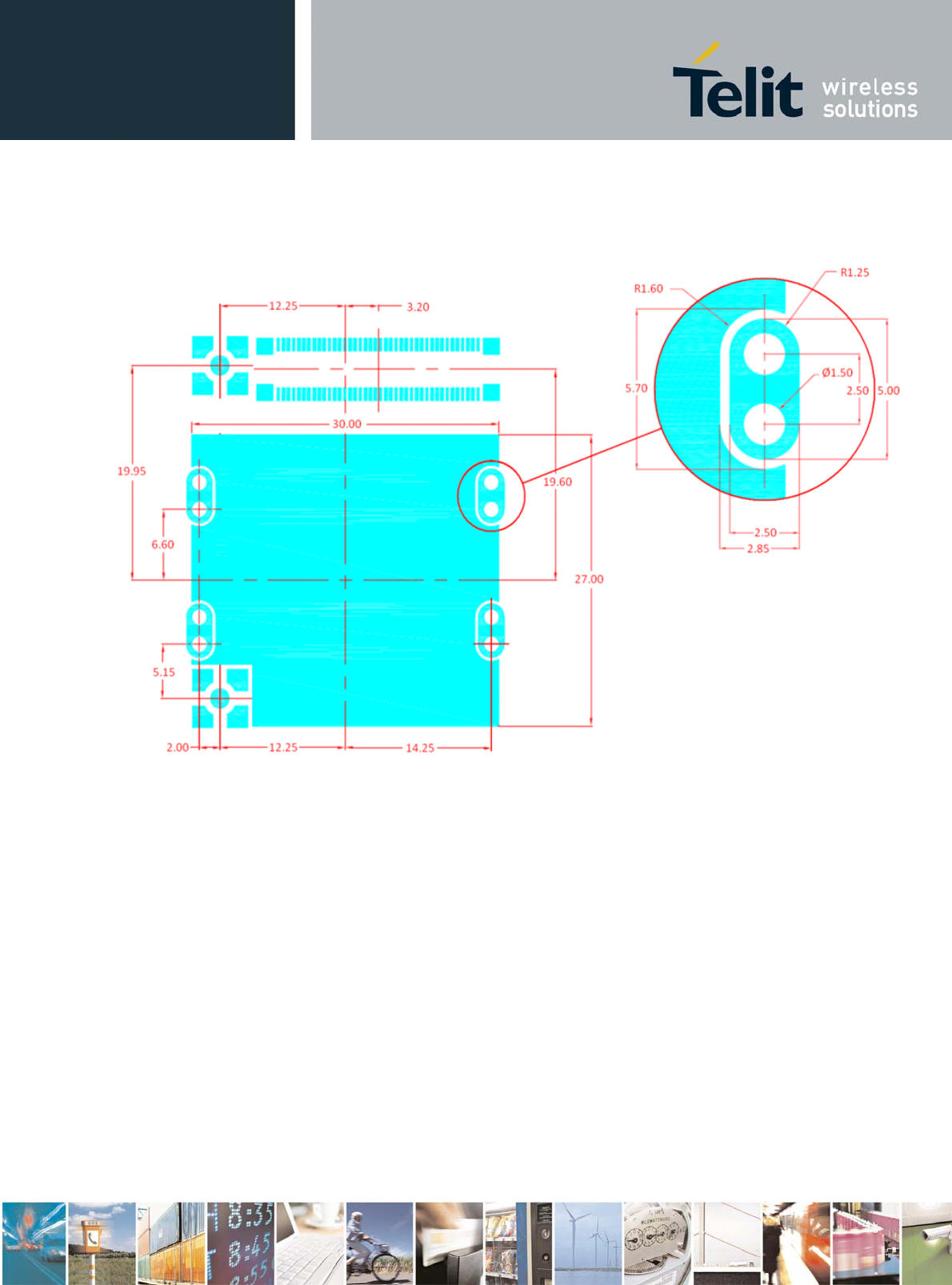
HC864-AUTO Hardware User Guide
1vv0300946 Rev.4 – 2012-12-27
Reproduction forbidden without written authorization from Telit Communications S.p.A. - All Rights
Reserved. Page 64 of 77
Top side
Top View
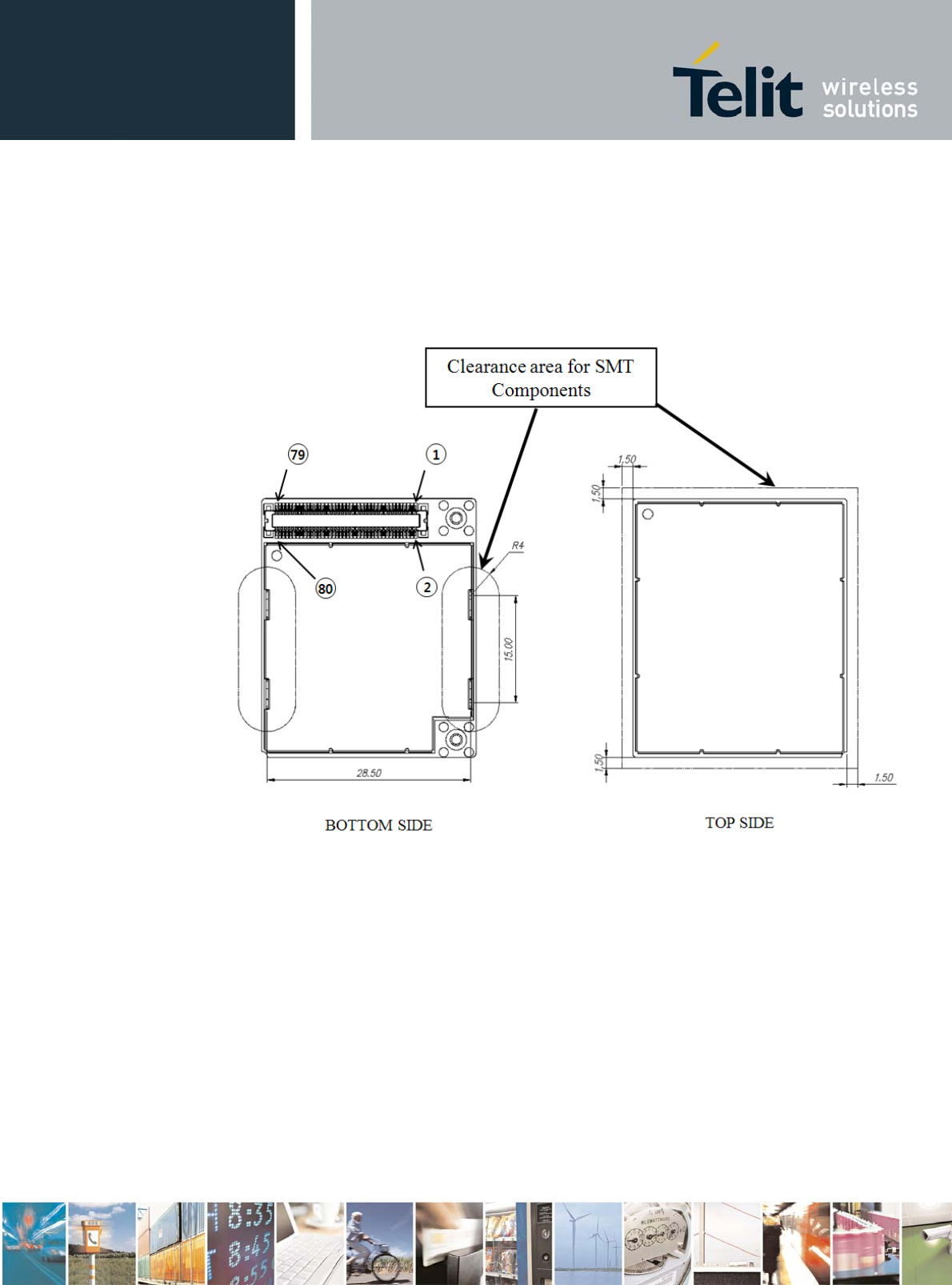
HC864-AUTO Hardware User Guide
1vv0300946 Rev.4 – 2012-12-27
Reproduction forbidden without written authorization from Telit Communications S.p.A. - All Rights
Reserved. Page 65 of 77
14.2. Clearance Area
14.3. Thermal Dissipation
To permit a better thermal dissipation it is suggested to use a Thermal conductive material
between the module and the application PCB.
Suggested types are Bergquist (Two parts) GAP filler 3500 or GAP Filler 1500

HC864-AUTO Hardware User Guide
1vv0300946 Rev.4 – 2012-12-27
Reproduction forbidden without written authorization from Telit Communications S.p.A. - All Rights
Reserved. Page 66 of 77
14.4. Module Soldering
The module could be soldered on the application in different kind of ways. Typical processes
are follows:
z Manual Soldering
z Automatic Selective soldering
z Wave soldering
We suggest respecting necessary Clearance area in the design to permit a proper soldering
process as shown in previous chapter.

HC864-AUTO Hardware User Guide
1vv0300946 Rev.4 – 2012-12-27
Reproduction forbidden without written authorization from Telit Communications S.p.A. - All Rights
Reserved. Page 67 of 77
15. Application guide
15.1. Debug of the HC864-AUTO in production
To test and debug the mounting of HC864-AUTO, we strongly recommend to foresee test
pads on the host PCB, in order to check the connection between the HC864-AUTO itself and
the application and to test the performance of the module connecting it with an external
computer. Depending on the customer application, these pads include, but are not limited to
the following signals:
• TXD
• RXD
• ON/OFF
• RESET
• GND
• VBATT
• TX_TRACE
• RX_TRACE
• PWRMON
• USB_VBUS
• USB_D+
• USB_D-

HC864-AUTO Hardware User Guide
1vv0300946 Rev.4 – 2012-12-27
Reproduction forbidden without written authorization from Telit Communications S.p.A. - All Rights
Reserved. Page 68 of 77
15.2. Bypass capacitor on Power supplies
When a sudden voltage is asserted to or cut from the power supplies,
The steep transition makes some reactions such as the overshoot and undershoot.
This abrupt voltage transition can affect the device not to work or make it malfunction.
The bypass capacitors are needed to alleviate this behavior and it can be affected
differently according to the various applications. The customers have to pay special
attention to this when they design their application board..
The length and width of the power lines need to be considered carefully and the
capacitance of the capacitors need to be selected accordingly.
The capacitor will also avoid the ripple of the power supplies and the switching noise
caused in TDMA system like GSM.
Specially the suitable bypass capacitor must be mounted on the Vbatt (Pin 1,2,3,4)
lines in the application board.
The recommended values can be presented as;
z 100uF for Vbatt
But the customers still have to consider that the capacitance mainly depends on the
conditions of their application board.
Generally more capacitance is required as the power line is longer.
15.3. SIM interface
The resistor value on SIMIO pulled up to SIMVCC should be defined accordingly in
order to be compliant to 3GPP specification.
6.8kohm can be recommended but it may depend on the application design.
Refer to the following document for the detail;
z Telit_SIM_interface_and ESD_protection_Application_note_r1
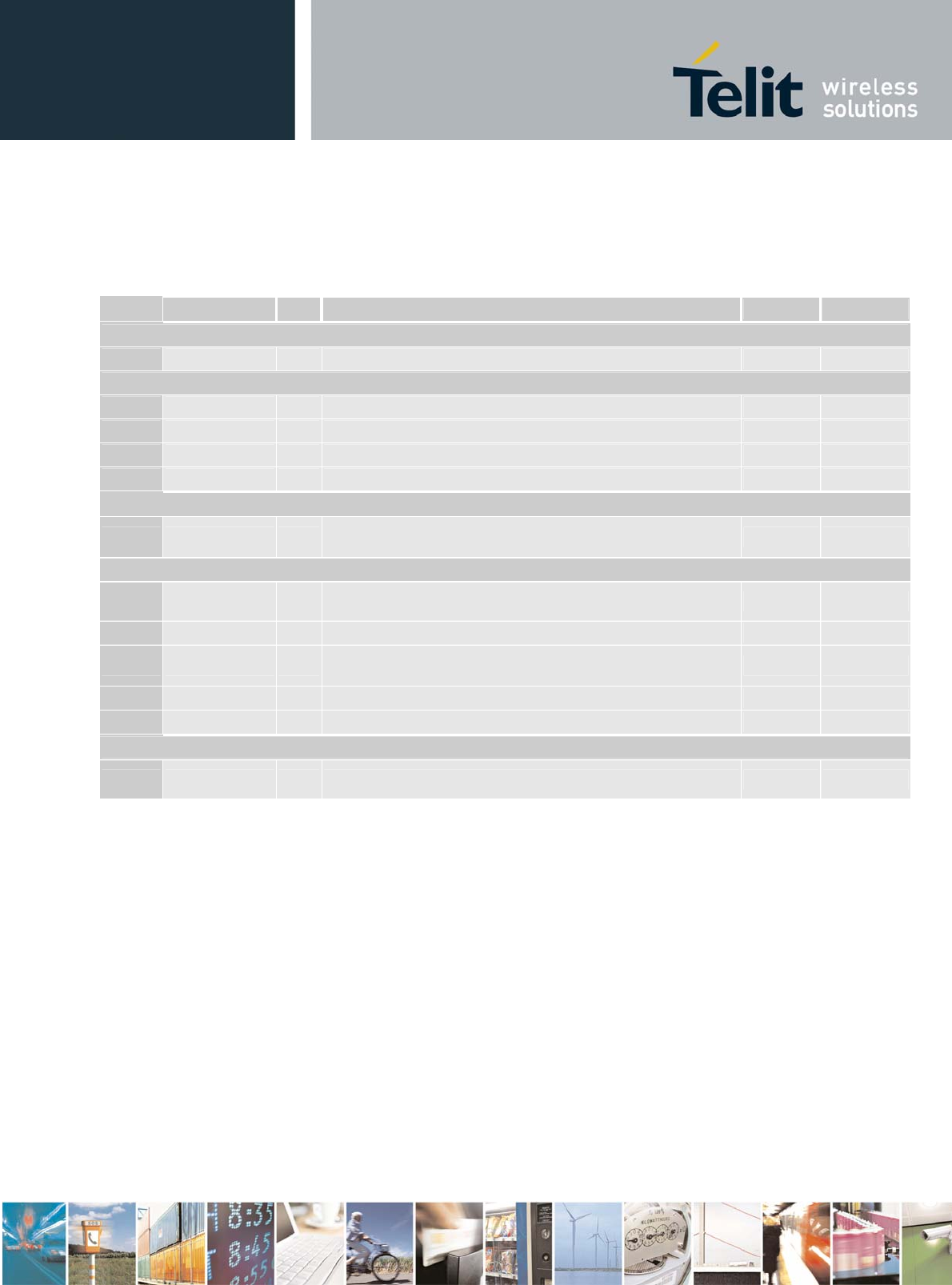
HC864-AUTO Hardware User Guide
1vv0300946 Rev.4 – 2012-12-27
Reproduction forbidden without written authorization from Telit Communications S.p.A. - All Rights
Reserved. Page 69 of 77
15.4. EMC recommendations
HC864-AUTO signals are provided by some EMC protections. In any case the accepted
levels are different on the pins. The characteristics are described in the following Table:
Pin Signal I/O Function Contact Air
Power Supply
1,2,3,4 VBATT - Main power supply ± 8KV ± 15KV
SIM Card Interface
18 SIMVCC - External SIM signal – Power supply for the SIM ± 8KV ± 15KV
19 SIMRST O External SIM signal – Reset ± 8KV ± 15KV
20 SIMIO I/O External SIM signal - Data I/O ± 8KV ± 15KV
22 SIMCLK O External SIM signal – Clock ± 8KV ± 15KV
Miscellaneous Functions
35 USB_ID AI Analog input used to sense whether a peripheral device is
connected ± 8KV ± 15KV
Miscellaneous Functions
48 USB_VBUS AI Power sense for the internal USB transceiver ± 8KV ± 15KV
50 VAUX1 - Power output for external accessories ± 8KV ± 15KV
53 ON/OFF I Input command for switching power ON or OFF (toggle
command). ± 8KV ± 15KV
54 RESET I Reset input ± 8KV ± 15KV
55 VRTC AO Power supply for RTC block ± 8KV ± 15KV
Antenna
PAD Antenna Pad AI Antenna pad for Rosenberger connector ± 8KV ± 15KV
All other pins have the following characteristics:
HBM JESD22-A114-B ± 2000 V
CDM JESD22-C101-C ± 500 V
The Board to Board connector has to be considered as NO TOUCH area.
Appropriate series resistors have to be considered to protect the input lines from overvoltage.

HC864-AUTO Hardware User Guide
1vv0300946 Rev.4 – 2012-12-27
Reproduction forbidden without written authorization from Telit Communications S.p.A. - All Rights
Reserved. Page 70 of 77
15.5. Download and Debug Port
One of the following options should be chosen in the design of host system in order to
download or upgrade the Telit’s software and debug HC864-AUTO when HC864-AUTO is
already mounted on a host system.
Users who use both of UART and USB interfaces to communicate HC864-AUTO
- Must implement a download method in a host system for upgrading HC864-AUTO when
it’s mounted.
Users who use USB interface only to communicate HC864-AUTO
- Must arrange UART port in a host system for debugging or upgrading HC864-AUTO
when it’s mounted.
Users who use UART interface only to communicate HC864-AUTO
- Must arrange USB port in a host system for debugging or upgrading HC864-AUTO when
it’s mounted.
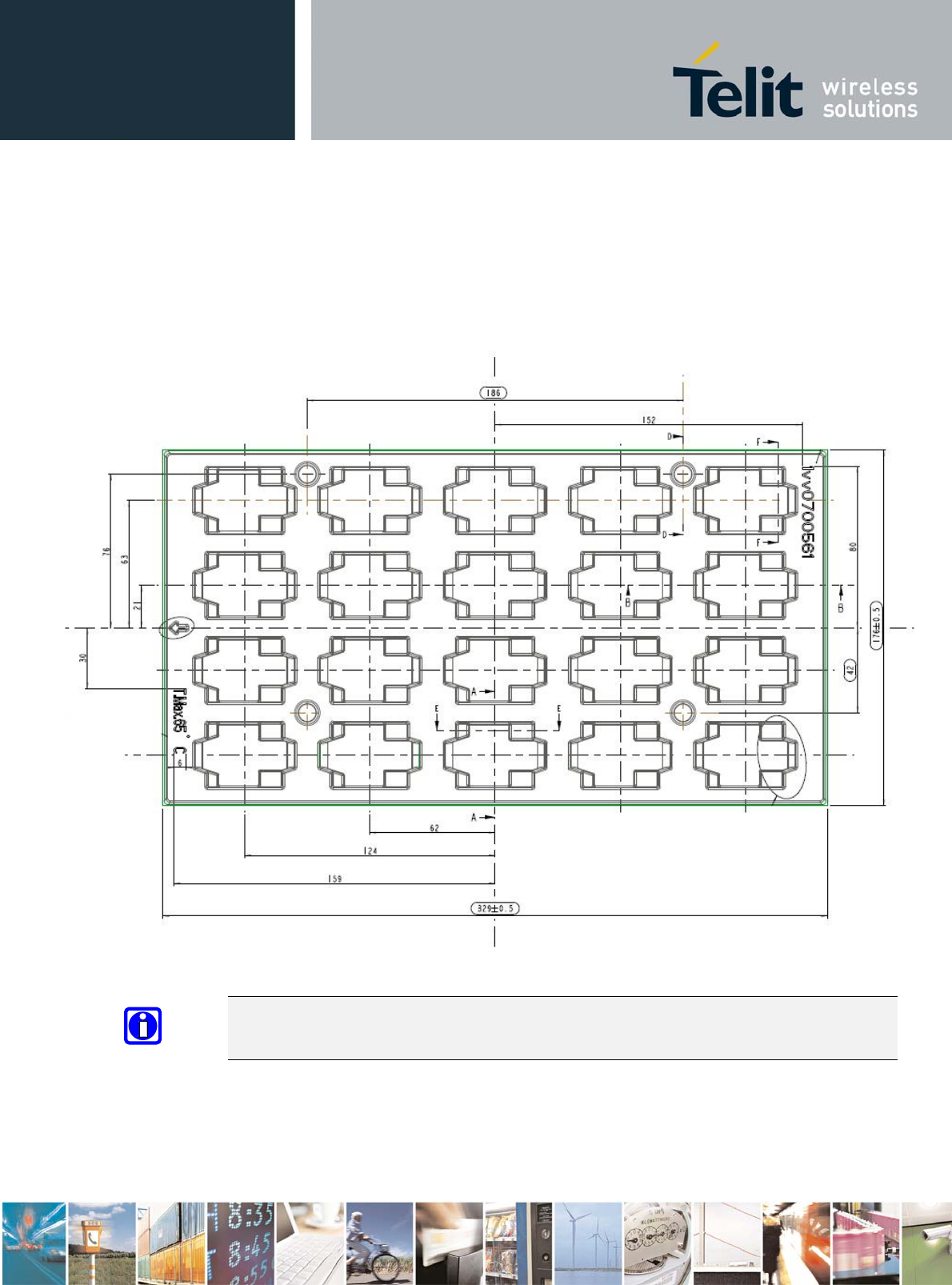
HC864-AUTO Hardware User Guide
1vv0300946 Rev.4 – 2012-12-27
Reproduction forbidden without written authorization from Telit Communications S.p.A. - All Rights
Reserved. Page 71 of 77
16. Packing system
The Telit HC864-AUTO is packaged on trays. Each tray contains 20 pieces with the
following dimensions:
NOTE:
Trays can withstand the maximum temperature of 65° C.
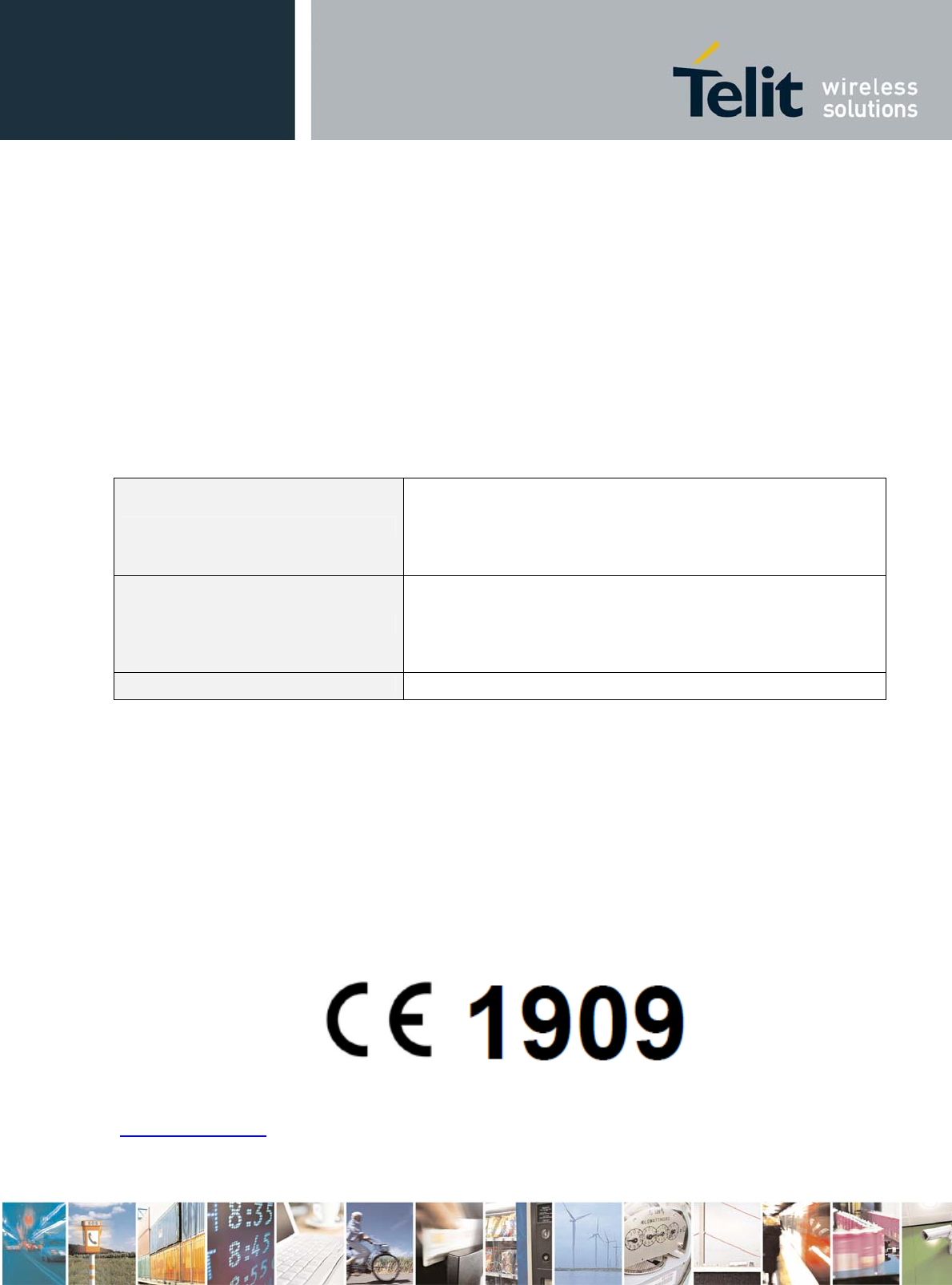
HC864-AUTO Hardware User Guide
1vv0300946 Rev.4 – 2012-12-27
Reproduction forbidden without written authorization from Telit Communications S.p.A. - All Rights
Reserved. Page 72 of 77
17. Conformity Assessment Issues
17.1. 1999/5/EC Directive
The HC864-AUTO module has been assessed in order to satisfy the essential requirements
of the R&TTE Directive 1999/05/EC (Radio Equipment & Telecommunications Terminal Equipments)
to demonstrate the conformity against the harmonized standards with the final involvement of a
Notified Body.
In order to satisfy the essential requirements of 1999/5/EC Directive, the HC864-AUTO is compliant with the
following standards:
RF spectrum use (R&TTE art. 3.2)
EN 300 440-2 V1.4.1
EN 301 511 V9.0.2
EN 301 908-1 V5.2.1
EN 301 908-2 V5.2.1
EMC (R&TTE art. 3.1b)
EN 301 489-1 V1.9.2
EN 301 489-3 V1.4.1
EN 301 489-7 V1.3.1
EN 301 489-24 V1.5.1
Health & Safety (R&TTE art. 3.1a) EN 60950-1:2006 + A11:2009 + A1:2010 + A12:2011+AC:2011
The conformity assessment procedure referred to in Article 10 and detailed in Annex IV of Directive
1999/5/EC has been followed with the involvement of the following Notified Body:
AT4 wireless, S.A.
Parque Tecnologico de Andalucía
C/ Severo Ochoa 2
29590 Campanillas – Málaga
SPAIN
Notified Body No: 1909
Thus, the following marking is included in the product:
The full declaration of conformity can be found on the following address:
http://www.telit.com
There is no restriction for the commercialization of the HC864-AUTO module in all the countries of the
European Union.
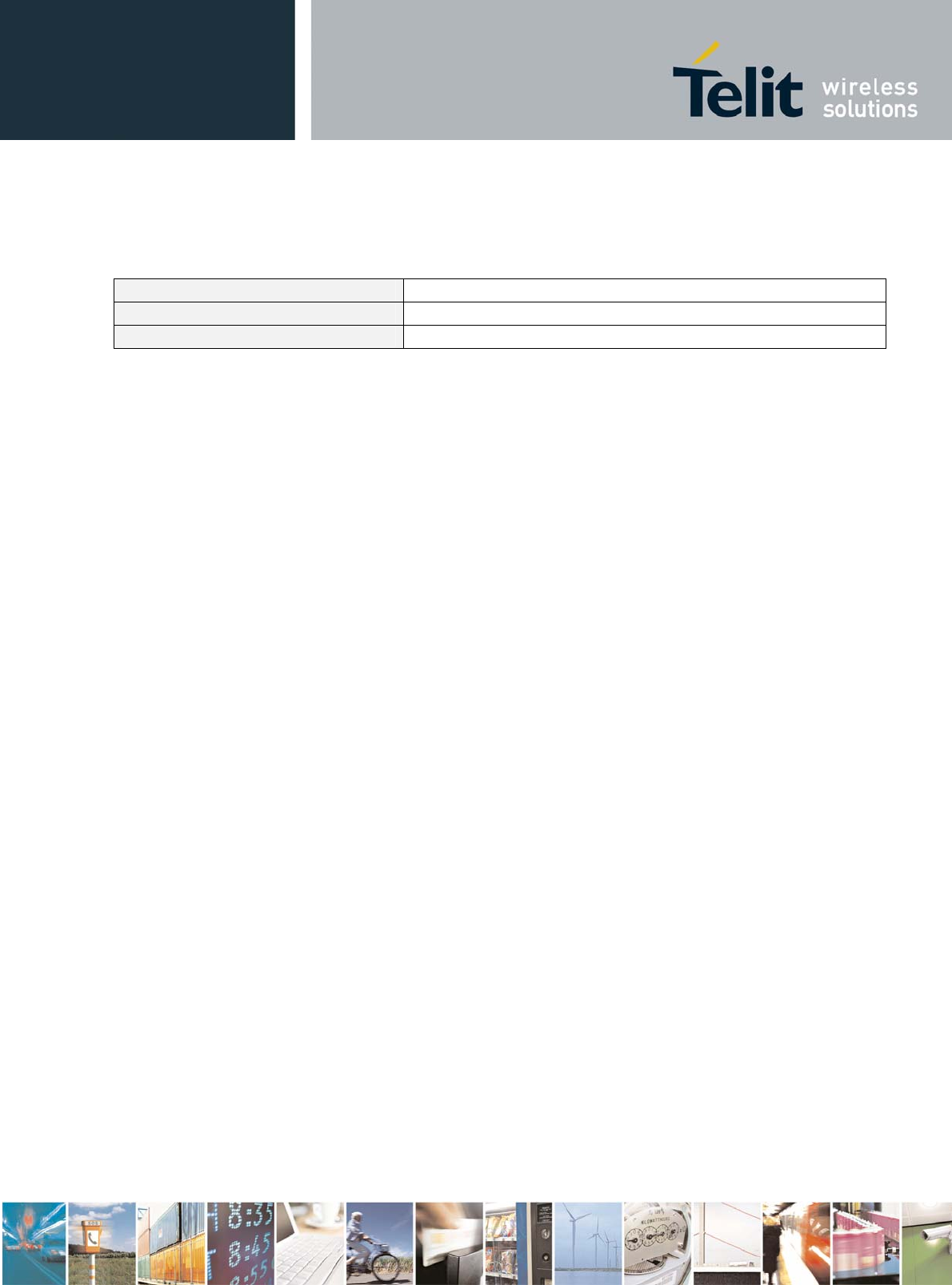
HC864-AUTO Hardware User Guide
1vv0300946 Rev.4 – 2012-12-27
Reproduction forbidden without written authorization from Telit Communications S.p.A. - All Rights
Reserved. Page 73 of 77
Final product integrating this module must be assessed against essential requirements of the 1999/5/EC
(R&TTE) Directive. It should be noted that assessment does not necessarily lead to testing. Telit
Communications S.p.A. recommends carrying out the following assessments:
RF spectrum use (R&TTE art. 3.2) It will depend on the antenna used on the final product.
EMC (R&TTE art. 3.1b) Testing
Health & Safety (R&TTE art. 3.1a) Testing
Alternately, assessment of the final product against EMC (Art. 3.1b) and Electrical safety (Art. 3.1a) essential
requirements can be done against the essential requirements of the EMC and the LVD Directives:
z Low Voltage Directive 2006/95/EC and product safety
z Directive EMC 2004/108/EC for conformity for EMC
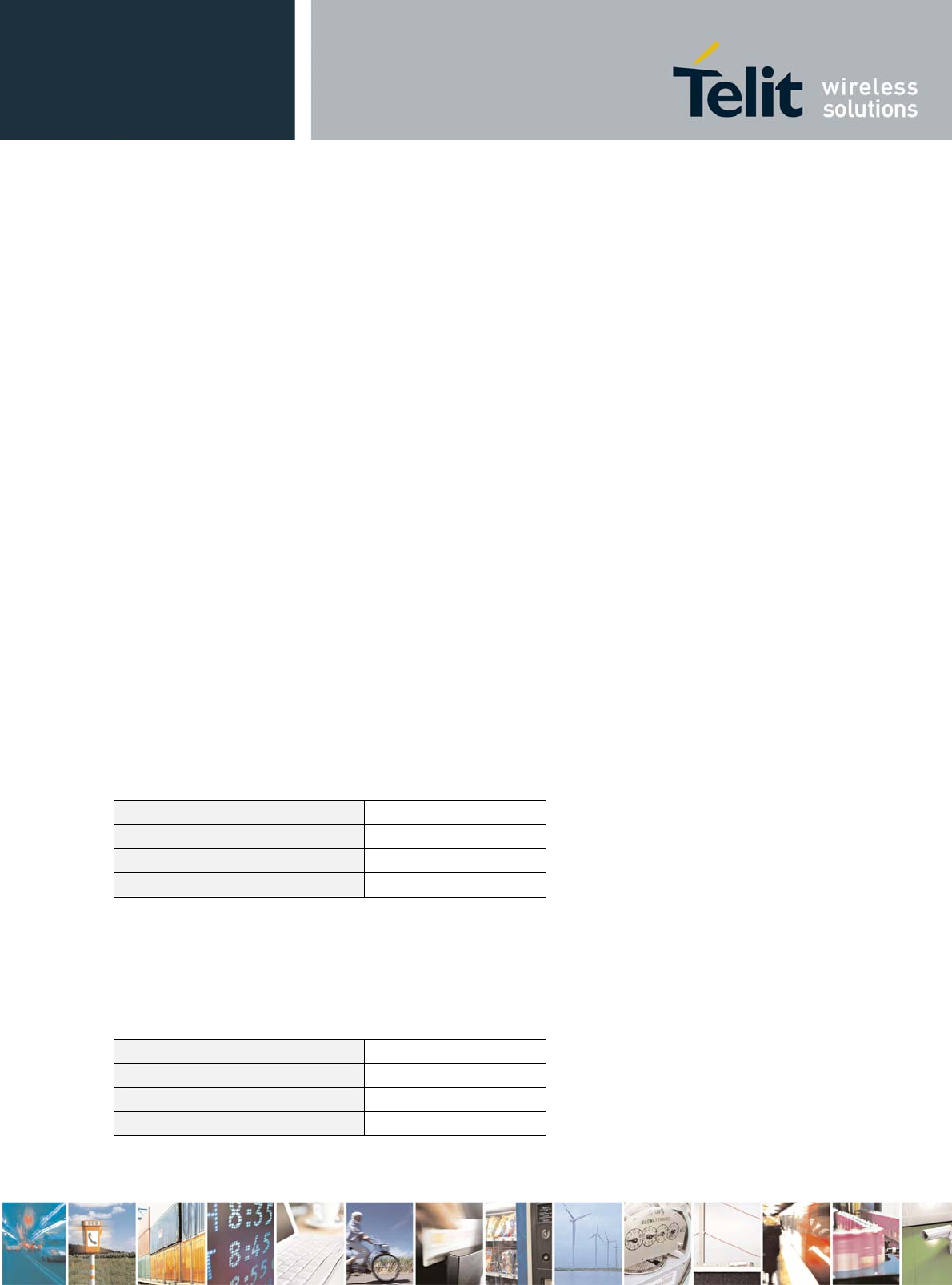
HC864-AUTO Hardware User Guide
1vv0300946 Rev.4 – 2012-12-27
Reproduction forbidden without written authorization from Telit Communications S.p.A. - All Rights
Reserved. Page 74 of 77
17.2. FCC/IC Regulatory notices
Modification statement
Telit has not approved any changes or modifications to this device by the user. Any changes or modifications
could void the user’s authority to operate the equipment.
Telit n’approuve aucune modification apportée à l’appareil par l’utilisateur, quelle qu’en soit la nature. Tout
changement ou modification peuvent annuler le droit d’utilisation de l’appareil par l’utilisateur.
Interference statement
This device complies with Part 15 of the FCC Rules and Industry Canada licence-exempt RSS standard(s).
Operation is subject to the following two conditions: (1) this device may not cause interference, and (2) this
device must accept any interference, including interference that may cause undesired operation of the device.
This Class B digital apparatus complies with Canadian ICES-0003.
Le présent appareil est conforme aux CNR d'Industrie Canada applicables aux appareils radio exempts de
licence. L'exploitation est autorisée aux deux conditions suivantes : (1) l'appareil ne doit pas produire de
brouillage, et (2) l'utilisateur de l'appareil doit accepter tout brouillage radioélectrique subi, même si le
brouillage est susceptible d'en compromettre le fonctionnement.
Wireless notice
This equipment complies with FCC and IC radiation exposure limits set forth for an uncontrolled environment.
The antenna should be installed and operated with minimum distance of 20 cm between the radiator and your
body. Antenna gain must be below:
Frequency band HC864-AUTO
GSM850 /FDD V 2.0 dBi
PCS1900 /FDD II 2.0 dBi
FDD IV 2.0 dBi
This transmitter must not be co-located or operating in conjunction with any other antenna or transmitter.
Cet appareil est conforme aux limites d'exposition aux rayonnements de la IC pour un environnement non
contrôlé. L'antenne doit être installé de façon à garder une distance minimale de 20 centimètres entre la
source de rayonnements et votre corps. Gain de l'antenne doit être ci-dessous:
Bande de fréquence HC864-AUTO
GSM850 /FDD V 2.0 dBi
PCS1900 /FDD II 2.0 dBi
FDD IV 2.0 dBi
L'émetteur ne doit pas être colocalisé ni fonctionner conjointement avec à autre antenne ou autre émetteur.

HC864-AUTO Hardware User Guide
1vv0300946 Rev.4 – 2012-12-27
Reproduction forbidden without written authorization from Telit Communications S.p.A. - All Rights
Reserved. Page 75 of 77
FCC Class B digital device notice
This equipment has been tested and found to comply with the limits for a Class B digital device, pursuant to
part 15 of the FCC Rules. These limits are designed to provide reasonable protection against harmful
interference in a residential installation. This equipment generates, uses and can radiate radio frequency
energy and, if not installed and used in accordance with the instructions, may cause harmful interference to
radio communications. However, there is no guarantee that interference will not occur in a particular
installation. If this equipment does cause harmful interference to radio or television reception, which can be
determined by turning the equipment off and on, the user is encouraged to try to correct the interference by
one or more of the following measures:
- Reorient or relocate the receiving antenna.
- Increase the separation between the equipment and receiver.
- Connect the equipment into an outlet on a circuit different from that to which the receiver is connected.
- Consult the dealer or an experienced radio/TV technician for help.
Information To Be Supplied to the End User by the OEM or Integrator notice
Modular information form OEM Information to Be Supplied to the End User by the OEM or Integrator
The following regulatory and safety notices must be published in documentation supplied to the end user of
the product or system incorporating an adapter in compliance with local regulations. Host system must be
labeled with "Contains IC: 5131A-HC864AUTO" or "Contains FCCID:RI7HC864‐AUTO", FCC ID/IC
displayed on label.

HC864-AUTO Hardware User Guide
1vv0300946 Rev.4 – 2012-12-27
Reproduction forbidden without written authorization from Telit Communications S.p.A. - All Rights
Reserved. Page 76 of 77
18. Safety Recommendations
READ CAREFULLY!
Be sure about that the use of this product is allowed in your country and in the environment
required. The use of this product may be dangerous and has to be avoided in the following
areas:
• Where it can interfere with other electronic devices in environments such as
hospitals, airports, aircrafts, etc.
• Where there is risk of explosion such as gasoline stations, oil refineries, etc.
It is responsibility of the user to enforce the country regulation and the specific environment
regulation.
Do not disassemble the product; any mark of tampering will compromise the warranty
validity.
We recommend following the instructions of the hardware user guides for a correct wiring of
the product. The product has to be supplied with a stabilized voltage source and the wiring
has to be conforming to the security and fire prevention regulations.
The product has to be handled with care, avoiding any contact with the pins because
electrostatic discharges may damage the product itself. Same cautions have to be taken for the
SIM, checking carefully the instruction for its use. Do not insert or remove the SIM when the
product is in power saving mode.
The system integrator is responsible of the functioning of the final product; therefore, care has
to be taken to the external components of the module, as well as of any project or installation
issue, because the risk of disturbing the GSM network or external devices or having impact
on the security. Should there be any doubt, please refer to the technical documentation and the
regulations in force.
Every module has to be equipped with a proper antenna with specific characteristics. The
antenna has to be installed with care in order to avoid any interference with other electronic
devices and has to be installed with the guarantee of a minimum 20 cm distance from the
body. In case of this requirement cannot be satisfied, the system integrator has to assess the
final product against the SAR regulation.
The European Community provides some Directives for the electronic equipments introduced
on the market. All the relevant information are available on the European Community
website:
http://europa.eu.int/comm/enterprise/rtte/dir99-5.htm
The text of the Directive 99/05 regarding telecommunication equipments is available, while
the applicable Directives (Low Voltage and EMC) are available at:
http://europa.eu.int/comm/enterprise/electr_equipment/index_en.htm
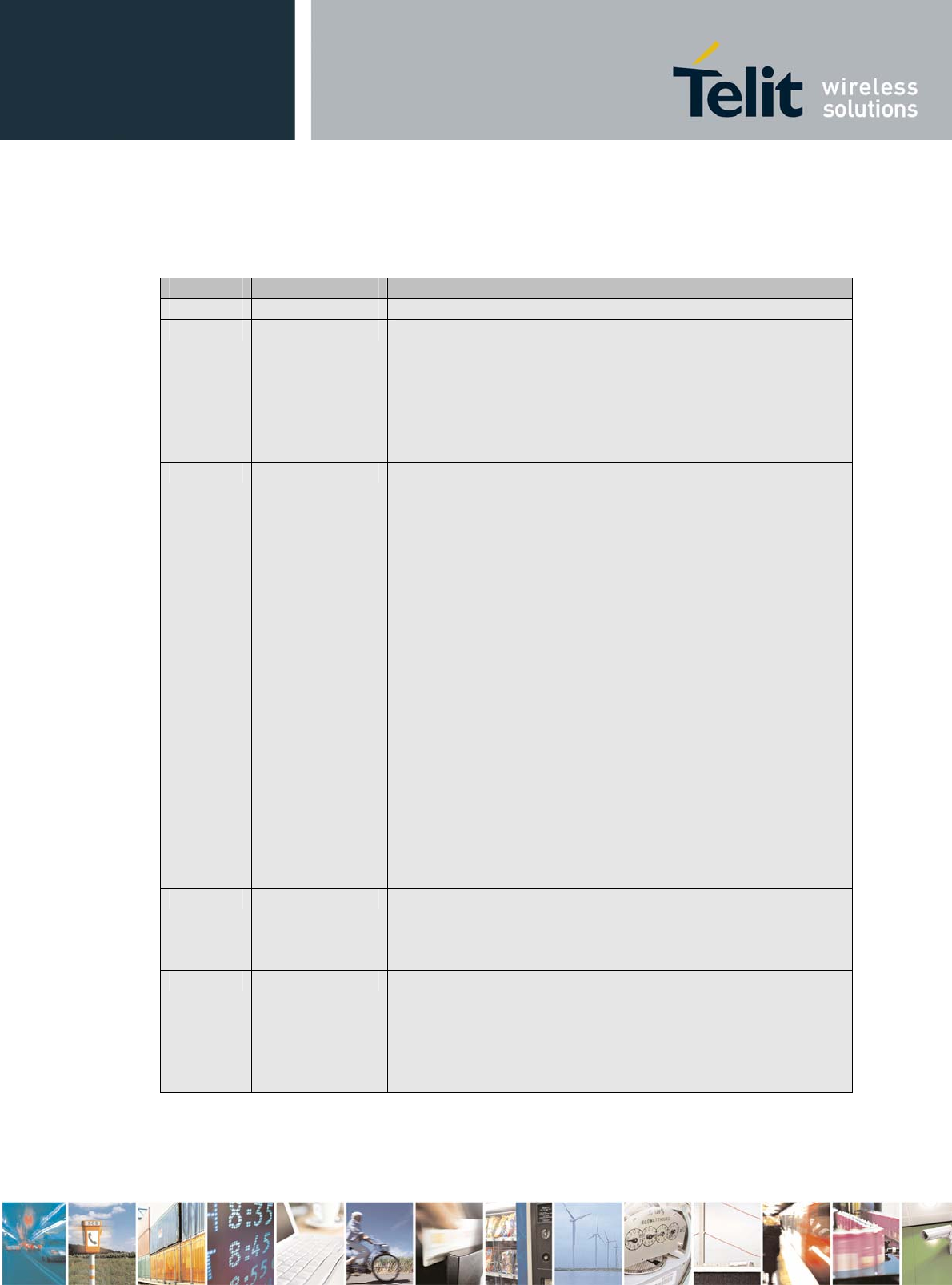
HC864-AUTO Hardware User Guide
1vv0300946 Rev.4 – 2012-12-27
Reproduction forbidden without written authorization from Telit Communications S.p.A. - All Rights
Reserved. Page 77 of 77
19. Document History
Revision Date Changes
0 2011-05-18 First issue
1 2011-07-07 Renumbered chapters
Added 2 General Product Description
Updated 5.1 Power Supply Requirements
Updated 5.2.2 Thermal Design Guidelines
Added 9 Audio Section
Added 13.1 Application PCB layout
Added 13.2 Clearance Area
2 2012-01-25 Renumbered chapters
Changed model name from HC864 to HC864-AUTO
Updated 3 HC864-AUTO Module Connections
Updated 3.2 Antenna Connector(s)
Updated 5.1 Power Supply Requirements
Updated 5.2.1.2 + 12V Input Source Power Supply Design
Guidelines
Updated 5.2.2 Thermal Design Guidelines
Updated 6 Antenna(s)
Updated 7 Logic Level Specifications
Updated 10 USB Port
Updated 11 General Purpose I/O
Updated 11.1 Logic Level Specifications
Updated 11.4 Using the Alarm Output GPIO6
Updated 11.5 Using the Temperature Monitor Function
Updated 11.8 VAUX1 Power Output
Updated 12 DAC and ADC Section
Added 13 Accelerometer
Updated 14.2 Clearance Area
Updated 15.4 EMC recommendations
Added 15.5 Download Debug Port
3 2012-10-31 Updated 3.1 PIN-OUT
Updated 10 USB Port
Updated 15.2 Bypass capacitor on Power supplies
Updated 15.4 EMC recommendations
4 2012-12-27 Updated 6.1 GSM/WCDMA Antenna Requirements
Updated 6.2.2 RX Diversity Antenna Requirements
Updated 6.3 GSM/WCDMA Antenna - Installation Guidelines
Updated 6.4 GPS/GNSS Antenna - Installation Guidelines
Added 17.1 1999/5/EC Directive
Added 17.2 FCC/IC Regulatory notices